« May 2007 | Main | July 2007 »
June 29, 2007
A Virtually New Web
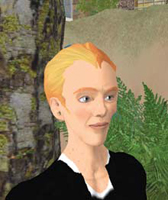
"Anarchic Openness" Reaps Massive Results
Jason Pontin, Technology Review's editor in chief, introduces and reflects on "Second Earth," the piece by contributing editor Wade Roush that is the July/August issue of the magazine's cover story in this video. Pontin argues that the extraordinary success of virtual worlds, such as Linden Lab's Second Life, and mirror worlds, such as Google Earth, can only partly be explained by new technologies including cheaper bandwidth, graphics cards, and free storage. Much more important was the decision of Linden Lab and Google to support an anarchic openness within their cyberworlds. Both companies have turned over control to users: any user can add almost anything to either environment. This decision has made Second Life and Google Earth into collaborative social communities with millions of registered users. [via]
Posted by jo at 03:24 PM | Comments (0)
Wikipedia in Second life
Feedamass, the “know-it-all” sidekick that fetches information to nearly any device, functions in virtual spaces, Second Life, for instance. A script sends a search query from Second Life chat to Wikipedia, and back in-world as a silent message to the user. It's all contained in a ring worn on your finger ... [via New World Notes]
Posted by jo at 03:03 PM | Comments (0)
Britannica vs Wikipedia
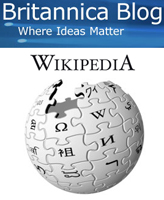
Michael Gorman + danah boyd
"Perhaps this view of an emerging collective human consciousness is ... if it is put forward seriously, it is antihuman and intellectually debasing. The structures of scholarship and learning are based on respect for individuality and the authentic expression of individual personalities. The person who creates knowledge or literature matters as much as the knowledge or the literature itself ... An encyclopedia (literally, the “circle of learning”) is the product of many minds. It is not the product of a collective mind. It is an assemblage of texts that have been written by people with credentials and expertise and that have been edited, verified, and supplied with a scholarly apparatus enabling the user to locate desired knowledge. It differs in almost all relevant particulars from one of the current manifestations of the flight from expertise—Wikipedia, which bills itself as “the free encyclopedia that anyone can edit” and to which everyone can contribute irrespective of whether they possess, or simply pretend to possess, credentials and expertise..." Web 2.0: The Sleep of Reason, Part II by Michael Gorman, Britannica Blog.
" ... The Internet - and Wikipedia - change the rules for distribution and production ... It means that individuals who know something can easily share it, even when they are not formally declared as experts. It means that those with editing skills can help the information become accessible, even if they only edit occasionally. It means that multi-lingual individuals can help get information to people who speak languages that publishers do not consider worth their time. It means that anyone with an Internet connection can get access to information traditionally locked behind the gates of institutions (and currently locked in digital vaults).
Don’t get me wrong - Wikipedia is not perfect. But why do purported experts spend so much time arguing against it rather than helping make it a better resource? ... While there are certainly errors there, imagine what would happen if all of those who view themselves as experts took the time to make certain that the greatest and most broad-reaching resource was as accurate as possible ... Why are we telling our students not to use Wikipedia rather than educating them about how Wikipedia works? Sitting in front of us is an ideal opportunity to talk about how knowledge is produced, how information is disseminated, how ideas are shared ...
The society that (Dr. Gorman) laments has lost faith in the public good ... Wikipedia is a public-good project. It is the belief that division of labor has value and that everyone has something to contribute, if only a spelling correction. It is the belief that all people have the inalienable right to knowledge, not just those who have academic chairs. It is the belief that the powerful have no right to hoard the knowledge. And it is the belief that people can and should collectively help others gain access to information and knowledge." Knowledge Access as a Public Good by danah boyd.
Posted by jo at 02:17 PM | Comments (0)
Nick Bostrom
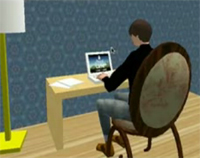
Are you Living in a Computer Simulation?
ABSTRACT: This paper argues that at least one of the following propositions is true: (1) the human species is very likely to go extinct before reaching a “posthuman” stage; (2) any posthuman civilization is extremely unlikely to run a significant number of simulations of their evolutionary history (or variations thereof); (3) we are almost certainly living in a computer simulation. It follows that the belief that there is a significant chance that we will one day become posthumans who run ancestor-simulations is false, unless we are currently living in a simulation. A number of other consequences of this result are also discussed. Are you Living in a Computer Simulation? by Nick Bostrom, Department of Philosophy, Oxford University.
"Why the Matrix? Why did the machines do it? (Human brains may be many things, but efficient batteries they are not.) How could they justify a world whose inhabitants are systematically deceived about their fundamental reality, ignorant about the reason why they exist, and subject to all the cruelty and suffering that we witness in the world around us?" From Why Make a Matrix? And Why You Might Be In One: by Nick Bostrom.
Also see: Simulism is a concept that deals with the possibility that we are living in a simulation.
Posted by jo at 11:37 AM | Comments (0)
Double Skin/Double Mind
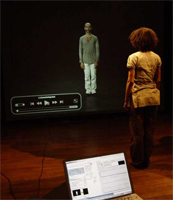
Experience a workshop, virtually
The interactive installation version of Double Skin/Double Mind will preview at Beeldmedia Studio, Amsterdam School of the Arts, Jodenbreestraat 3 on June 29 + 30 from 16:00-20:00.
Double Skin / Double Mind is a virtual version of the Double Skin / Double Mind workshop. This workshop, which has been taught by dance company Emio Greco | PC since 1996, represents the basis of the creative work of choreographers Emio Greco and Pieter C. Scholten. Participants in this workshop are challenged to discover new interpretations of their dancing body.
Throughout 2006 an interdisciplinary research group, consisting of dance notators Eliane Mirzabekiantz and Marion Bastien, motion capture researcher Fridiric Bevilacqua, cognitive neuroscientist Corinne Jola, media artist Chris Ziegler, cinematography Maite Bermudez, artistic research processes Scott de Lahunta and EG | PC researcher Bertha Bermudez, has been focusing on this specific workshop trying to analyse and document it.
The different data from each research area have been collected, and interactive graphic visualisation tools and motion capture were re-implemented to create this preview of the Interactive Installation Double Skin / Double Mind. The current installation offers participants the possibility of taking part in a virtual version of the workshop in real time, while receiving verbal, physical and peripheral information. By following a life size moving figure, the participants will recognize, compare and understand their actions and involvement in the practice of this workshop. They will travel through the Double Skin / Double Mind structure in a mental and physical way, experiencing what the different layers are.
Concept and realization: Chris Ziegler (ZKM Karlsruhe), Fridiric Bevilacqua (IRCAM, Paris), Bertha Bermudez (Emio Greco | PC)
Co-production with: Amsterdams School of the Arts, research group Art Practice and development, Marijke Hoogenboom
With thanks to: Maite Bermudez, Katharina Pohlmann, Eliane Mirzabekiantz, Marion Bastien, Corinne Jola, Nederlands Instituut voor Mediakunst / Montevideo, Scott deLahunta, Jeroen Fabius, Paul van der Ploeg, Cinedans and the EG | PC team
Project supported by: Prins Bernhard Cultuurfonds
Emio Greco | PC receives funding from: the Dutch Ministry of Education, Culture and Science and from the Dutch Fund for Amateur Art and Performing Arts.
contact: berthabermudez]at]egpc.nl
Chris Ziegler
mobile +49172 89 56 328
http://www.movingimages.de
Posted by jo at 11:05 AM | Comments (0)
June 28, 2007
The $20,000 Question:
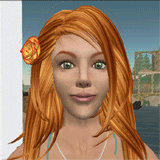
Are we witnessing ... the emergence of a global mind?
An emergent property by definition cannot be achieved with a centralized system and the degree of emergence required to achieve a suitably complex evolved culture can only happen in a dynamic environment that is shaped by the populace. This essential quality is built into the very concept of reality, as defined by LL. ‘The thing we concluded is that something is only real if you can change it. If there’s a pixel on the screen in front of you in SL, and you can’t alter it, then why would we put it there?’
Does the name Mitch Kapor sound familiar? If you are interested in the history of SL, the answer may well be yes, because he was one if LL’s earliest investors. “Mitch Kapor was the only person who got it”, said Rosedale in an interview with Inc. Magazine.
Personally, Mitch Kapor first came to my attention through an essay of his, published in 2002 on Kurzweilai.net. As with LL and SL, Kapor was putting money forward in anticipation of a future outcome, but this time the money was riding on a failure, not success. The bet centred on a question: Will the Turing Test be passed by a machine by 2029? Ray Kurzweil said ‘yes’, Kapor said ‘No’ and whoever loses will donate $20,000 to a charity selected by the winner.
In his essay, Kapor explained why he was sceptical of the possibility that a machine will ever pass the test. ‘To pass the test, a computer would have to be able of communicating via this medium (text) at least as competently as a person. There is no restriction on the subject matter…It is such a broad canvas, in my view, that it is impossible to forsee when, or even if, a machine intelligence will be able to paint a picture which can fool a human judge’. Kapor further elaborated on why a computer can never mimic a person, but what struck me as I reread this essay recently was this: Just possibly, SL may prove to be a crucial link in the enabling technologies of human-like intelligence.
What will it take to build a machine that you can chat with as if it were a person? Decades of research into question has yielded three vital requirements. Power, Organization, and Education. The first requirement, power, means building hardware that matches the computational capacity of the human brain. If you have a top-spec PC, then you have at your disposal something with the equivilent brainpower of a fish — a millionfold too weak to do the job of a human brain (which Moravec estimates at 100 million MIPS). Actually, it is not the case that you don’t have access to a ‘computer’ capable of matching the raw power of the brain, especially if you connect to SL. As Rosedale explained to Tim Guest, ‘the combined computational capacity of the aggregate SL grid, running 24 hours a day as it does now, is in excess, by almost any measure, of at least one human brain at this point in time’. Of course, it would be a waste of resources to use the grid simply to simulate ONE human, when it can instead be used to run a virtual world harnessing the creative powers of tens of thousands of real people at any particular moment.
In any case, the second requirement (organization) refutes the possibility of the SL grid ‘waking up’ to self-consciousness. It’s not sufficient to simply match the 100 million MIPS of a human brain, but also to understand how the brain is organized, how it processes information. Thanks to functional brain imaging, we are beginning to understand how this organ differs to a computer, and the field of neuomorphic modelling is focused on building hardware and software that is ‘functionally equivilent’. Currently, brain imaging only hints at the underlying principles of human intelligence, it is not yet capable of following the actual information being transformed in realtime. Also, as mentioned above, we currently lack the raw power needed to model all several hundred regions, at least not on any computing system whose precious resources are not better used in other areas. What we have achieved so far, is to develop highly detailed mathematical models of several dozen of the several hundred types of neurons in the brain. Researchers have connected artificial neurons with real neurons from spiny lobsters, and found that this hybrid biological-nonbiological network performed in the same way, and produced the same type of results as, an all-biological net of neurons. Combining neuron modelling and interconnection data obtained from brain scanning has enabled science to reverse-engineer more than two dozen of the several hundred regions of the brain. Again, in some cases, the neuromorphic models have been connected to real brains. In 2006, researchers built a chip that mimicked a section of rat hippocampus. The real section was removed, the artificial replacement wired in place, and it restored function with 90% accuracy.
Given that brain imaging tools are increasingly improving, and computers are getting more powerful, there is no reason to suppose that we cannot reverse-engineer every neuron, every region, and so build an entire brain. And contemporary examples of hybrid networks make for a curious thought-experiment. What if we were to remove a neuron from Mitch Kapor’s brain, and put in its place its neuromorphic twin? If the artificial neuron sends and receives information just like its biological predecessor did, it seems hard to argue that Kapor’s behaviour would be affected. Now suppose that, step by step, his entire brain is replaced. Remember, we have already partially performed this experiment on rats and retained function with 90% accuracy. Subsequent generations of chips are likely to close the gap and creep towards 100%. So, hypothetically, if we systematically replace Kapor’s brain, ensuring at every step that the hybrid biological/nonbiological net is behaving normally, Kapor would retain the abilities we associate with human intelligence. But if we keep going, ultimately ALL the biological brain will have been replaced. Where once there was a brain there is now an astonishingly complex machine. Equally, instead of replacing a pre-existing organic brain we could just build a neurmorphic model and install it in a robot with appropriate sensors that feed information to it corresponding to sight, touch, smell and taste. Why would this robot- this machine- not be capable of behaving like a real person? We could, after all, replace each part of Kapor with an artificial version; a robotic eye, a robotic limb, a robotic heart, and so on until he is 100% artificial. You could perhaps argue he is no longer ‘human’ (though I defy you to pinpoint the exact point where humanity was lost) but Kapor could argue quite convincingly that he is a person, and deserves to be treated as such. Why would a robot built from the same parts not also be able to argue its case?
You could answer that by asking this: Can a one year old baby pass a Turing Test? The answer is clearly no, because a baby has yet to develop the capabilities associated with human intelligence. To be sure, some functionality is ‘hard-wired’ into our brains from birth, but so many more only develop as the baby spends years interacting with reality. The same thing would apply to our robot. We should not expect to build it, turn it on, and expect it to immediately engage us in conversation about the music of Proust or the price of sprouts. No, we will have to provide the third requirement: Education.
It is this requirement that Kapor is betting will fail. ‘Part of the burden of proof for supporters of intelligent machines is to develop an adequate account of how a computer would acquire the knowledge it would be required to have to pass the test…I assert that the fundamental mode of learning is experiential…most knowledge, especially that having to do with physical, perceptual and emotional experience is not explicit, never written down…the Kurzweil approach to knowledge acquisition (he argued that the AI would educate itself by ‘reading all literature and by absorbing the knowledge contained on millions of websites’) will fail’.
Kapor argues that human beings are embodied creatures, grounded by our physicality and in many ways defined by it. This logically leads to the observation that there is an intimate connection with the environment around us. ‘Perception and interaction with the environment is the equal partner of cognition in shaping experience’, he reasoned. The qualities we associate with human intelligence were shaped by evolution, but for humans there is another form of heredity to consider, along with natural selection of genetic information. That additional form is ‘culture’. Our social networks evolved the rules that define common sense and artistic sensibilities, never written down but nevertheless transmitted from mind to mind. We can therefore identify a crucial step in achieving Turing AI; the construction of an ambitious ‘laboratory’, consisting of an entire environment in which a network of social and cultural relationships can grow almost from the ground up. Of course, we have many such laboratories already, for as Edward Castronova explained, ‘we have real human societies that grow up on their own within computer-generated fantasy worlds’.
There is a pretty sound argument, championing SL above the likes of ‘World of Warcraft’. Yes, WOW has a greater population (though for how much longer is open to question) but it does not have the degree of self-organization we see in SL. It is a mistake to think evolution is only a means of shaping life to fit its environment, because the environment is shaped by the presence of life. Both are in a state of constant change. An emergent property by definition cannot be achieved with a centralized system and the degree of emergence required to achieve a suitably complex evolved culture can only happen in a dynamic environment that is shaped by the populace. This essential quality is built into the very concept of reality, as defined by LL. ‘The thing we concluded is that something is only real if you can change it. If there’s a pixel on the screen in front of you in SL, and you can’t alter it, then why would we put it there?’
This may run counter to many people’s concept of reality. After all, my belief in the objective reality of the sun (for example) is based on the observation that it remains as it is, no matter what my whims may be. But the immutable and the alterable are not so separate as they seem. The fixed laws of the universe are what make creativity possible, because total chaos makes learning an impossibility. The Lindens could demonstrate this. If the behaviour of prims randomly changed each day, to the extent that nothing you learned today was applicable tomorrow, creativity of any meaningful mind would not be at all feasible.
Of course, the Lindens recognise the importance of stability. ‘We are trying to create a close reproduction of the actual, physical world we live in — one that will easily be comprehensible and useful to us because it so closely resembles ours’. If, as Kapor suggests, part of the essential component of human-equivilent AI is to be intimately connected to an environment, our collaborative efforts to build exactly that can reasonably seen as a step in the right direction.
But, why bother building a simulated world when there is a real one ready to go? Why not build physical robots interacting with real people, as opposed to bots conversing with avatars? Well, a virtual world has an advantage in that everything can, in principle, be recorded. Given that the entire world is computer-modelled, it is technically possible to record every movement, gesture, and interaction that takes place. This could be advantageous for scientists wishing to ‘download’ patterns of information ‘never directly expressed’ so that our infant AI can acquire a knowledge of human experience that occurred in the past but was tacit.
Another advantage of growing AI in a computer-modelled world is that it puts both ‘artificial’ and ‘real’ people on more of an equal footing. Indeed, this is a requirement of the Turing Test; prejudging personhood by observing who is the robot and who is the human violates the rules. An avatar controlled by a person you cannot see (or is the avatar under the control of AI?) is more in keeping with the conditions of the test. Another sense in which the playing field is levelled is that both ‘bot’ and ‘avatar’ are in a more basic state of learning about the social rules appropriate to their environment. We are, in a cultural and artistic sense, both ‘children’ learning through trial and error.
But while projects like ‘Neufreistadt’ are fascinating studies in the emergence of governance, it could be argued that such systems require a higher-order internationality beyond the capability of an infant’s mind to model. Worlds like SL develop from a more basic level than the modern society we are born into, but perhaps not quite basic enough to evolve higher-order internationality (a theory of mind, in other words) from scratch. In the sci-fi novel ‘Accelerando’, Charles Stross attributes consciousness to ‘a product of an arms race between predator and prey’. More precisely, a product of a mind’s ability to model behaviour. The hawk runs an internal simulation of its prey’s likely behaviour, calculating the direction it will run when it senses danger. The sparrow, meanwhile, uses its model of the hawk’s mind to calculate its likely attack strategy and execute an effective evasion. Natural selection weeded out the less-effective theories of mind, until for certain genes survival required cooperation among ‘a species of ape that used its theory of mind to facilitate signalling — so the tribe could work collectively — and then reflexively, to simulate the individuals own inner states’.
Stross attributes human-level consciousness to a paring of signalling and introspective simulation. Can a simulated world evolve a theory of mind from the ground up? That is a question being explored by ‘New and Emergent World models Through Individual, Evolutionary and Social learning’ — NEW TIES. The project, which brings together a consortium of researchers in AI, language evolution, agent-based simulation and evolutionary computing, seeks to use grid computing to model an environment inhabited by millions of agents, each one a unique entity with characteristics including gender, life expectancy, fertility, size and metabolism. Sexual reproduction will be possible, with agents able to reproduce and their offspring inheriting a random selection of their parents ‘genes’. Also, by pointing to objects and using randomly generated ‘words’, the project hopes to develop culture, which it defines as ‘knowledge structures shared among agents that reflect aspects of the environment, including other agents’.
In summary, the NEW TIES project states, ‘we will work with virtual grid worlds and will set up environments that are sufficiently complex and demanding that co-operation and communication is necessary to adapt to given tasks. The population’s weaponry to develop advanced skills bottom-up consists of individual learning, evolutionary learning, and social learning (which) enables the society to rapidly develop an understanding of the world collectively. If the learning process stabilizes, the collective must have formed an appropriate world map’.
Such work cannot help but provoke questions about our own existence. Here, we have patterns of information that will (it’s hoped) organise into structures capable of introspection and communication. What, then, are we humans? Patterns of matter and energy evolving in the ‘real’ universe…or are we too information running as part of a simulation built by lofty intelligences, curious about us because they are curious about their origins? Are our avatars brave pioneers of the ‘Third Life’, rather than the second?
And what place does SL occupy in the grand scheme of things? Evolution was using co-operation long before culture developed. A single-celled organism is a vast society of chemicals. An animal is a vast society of cells. Our modern cities are a vast society of animals. Philip Rosedale forsees the metaverse as the next logical step in the emergence of a single entity consisting of a society of interdependent agents. ‘We think a lot about the nature of the brain, and whether computational substrates can be dense enough to enable thinking within them. I know exactly how that’s going down, I think… SL is dreaming. It could be looked at as one collective dream. In an almost neurological sense’.
Are we witnessing the early stages of the emergence of a global mind? Will the TCP/IP nodes of the internet evolve into functioning neurons, resulting in a free-thinking entitity capable of introspecting upon all human knowledge? And if its immense computational prowess dreams of imaginary people, will they wonder about a Creator, and try to reconcile their beliefs with an increasing understanding that the ‘rules’ of their universe evolve complexity from the bottom-up? More importantly, will this happen by 2029? Will Mitch Kapor lose his bet, thanks to the ‘collective dream’ of the Metaverse?
Perhaps we should not use terms like ‘winners’ and ‘losers’ here. Perhaps SL and its successors will not help develop general artificial intelligence, but it already showcases the marvellous abilities of people that Kapor so eloquently expressed in his essay. Read it for yourself, and then dive into SL to see for yourself what we can do with our collective mind. -- The $20,000 Question: An Essay by Extropia DaSilva. Related.
Posted by jo at 03:57 PM | Comments (0)
Mediated: How the Media Shapes Your World and the Way You Live in It

On Real and Unreal Time
"(W)e are living a fusion of real and unreal time, an ongoing undulation of overlays and intersections...It's most like the way good old-fashioned thinking and imagining work in relation to sensing and perceiving ... It says that back before representational technologies developed, before literacy itself, people were also living in a fusion of real and unreal time because they were daydreaming while they were doing this or that. Just having a mind is to be in unreal time as well as in real time ... What that says is that representational technologies have colonized our minds ... To the extent that our thoughts no longer wander around on their own, stocked only with materials drawn from direct experience, to the extent that they follow flows of representations instead--to just that extent that we don't think our own thoughts. Literally...
When the term first arose, "real-time" implied speed, intensified velocity. The medium doing the representing was transforming reality into representation immediately. The expression was first used in connection with digital processing of information ... It was a term of praise that focused on how fast a computer could record the file transaction as compared with paper-shuffling clerks. It wasn't until the fact that computers could keep up with events was taken for granted that we noticed that security cameras in public places were real-time media too. And nothing seems slower than those! How strange. Why is that? No editing. No manipulation of what is presented.
In the same way, an innovation like videoconferencing could surprise us with a real-time capacity that the telephone had all along. Bit we only noticed that a lot of analog media were in real time after computers achieved sufficient processing speed to do it too. It was the malleability of digital transformations that made the difference. The fact that we could now manipulate what had once just been conveyed on a screen or over a wire, that's what go the juices going. That's why "interactive" became the mother of all buzz words. The idea that real time emerged when we became players on screens we had once viewed passively. The fusional loop of subject-object that is a video games expresses most cogently the thrill of real-time existence in unreal realms. You tweak the joystick and press the buttons and virtual swords flash and machine guns blaze in some tunnel on asteroid in a distant galaxy--not as a result of, but as a function of, at the same time as, your fingers on the console. You exist as agent and instrument simulateously in two places, in the meat world of fingers and consoles and the virtual world of cyborg warriors. Representational being incarnate. The primordial aim of the human imagination realized--literally "made real.
So "real time" is a compliment we pay to representations that reflect our agency either directly or in the way they conform to our designs subsequently ... Incidentally, remember when people thought that the Web was going to build bridges between communities and inspire cross-cultural understanding, etc.? ... The multiplication of niches has been so intense that the word fragmentation doesn't begin to describe it. What with these search worms and filters and custom advertising hooking you up with stuff you're already interested in ... you can spend your whole life online and never leave your own head." From Mediated: How the Media Shapes Your World and the Way You Live in It by Thomas De Zengotita.
Posted by jo at 03:14 PM | Comments (0)
A Theatre Without Theatre
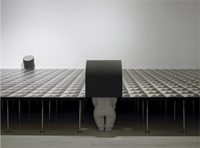
The Links Between the 'Experience of the Senses' and 'Action'
A Theatre Without Theatre :: until September 11, 2007 :: Museu d'Art Contemporani de Barcelona, Placa dels Angels, 1, 08001 Barcelona :: Curators: Bernard Blistène and Yann Chateigné, with the collaboration of Pedro G. Romero :: Co produced by: Museu d’Art Contemporani de Barcelona (MACBA) and Museo Berardo in Lisbon.
A Theatre Without Theatre explores the metaphors in which the influences of the theatre model made themselves felt in the arts of our times throughout the 20th century. This exhibition brings together more than 800 works, including paintings, sculptures, installations, drawings, photographs, videos, manuscripts and various other types of documents.
The exhibition reflects on the condition of the subject in contemporary society and on the links between the 'experience of the senses' and 'action'. At the same time, it considers the dramatic roots of art as a constituent element of western modernity: from Vsevolod Meyerhold to Oskar Schlemmer, from Antonin Artaud to Judith Malina and Julian Beck (founders of the Living Theatre company), from Samuel Beckett to Tadeusz Kantor, the theatre has been a wellspring of ideas and theories that have been absorbed by art, becoming models of the aesthetic and spatial relationship. Art could, to a certain extent, be 'the other stage' of dramatic practice.
A wide range of approaches to the notion of drama and the points of convergence between an 'archaic' art and aesthetic innovation and the break with the past are presented in various fields of research in this exhibition, which reveals the artists and the themes common to both the theatre and art. The exhibition is not structured to show a pattern of evolution over time but instead centres on various core areas of analysis in which the genealogies and influences from the early 20th century are set out.
The theatre stage is a space isolated from the real world and hence is fictitious (though not false). It is perhaps this separation -- the distance between the actor and the audience member -- that enables the theatre to serve as a critical model as regards the 'apparent' and to use its full weight to facilitate the circulation of ideas. The 20th century was a period when the theatre got caught up in a process of transformation that eventually came to affect the roots of western culture as a whole and art in particular.
From the mid-1960s onwards, the notion of theatricality was a prominent element in contemporary art criticism. Minimalism was initially regarded as harmful and thought likely to destroy art as it had been known till then. Michael Fried, the American critic, railed against it in his famous essay Art and Objecthood (1967) on the grounds that it proposed a relationship between the work and the spectator that could lead the space of the artwork to absorb the viewer. The artists of the generation immediately after Minimalism appropriated the theatre model in order to create a core from which the foundations underpinning the contemporary could extend outwards. These foundations were the simultaneity of action and perception in the arts and the constant swapping of roles between actors and audience.
In the early 20th century, Dada, Futurism and Constructivism clearly expressed the close bond between aesthetic renewal and the theatre model. Cabaret, music hall, soirées or social gatherings, declamation and reading became modes of presenting active art for many artists after 1916. Playwrights such as Antonin Artaud and Samuel Beckett have been regarded as the true founders of artistic approaches and practices that go beyond the mere quotation.
A THEATRE WITHOUT THEATRE begins with the confrontation between the invention of Minimalism --with works by Carl André, Robert Morris and Donald Judd-- and its rejection and refutation by the following generation -Dan Graham, Bruce Naumann, Marcel Broodthaers, James Coleman and Michelangelo Pistoletto-. In the works of these latter artists, it is possible to see the importance of the text and the 'set' and to appreciate the need for a new attitude on the part of the audience, which is sometimes directly addressed and always questioned during the act of perception.
A THEATRE WITHOUT THEATRE is complemented by the research of Pedro G. Romero into the relationship between art and the theatre model in Spain: works by Federico García Lorca, Ramón Gómez de la Serna, Helios Gómez, Antonio Miralda, the Teatro Estudio Lebrijano Company and Ocaña, among others, are featured in the various sections of the exhibition.
Posted by jo at 11:53 AM | Comments (0)
June 27, 2007
Sentient World Simulation
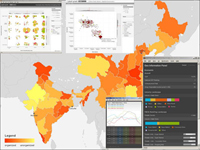
War Games on the Grandest Scale
"Perhaps your real life is so rich you don't have time for another. Even so, the US Department of Defense (DOD) may already be creating a copy of you in an alternate reality to see how long you can go without food or water, or how you will respond to televised propaganda. The DOD is developing a parallel to Planet Earth, with billions of individual "nodes" to reflect every man, woman, and child this side of the dividing line between reality and AR.
Called the Sentient World Simulation (SWS), it will be a "synthetic mirror of the real world with automated continuous calibration with respect to current real-world information", according to a concept paper for the project. "SWS provides an environment for testing Psychological Operations (PSYOP)," the paper reads, so that military leaders can "develop and test multiple courses of action to anticipate and shape behaviors of adversaries, neutrals, and partners".
SWS also replicates financial institutions, utilities, media outlets, and street corner shops. By applying theories of economics and human psychology, its developers believe they can predict how individuals and mobs will respond to various stressors. Yank a country's water supply. Stage a military coup. SWS will tell you what happens next." Continue reading Sentient world: war games on the grandest scale by Mark Baard.
Posted by jo at 04:05 PM | Comments (0)
The Present Group presents
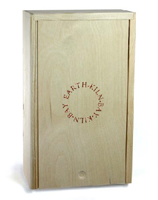
Earth-Kiln-Bay-Kiln-Bay
Land Art Performance meets the digital world. Artist’s work presented online for the public to experience: The Present Group, a quarterly art subscription service, unveiled an interactive online version of Earth-Kiln-Bay-Kiln-Bay today. For his piece (the second edition of The Present Group) artist Presley Martin collected weathered bricks from a beach in Berkeley, CA. To insert himself into the process, Martin glazed and fired these cast-offs before returning them to the beach and arranging them in a simple circular form. As the tide rose and fell, the waves of the San Francisco Bay continued to weather and re-distributed the bricks. With the help of The Present Group and the United States Postal System, the bricks continue their journey around the country, each stage collected and re-presented to the homes of TPG subscribers. Emily Kuenstler sums up the work in her statement,
“I find Martin’s work especially relevant to the times in which we now live. While the seriousness of world events and crises require daily reckoning with meaning, reclaimed objects inherently illicit new meanings, recontextualized. Rethinking where we have been as a society—and how we have gotten here—is crucial; doing so in a pure, considered aesthetic gesture is restorative.”
An interactive, digital version of the work, with video documentation of Martin’s performance, is now available for the public online, along with an interview, critique, annotated links to other resources, and a discussion of the work.
A New Way of Supporting Contemporary Art: Subscription Art
The Present Group’s quarterly subscription model is a new approach to funding artists while expanding the base of art lovers and collectors. TPG aims to de-mystify the art world one piece at a time, by interviewing the artist, commissioning critics to help subscribers contextualize the work, and by providing a free online resource and discussion area built around each piece. Subscribers can learn about and absorb each piece at their own pace, in the comfort of their own homes, without the intimidation factor of a gallery or museum. As Oliver Wise, co-founder of The Present Group, points out, “It’s the most current contemporary art class you can take.”
For more information contact: Oliver Wise – oliver[at]thepresentgroup.com
Posted by jo at 01:43 PM | Comments (0)
CADAVRE EXQUIS CARTOGRAPHY (C.E.C.)
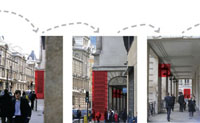
Urban Game & Mapping Exercise
FRIDAY SESSION 18 :: CADAVRE EXQUIS CARTOGRAPHY (C.E.C.); An urban game & mapping exercise followed by Talks from Dr. Maria Kaika and Julie Myers :: June 29, 2007; 6.30 pm :: Outside Bank Tube station - Take the 'Cornhill North' exit and meet us on the square outside the Royal Exchange, corner of Threadneedle St. and Cornhill :: Bring: a digital camera with its download equipment (Cables!), so we can download the images after the walk at Public Works and team-mates.
CADAVRE EXQUIS CARTOGRAPHY prompts people to explore and collect ground-level images of the City. Walks will be followed by two short talks at the public works studio at 8pm. Dr .Maria Kaika of Oxford University will talk on the continuously changing development of the City of London. Julie Myers will present - To travel Somewhere - a mobile phone / mapping project developed from a series of walks in San Francisco, USA, Cambridge, UK and Helsinki, FIN.
CADAVRE EXQUIS CARTOGRAPHY is played in pairs sharing one digital camera with display screen. Player 1 starts by taking a picture with a designated building or object in the frame as well as a second object / building of any kind. After handing over the camera to player 2, both leave the first photographed object behind, moving towards the second element of the shot. Player 2 now takes a picture with this building / object in the frame, but again with something else in the background or foreground, which will be the linking element in the next image. The camera is then handed over to player 1, who takes the next photo of the series.
THE AIM OF THE GAME IS TO COVER AS MUCH GROUND AS YOU CAN.
THE RULES:
1. A team is only allowed 30 shots and 1 camera per walk, so SHOOT CAREFULLY!
2. Images have to overlap physically and can only be of ground level building or object, so DON'T SHOOT IN THE AIR!
3. Only take images of objects/buildings in front of the team so SHOOT FORWARD!
All images will be assembled online and will allow visitors to wander through the City from behind their computer.
Maria Kaika holds a D.Phil. in Geography from the University of Oxford, and an MA in Architecture from the National Technical University of Athens as well as professional qualifications as an architect. Her previous posts include: Director of Studies in Human Geography at St Hugh's College, Oxford, Departmental Lecturer at the School of Geography, Oxford, Junior Research Fellow at Linacre College, Oxford, Lecturer in Human Geography at St Peter's College Oxford.
Dr Kaika's research focuses on urban theory, and more specifically on the politics and culture of architectural technology and design and on urban political ecology. Collaborative projects include work on: urbanism and culture; modernist urbanism and nature; urban environmental history; representations of nature and the city; governance and environmental policy; European environmental policy; theoretical approaches to sustainability; political ecology of water supply in western cities.
Julie Myers is an artist who's practice is informed by social encounter and intervention. Her work investigate memory, gesture and narrative in relation to physical environment. Sometimes recording just a brief moment captured between strangers and at other times building sustained relationship with multiple participants over a sustained period of time. She uses film/video, mobile technologies and database formats to document and present material that exists both on the web and in site specific or exhibition space.
Julie is a senor lecturer at Middlesex and Kingston Universities and lives in London. She has exhibited and screened work extensively receiving a number of awards including an AHRB research award and an Erasmus Scholarship. Previous work has been commissioned by The Arts Council of England, NESTA, The BFI, The Institute of Contemporary Art, BAA and the National Portrait Gallery. Julie has recently completed a placement at Adobe in San Francisco as part of the ACE interact program.
public works
Northgate House
2-8 Scrutton Street
UK London EC2A 4RT
Click here to view map
For more information email Jim[at]citymined.org or andreas[at]publicworksgroup.net
Posted by jo at 12:56 PM | Comments (0)
Tina Gonsalves' "Feel_Insula"
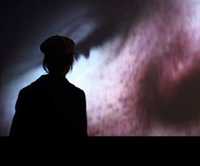
Stillness, Emotions and Hypnosis
Tina Gonsalves' Feel_Insula: An interactive Installation about Stillness, Emotions and Hypnosis :: At New Greenham Arts, The Corn Exchange, 113 Lindenmuth Way, New Greenham Park, Newbury, Berks, RG19 6HN UK :: Preview: Sunday 1 July 2007 12-2pm :: From June 28 - August 3 :: 10am-5pm; Thursday (10am-8pm; Saturdays by appointment).
Feel.Insula is an intimate and vulnerable responsive video installation driven by the stillness of the audience. In a darkened space, a video is projected on the wall. It is of the artist under hypnosis. Under hypnosis, the artist is asked to re-experience potent emotional memories of her life. As soon as the viewer enters the space, the artist wakes up from hypnosis. Only after the audience is completely still does the video fall back into weaving the stories re-lived under hypnosis. FEEL_INSULA emerges from a collaboration between neuroscientist Dr Hugo Critchley and artist Tina Gonsalves, and was created over her artist in residency at the Institute of Cognitive Neuroscience at UCL, London.
Emotion expression databases such as Karolinska and Ekman databases are commonly used with in affective neuroscientific experiments. The artist started to question the validity of these performed emotions as stimuli. In the search for more authentic emotiona; expressions, she began working with Dr. David Oakley, the Director of the Hypnosis Unit at UCL. She asked Oakley to hypnotise her in order to re-experience different potent emotional memories. Over 3 one-hour sessions, Oakley induced her into states of fearfulness, sadness, happiness and calmness. Each session was recorded using two 3 chip digital cameras focused on the artists face and also radio mic and ipod recorder. These video and audio recordings formed the basis to FEEL_INSULA.
Tina Gonsalves (AU) is currently honorary artist in residence at the Wellcome Department of Neurology at University College London. Combining diagnostic imaging, biometric sensors and mobile technologies, her installations, films for television, and software investigate emotional signatures both within the body and among interactive audiences. Since 1995 her work has shown internationally at venues including Banff Centre for the Arts (CA); Siggraph (US); International Society for the Electronic Arts 2004; European Media Arts Festival; Institute of Advanced Media Arts and Sciences (JP); Australian Centre For Photography, Sydney; Barbican (UK); Pompidou Centre (FR), Institute for Contemporary Art, London; and Australian Center for the Moving Image, Melbourne. Her music videos for Universal, BMG, EMI, and Festival Mushroom Records have been televised worldwide.
Posted by jo at 12:42 PM | Comments (0)
Networks and Boundaries
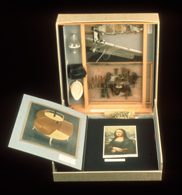
Call for Applications
Call for applications at the Getty Research Institute for the theme Networks and Boundaries. The Institute welcomes applications from established scholars, postdoctoral scholars, and predoctoral candidates, as well as writers and artists who wish to be in residence in 2008-2009 and whose projects explore cross-cultural exchange and the visual arts.
The study of the visual arts can and does cross cultural, civilizational, ethnic, religious, and geographic boundaries. Cultural exchange takes place through kaleidoscopic networks that are themselves dynamic and transformative. These exchanges are integral to the construction of boundaries, contributing to definitions of self and other. The contact zones within which they occur are marked by appropriations, hybridizations, and syncretisms-all of which remap cultural boundaries.
The study of the visual arts has its own networks and boundaries, including interdisciplinarity and divisions between national, area, and world histories. How freely have artists, art objects, and artistic concepts and practices moved across socio-political and cultural boundaries? And with what results? How closely do artistic crossings and their analyses map onto larger networks of power and economics? How do we negotiate the different demands of local cultural contexts with larger regional and/or global concerns?
Scholars in residence will find that the special collections of the Getty Research Library are especially rich in primary materials that bear upon this topic, ranging from nineteenth-century photographs by European travelers in Asia to the collection of the Association Connaissance de l'histoire de l'Afrique contemporaine (exploring the influence of French colonialism in Africa); from the papers of international architect Bernard Rudofsky to documentation of such global activities as Fluxus and mail art.
Eligibility: These grants are for established scholars, artists, or writers who have attained distinction in their fields. Applications are welcome from researchers of all nationalities who are working in the arts, humanities, or social sciences.
Grants For Scholars: Getty scholars are in residence for the entire academic year (from September 2008 to June 2009). A salary-replacement stipend is awarded equivalent to the applicant's current academic base salary, up to a maximum of $75,000. The grant also includes an office at the Getty Research Institute, research assistance, airfare to and from Los Angeles, an apartment in the Getty scholar housing complex, and health benefits.
Grants For Visiting Scholars: Visiting Scholars are in residence for a three- month term. A monthly stipend of $3,500 is awarded, prorated to the actual dates of residency. The grant also includes an office at the Getty Research Institute or Getty Villa, research assistance, airfare to and from Los Angeles, and an apartment in the Getty scholar housing complex.
Application Availability and Deadline: Completed application materials must be received in the Getty Foundation office on or before November 1, 2007. We regret that incomplete applications, or late applications (those received after November 1, 2007, regardless of their postmark date or place of origin), cannot be accepted for consideration. Unfortunately, we cannot accept applications hand-delivered to the Getty Center or those sent by e-mail or fax. Application material cannot be returned.
Posted by jo at 12:26 PM | Comments (0)
INTIMACY Across Visceral and Digital Performance
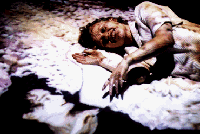
OPEN CALL FOR PAPERS, POSTERS & PERFORMANCES
“How are bodies represented through technology? How is desire constructed through representation? What is the relationship of the body to self-awareness?” [Stone, Allucquère Rosanne The War of Desire and Technology at the Close of the Mechanical Age Cambridge, Mass. & London: MIT Press, 1995, p. 17]
[Image from Paul Sermon's "Telematic Dreaming"] INTIMACY Across Visceral and Digital Performance is a three-day (December 7-9) interdisciplinary programme of events made to illicit connectivity, induce interaction and provoke debate between makers, participants and witnesses of works that explicitly address proximity and hybridity in performance. It will feature workshops, seminars, performances, posters, and a 1-day symposium. INTIMACY will employ digital and live art practices as agents, aiming to further practical exploration of and vibrant discourse into notions of intimacy in contemporary performance. It is framed as a forum for artists, scholars, community workers, performers, cultural practitioners, researchers and creative thinkers.
INTIMACY will provide a platform for the discussion of live art/performance practices concerned with displaying intuitive, intimate and visceral relationships between artist and other. It will explore performance practices that engage in intimate encounters, raising issues around bodies of data and flesh; presence as aura and representation; desire as embodied condition and disembodied fantasy; the human and posthuman self. Confirmed contributors include: Johannes Birringer, Kira O'Reilly, Tracey Warr, Janis Jefferies, Amelia Jones, Dominic Johnson, Kelli Dipple, Paul Sermon.
SPACETIME
INTIMACY will take place on the 7th, 8th and 9th December in and around Goldsmiths University of London, LABAN and The Albany (South London).
CO-DIRECTORS: Rachel Zerihan and Maria Chatzichristodoulou [aka maria x]
BOARD
Prof. Johannes Birringer, Chair in Drama and Performance Technologies, School of Arts,Brunel University of West London; Artistic Director of AlienNation Co.
Hazel Gardiner, Senior Projects Officer, AHRC ICT Methods Network; Researcher.
Dr. Adrian Heathfield, Principal Research Fellow (Performance and Live Arts), School of Art and Design, Nottingham Trent University; Writer; Curator.
Prof. Janis Jefferies, Artistic Director, Goldsmiths Digital Studios; Director Constance Howard Resource and Research Centre in Textiles; Artist; Writer; Curator.
Gerald Lidstone, Head of Drama Department, Goldsmiths University of London.
PROPOSALS
All participants will be selected on an open submissions basis.
Proposals will be peer reviewed by the INTIMACY Board and Advisory Panel. Proposals must not exceed the word limit specified. You may provide additional info such as links to digital material including online video, photos and websites. Further supporting documentation such as hard copies and discs are welcome; if you want these returned please enclose a SAE. We are accepting proposals for:
Paper presentations or Performance Lectures
Poster presentations
Live performances -physical and/or digital
Proposals should be concerned with the relationship between visceral and digital environments/methodologies being explored in contemporary performance practice. Specifically, topics of interest include but are not limited to:
The politics of intimacy in contemporary performance
Risk in relation to intimacy in contemporary performance
Pornography/erotics and performed intimacy
(Dis)embodiment, (tele)presence and intimate performance encounters
Technologies as affective instigators of intimacy
Intimate aesthetics in contemporary performance
Interfaces of performed desire
Accepted proposals will be published on our website. Further publishing possibilities are being explored.
HOW TO SUBMIT
Submit by email to Maria X at
Performances: Submit 1) 500-word statement detailing your project; 2) 200-word CV; 3) Tech Drive; 4) Any other supporting material as described above. Please note that only limited technical support can be provided.
Papers/ Performance Lectures: Submit 1) 500-word abstract. This contribution would form a 15 minute paper to be presented at the Symposium on Sunday 9th December; 2) 200-word CV; 3) Any other supporting material as described above.
Posters: Submit 1) 300-word abstract /summary; 2) 200-word CV; 3) Any other supporting material as described above.
DEADLINE
Deadline for submissions: 19 August 2007
Notification of acceptance: early October 2007
ADVISORY PANEL (confirmed to date)
Daisy Abbot, AHDS Performing Arts Glasgow
Gavin Barlow, CEO The Albany
Alice Bayliss, School of Performance and Cultural Industries, University of Leeds
Brian Brady, Head of Programming, LABAN
Anna Furse, Drama Department, Goldsmiths University of London; Director
Marc Garrett, Artist, Co-director Furtherfield
Gabriella Giannachi, Co-director Centre for Intermedia, University of Exeter
Joe Kelleher, School of Arts, Roehampton University
Roberta Mock, Faculty of Arts, University of Plymouth
Molly Mullen, Re-Write Co-ordinator
Chris Salter, Artist; Researcher Hexagram; Department of Design and Computational Arts, Concordia University (Canada)
Jennifer Sheridan, Director BigDog Interactive
Igor Stromajer, Artist (Slovenia)
Bojana Kunst, University of Ljubljana (Slovenia)
Tony Thatcher, Choreographer; Programme Leader LABAN
Helen Varley-Jamieson, Performer (New Zealand)
INTIMACY Across Visceral and Digital Performance is supported by the AHRC ICT Methods Network, Goldsmiths Graduate School, Goldsmiths Digital Studios, Goldsmiths Drama Department and LABAN.
For more information on INTIMACY please visit http://www.cybertheater.org
If you have further queries, please contact intimacyrachelz[at]yahoo.co.uk or drp01mc[at]gold.ac.uk
Posted by jo at 12:06 PM | Comments (0)
TAGallery
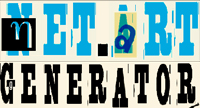
link.of.thought_ thought.of.link
TAGallery by CONT3XT.NET extends the idea of a tagged exhibition and transfers the main tasks of noncommercial exhibition spaces to the discourse of an electronic data-space. The method of tagging allows the attribution of artworks to different thematic fields. EXHIBITION_003 was tagged / curated by Ursula Endlicher and Ela Kagel, who started the blog Curating NetArt in May 2006 as ongoing conversations about various topics surrounding media arts. Their exhibition link.of.thought_thought.of.link for TAGallery is an extension of this blog in dialogue-form and a meta-curatorial statement of their perspective on the challenges of curating media / net / art.
With projects / works by: UBERMORGEN / Alessandro Ludovico / Paolo Cirio, Jo-Anne Green / Helen Thorington (Turbulence), Aleksandra Domanovic / Oliver Laric / Christoph Priglinger / Georg Schnitzer, Cornelia Sollfrank, Eva Grubinger / Thomas Kaulmann, 0100101110101101 (Eva and Franco Mattes), Ruth Catlow / Marc Garrett (Furtherfield), Graffiti Research Lab, Mushon Zer-Aviv / Dan Phiffer.
Exhibition :: Curator's dialogue :: Curator's bio/CV :: Curator's blog [posted on newmediafix]
Posted by jo at 10:59 AM | Comments (0)
June 26, 2007
Net User 4

Call for registration
Net User 4 international working camp :: July 16-24, 2007 :: Organized by InterSpace Association, Bulgaria.
Net User is an international and interdisciplinary forum taking place biannually in Bulgaria, which features a wide variety of current trends in network activities in order to develop a better theoretical and pragmatic understanding of ICT, new media and creativity. Building on the previous well-attended three editions of the forum, Net User 4 will bring together researchers and practitioners from many disciplines, fields and countries for a working camp with a variety of events like presentations, common and panel discussions, workshops, workgroups, free mutual skill sharing panels, a screening and exhibition program, music performances and informal exchanges.
The working camp will explore various issues around the theme of Networking or how do people living in the technological era develop and use the network technologies.
Net User 4 will take place in the heart of Balkan Mountains - Pleven Hovel, 1504 meters above sea level. The isolated place and the beautiful nature will provide the perfect environment for the programme of free mutual skill sharing panels, informal exchanges, and mostly for a creative holiday in a pleasant company.
The participation in the international working camp is free of charge, however the participants should cover themselves their travel and lodging costs.
Posted by jo at 12:50 PM | Comments (0)
Ars Virtua Presents: We are the Strange
Ars Virtua is proud to present the Second Life premier of We are the Strange :: June 29 at 6:00 pm SLT [SLURL].
M dot Strange takes us into the new realm of video game structured and inspired storytelling with his character's harrowing quest for ice cream. The variety of animation styles, game and cultural references and distopian beauty of this work make it important to modern filmmaking. Add to this that m dot strange created this virtually single handedly and had it selected for Sundance based on his YouTube audience and you end up with a very powerful piece of contemporary media.
We are the Strange is an animated feature film in which two diametrically opposed outcasts fight for survival in a sinister fantasy world. After meeting in the somber Forest of Still Life, an abused young woman (Blue) reluctantly follows a care free dollboy (Emmm) to Stopmo City on his unreasonable quest for ice cream. They're lives are constantly in jeopardy after they're caught in the middle of a deadly battle between bizarre monsters on their way to the ice cream shop. A flamboyant ultraviolent hero(Rain) appears and effortlessly dispatches all the horrible monsters in his path. Blue meets Rain before he partakes in an impossible battle against the source of all that is evil in Stopmo City. When it seems as if darkness will have the last laugh a gleaming fist made of aluminum foil bursts through the ground thus starting the final showdown
between mega_good and hyper_evil.
We Are the Strange is its own imaginative and immersive universe. M dot Strange spent three years painstakingly creating this film, using a range of animation techniques: traditional, stop-motion, computer, and his own unique blend of 8-bit graphics and anime, dubbed "Str8nime." The stunning visuals are complemented by a soundtrack that is both beautiful and harrowing. The end result is a freaky technocarnival ride that climaxes with a momentous battle between innocence and darkness.
Posted by jo at 12:17 PM | Comments (0)
Movie Cards
Movie Cards is a unique workshop project by MIYABARA Mika and SUGIMOTO Tatsuo. They are interested in the generation of a creative community and the relationship between society and media. At the workshop, every participant is able to edit video easily. The system consists of the real cards made of paper. Each card is represented of a piece of video scene. Participants could get the way of thinking creative and critical through the process of making video with others. The finished moving images would be a new alternative independent media. It is a simple video editing tool and no need of any technical knowledges. It is useful for understanding and learning the expression of moving images. It can be use for media study class. Students will become conscious of the force and effect of editing. They could understand daily visual media are edited with someone's intention. Moving image media are daily thing. But we can access them as only viewing. It was one-sided relationship. Now, we can really make moving images and become a alternative filmmaker. [via mediateletipos]
Posted by jo at 11:42 AM | Comments (0)
Metabiosis - Go Forth & *
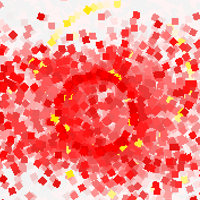
Call for Participation
Metabiosis - Go Forth & * by Aymeric Mansoux and Marloes de Valk :: Medialounge, The Media Centre, 7 Northumberland Street, Huddersfield, HD1 1RL :: Opening: 11 July 7 - 9pm :: Exhibition runs from 12 July until 17 August 2007 :: 10am - 5pm, Monday to Friday.
Create your own data-packet to live on a network of computers. Give your packet a personality! Is it shy? Outgoing? Is it afraid to leave its home or is it more of a traveler? Is your packet screaming for attention or is it more of a loner? Answer the questions and set your packet free. Your packet will soon bump into other packets, and start to interact, maybe even to breed, but its limited lifespan means that one day it must face the inevitable ... packet heaven. Follow your packets ups and downs, its travels and its offspring by following its journeys through the three computer based ecosystems in this installation.
Metabiosis — Dependence of one organism on another for the preparation of an environment in which it can live. Metabiosis is a collection of works about digital life and autonomous creation processes. We are developing, writing, sketching, investigating and working on a series of sub projects, with as a final goal a software that combines all our efforts. Because we are working in a modular way, we cannot predict the eventual results, but at the moment we’re working on creating small ecosystems on a network of computers. In these ecosystems you’ll be able to seed little packets of data. The packets are in reality only a set of numbers, but they do have some special features. The packets can jump to other computers with ecosystems, they can reproduce and they can die. This system of networked ecosystems, inhabited by self replicating data packets, is an experiment and a game for those who are curious about the possibility of digital life in the ever growing ecosystem of connected computers.
This website contains articles about different aspects of Metabiosis: the code, texts with thoughts, ideas and research, input that gives us new ideas, and information about events such as exhibitions or performances.
Posted by jo at 10:02 AM | Comments (0)
June 25, 2007
Institute for Applied Autonomy
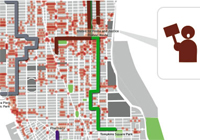
Tactical Cartography
In taking up the term 'tactical' in an arts context, we link cartography with 'tactical media,' an approach to art production that privileges critical social engagement. Since the early 90's the tactical media label has become something of a house brand for a host of widely divergent media practices embracing themes of politics and empowerment. Particularly, the term has expanded from its origin in interventionist art to ultimately include a wide variety of "alternative" and "indy" media strategies. In considering the term here, we emphasize its connotations of instrumentality.
At root, tactical media is about intervention - it is concerned with creating disruptions within existing systems of power and control. Less a methodology than an orientation, it is fundamentally pragmatic, utilizing any and all available technologies, aesthetics, and methods as dictated by the goals of a given action. Tactical media events are necessarily ephemeral - they exist only as long as they continue to be effective; once their utility has been exhausted, they vanish into thin air. While it may form a part of a long-term strategy, tactical media itself is concerned with temporary destabilization rather than permanent transformation.
Extending these notions to spatial representation, then, we claim that "tactical cartography" refers to the creation, distribution, and use of spatial data to intervene in systems of control affecting spatial meaning and practice. Simply put, tactical cartographies aren't just about politics and power; they are political machines that work on power relations. From An Atlas of Radical Cartography.
Posted by jo at 04:56 PM | Comments (0)
The DIY Guide to Becoming a (Real) Cyborg
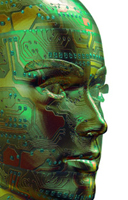
Getting a Futuristic Life Now
"A scientific duo at Tel-Aviv University discovered this past month that the injection of a chemical stimulant into an artificial culture of live neurons at crucial points in time could create an environment that can store multiple rudimentary memories. While many individuals might be disturbed about the fact that artificial intelligence has become a reality, advocates might applaud the scientists' conclusion that chemical stimulation may be crucial to learning about memory formation in living organisms. Still other individuals might wonder if a middle ground in this debate about artificial intelligence is possible, or if any semblance of humor can be injected into a serious subject to lighten the atmosphere.
Individuals who resist the artificial intelligence development often believe that this technology bodes nothing but evil, especially if research falls into nefarious hands. Others are grateful for this research. Witness Jesse Sullivan, an electrician who accidentally touched an active cable that contained 7,000-7,500 volts of electricity in 2001 and, as a result, lost both arms at the shoulder. Since then, he's become the recipient of a 'bionic arm' created by scientists at the Rehabilitation Institute of Chicago. His experience, while truly unique, may help others lead active lives in the near future with these life-like prostheses..." Continue reading The DIY Guide to Becoming a (Real) Cyborg.
Posted by jo at 03:32 PM | Comments (0)
The G-7 Stock Puppets
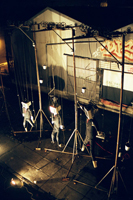
An Internet-driven "Commodities" Trading Environment
The G-7 Stock Puppets are an Internet-driven kinetic installation that tracks the movements of global stock markets with seven larger-than-life marionette puppets. Using a real-time data stream, a network of PC laptops, and a complex electro-mechanical control system, the installation reanimates the abstract machinations of global financial markets as an absurdist carnival puppet show.
Unfortunately, the script for this puppet show remains a bit hazy. One moment, we might find the NASDAQ puppet soaring 20 feet into the air, consumed with the latest IPO elation. The next moment, without apparent reason or warning, the Nikkei puppet might fall to the ground, crumpling into a fetal posture of weakness and desperation. From the opening to the closing bell, the puppets continue to rise and fall in serendipitous synchronicity with the "arbitrary" movements of the G-7 market indices. Clearly, in this puppet show, the markets themselves are the "puppet masters". But we may ask ourselves, "Who are the puppets?"
Physical Particulars: The puppets are made from 8 foot tall fiberglass mannequins, dressed in gray-pinstriped double-breasted suits, accessorized with standard-issue red power ties. Large VGA monitors for heads stream stock ticker symbols and index numbers for the individual markets. Each puppet movement cues a face animation of the appropriate finance minister on the monitor head- the face morphing and contorting in relation to the direction of market movement. The puppets are elevated and articulated by cables extending down from pulleys supported 25' overheard on seven individual puppet towers. Surrounding this mechanized market ballet is an ambient soundscape of shouted buy and sell orders, bells and gavels, racing heartbeats and terrified curses.
Performance: In the middle of the semi-circle arc of puppet towers is a "Blackjack style" trading table, staffed by a tuxedo-clad dealer. The dealer keeps up a steady banter of market analysis, beckoning the brave to come forward and speculate on the index of their choice. Feeling bullish on Germany? Step up and place your "bet" on the Germany circle. No money please, just the random ephemera you happen to have with you- keys to unknown locks, photos of ex-lovers, business cards from clients you'd rather forget, or whatver else you might find in your pockets, purse or backpack. If the corresponding puppet goes up, choose your prize from the pile of profit in the trading pit. If the puppet goes down, you lose your "bet" and build the pile of profit for the next day trader.
Token Theoretical Elaboration: The Puppet installation is a gentle commentary on our society's near pathological infatuation with global stock markets in this era of the "new economy". At the same time, it is also a serious experiment to map the complex information stream of financial data onto dynamic objects in the physical world. Our intention is to re-embody this information ecology in a manner that reveals some of the character and patterning encoded in the fragments of the data stream. And during the process, we hope to also laugh a bit at the arbitrary control this data stream holds over many of our emotional lives and reckonings of self-worth. [Via Pasta and Vinegar]
Posted by jo at 02:01 PM | Comments (0)
Vernacular Video
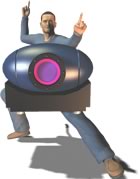
... a gift economy in an economy of abundance...
Vernacular Video by Tom Sherman: The technology of video is now as common as a pencil for the middle classes. People who never even considered working seriously in video find themselves with digital camcorders and non-linear video-editing software on their personal computers. They can set up their own “television stations” with video streaming via the Web without much trouble. The revolution in video-display technologies is creating massive, under-utilized screen space and time, as virtually all architecture and surfaces become potential screens. Video-phones will expand video’s ubiquity exponentially. These video tools are incredibly powerful and are nowhere near their zenith. If one wishes to be part of the twenty-first-century, media-saturated world and wants to communicate effectively with others or express one’s position on current affairs in considerable detail, with which technology would one chose to do so, digital video or a pencil? - NOEMA.
Posted by jo at 11:38 AM | Comments (0)
Art + Music of the Overhead Projector

Call for Participation
ART AND MUSIC WITH THE OVERHEAD PROJECTOR - A one week experimental workshop around the overhead projector :: August 20-25, 2007 :: Moltkerei studio in Cologne / Germany :: Presentation and Performance August 25, 7pm - in the tradition of The Art of the Overhead- Festival.
The workshop is about a playful and artistic exploration with the overhead projector. It aims at everybody wanting to develop overhead projector based light/sound or performance works. In a final presentation the works created during the workshop will presented to the public. Overhead projectors, tools and materials will be supplied by the organisers. Simple accomodation can also be organised if needed. Travel expenses won't probably be covered.
If you are interested or have questions send an e-mail to tageslichtprojektor[at]derstrudel.org. Organization: Christian Faubel, Ralf Schreiber, Tina Tonagel
Posted by jo at 09:10 AM | Comments (0)
United Nations Plaza
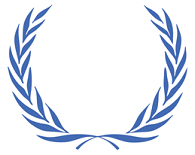
Inaugurates WUNP – 95.2 FM
The United Nations Plaza Radio Network, WUNP – 95.2 FM :: Inaugural Broadcast – LIVE INTERNET STREAM :: June 30, 9-11pm CEST (Berlin) :: unitednationsplaza, Platz der Vereinten Nationen 14a, Berlin 10249, Germany :: followed by a party at Salon Aleman.
WUNP is a radio station produced by neuroTransmitter [Valerie Tevere + Angel Nevarez] for United Nations Plaza. WUNP is a portal for broadcasting audio works and conceptual radio projects. Over the course of the summer and fall of 2007 WUNP will be on air across Berlin (95.2 FM) and beyond through internet stream. We will initiate our broadcast schedule with special in-studio contributions and conversations with: Fia Backström, Regine Basha and Julieta Aranda, Uta Meta Bauer and Piotr Nathan, Karl Holmqvist, Stefan Saffer, and Tirdad Zolghadr.
WUNP radio programs will be available for continuing use in cassette form and are accompanied by a script or blurb to radio broadcasters.
Local broadcast times: 9-11am Honolulu / 11am-1pm Anchorage / 12-2pm Los Angeles, Vancouver / 1-3pm San Salvador / 2-4pm Bogotá, Mexico City / 3-5pm Montréal, New York / 4-6pm Buenos Aires, São Paulo / 4:30-6:30pm St. John’s / 7-9pm Casablanca, Reykjavik / 8-10pm Algiers, Dublin, London / 9-11pm Berlin, Rome, Zagreb / 10pm-12am Beirut, Istanbul, Nairobi, Ramallah / 11pm-1am Baghdad / 11:30pm-1:30am Tehran / +1 day -- 12-2am Islamabad, Moscow / 1-3am Dhaka / 1:30-3:30am Mumbai, New Delhi / 2-4am Chiang Mai, Hanoi / 3-5am Beijing / 4-6am Seoul, Taipei, Tokyo / 5-7am Sydney / 6-8am Vladivostok / 7-9am Auckland / 8-10am Anadyr / 9-11am Christmas Island /
United Nations Plaza is organized by Anton Vidokle in collaboration with Liam Gillick, Boris Groys, Martha Rosler, Walid Raad, Jalal Toufic, Nikolaus Hirsch, Natascha Sadr Haghighian and Tirdad Zolghadr.
For further information, please contact:
Ms. Magdalena Magiera
unitednationsplaza
Platz der Vereinten Nationen 14a
Berlin 10249 GermanyUNP
T. +49 (0)30 700 89 0 90
F. +49 (0)30 700 89 0 85
Posted by jo at 08:53 AM | Comments (0)
re:place 2007

re:place 2007: The Second International Conference on the Histories of Media, Art, Science and Technology :: Date: November 15-18, 2007 :: Haus der Kulturen der Welt, Berlin.
This conference is a sequel to 'Refresh!', the first in this series, chaired by Oliver Grau and produced by the Database of Virtual Art, Leonardo, and Banff New Media Institute, and held at the Banff Center in Canada in September 2005, which brought together several hundred artists, scientists, researchers, curators and theoreticians of different disciplines.
re:place 2007 will be an international forum for the presentation and the discussion of exemplary approaches to the rapport between art, media, science and technology. With the title, 're:place', we propose a thematic focus on locatedness and the migration of knowledge and knowledge production in the interdisciplinary contexts of art, historiography, science and technology.
Posted by jo at 08:32 AM | Comments (0)
June 23, 2007
The Spam Oracle

When you cut into the present, the future leaks out.
"In 1959 Brion Gysin said that writing is 50 years behind painting, and applied the montage technique to words on a page ... Brion copied out phrases from newspapers and magazines, then took his scissors and cut these selections into pieces and re-arranged the fragments at random." – William Burroughs, Naropa Institute, 1976
In the late 1950s Beat writers William Burroughs and Brion Gysin discovered that "when you experiment with cut-ups over a period of time, you find that some of the cut-ups and re-arranged texts seem to refer to future events." The Spam Oracle brings the cut-up technique forward another 50 years, applying it not to the coherent world of linear, conventional texts, but to the increasingly bizarre universe of filter-dodging spam emails. What happens when these emails – already works of cultural pastiche in and of themselves – are cut up and randomly remixed? In what ways does the evolution of spam as an adaptive mash-up medium reflect who we are and where we're headed?
Ask The Spam Oracle a question, or tell it what's on your mind, and discover what secrets lurk between the lines. An ongoing piece by multimedia artist Jess Kilby, University of Salford Creative Technology program.
Posted by jo at 11:35 AM | Comments (0)
OurSpace
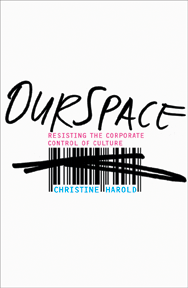
Resisting the Corporate Control of Culture
OurSpace: Resisting the Corporate Control of Culture by Christine Harold: When reporters asked about the Bush administration’s timing in making their case for the Iraq war, then Chief of Staff Andrew Card responded that “from an marketing point of view, you don’t introduce new products in August.” While surprising only in its candor, this statement signified the extent to which consumer culture has pervaded every aspect of life. For those troubled by the long reach of the marketplace, resistance can seem futile. However, a new generation of progressive activists has begun to combat the media supremacy of multinational corporations by using the very tools and techniques employed by their adversaries.
In OurSpace, Christine Harold examines the deployment and limitations of “culture jamming” by activists. These techniques defy repressive corporate culture through parodies, hoaxes, and pranks. Among the examples of sabotage she analyzes are the magazine Adbusters’ spoofs of familiar ads and the Yes Men’s impersonations of company spokespersons.
While these strategies are appealing, Harold argues that they are severely limited in their ability to challenge capitalism. Indeed, many of these tactics have already been appropriated by corporate marketers to create an aura of authenticity and to sell even more products. For Harold, it is a different type of opposition that offers a genuine alternative to corporate consumerism. Exploring the revolutionary Creative Commons movement, copyleft, and open source technology, she advocates a more inclusive approach to intellectual property that invites innovation and wider participation in the creative process.
From switching the digital voice boxes of Barbie dolls and G.I. Joe action figures to inserting the silhouetted image of Abu Ghraib’s iconic hooded and wired victim into Apple’s iPod ads, high-profile instances of anticorporate activism over the past decade have challenged, but not toppled, corporate media domination. OurSpace makes the case for a provocative new approach by co-opting the logic of capitalism itself.
Christine Harold is assistant professor of speech communication at the University of Georgia.
Please contribute your thoughts, links, ideas, oppositions, and provocations to the new OurSpace wiki.
Posted by jo at 11:28 AM | Comments (0)
RADICAL JESTERS
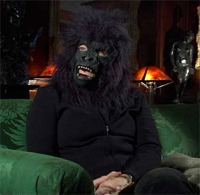
Artists Engaged in Social Critique
RADICAL JESTERS; A Film by Tim Jackson :: Screening at Studio Soto, 63 Melcher St. Boston, MA 02210 :: June 28; 8 pm :: Admission is free with a $5-$10 suggested donation.
Recently completed, the film RADICAL JESTERS explores the work and ideas of a diverse group of performers and artists engaging in social critique. These are provocateurs and ‘interventionists’ who engage in media hoaxes, culture jamming, and imaginative art practices. Their art is not about commercial exchange but about increasing awareness and creating balance in a culture where ideas and values are often fashioned by the media.
I felt there was too little effective protest, or at least effective in terms of the media’s willingness to cover events and to evaluate itself. The work of the Situationists in France in the 1960’s and their interrogation of the “Society of the Spectacle” helped provide perspective. The work of well-known artists such as Barbara Kruger, The Bread and Puppet Theater, and others provided inspiration. I wanted to begin to look at new breed of individuals working outside the commercial system attempting to re-engage the public mind with amusing and compelling activities and to tie this work to older practices and traditions. I think the audience will get a good laugh, but that the subject will encourage discussion.
Collaboration and education were essential in developing of this film. The film is a collaboration of three groups:
• The artists themselves who are interviewed and have lent documentation of their work to the film. These include:
- The Surveillance Camera Players
- The Guerrilla Girls
- The Living Theater
- Milan Kahout (Mobius Performance Artist)
- Improv Everywhere
- Dyke Action Machine
- San Francisco Billboard Liberation Front
- Institute for Infinitely Small Things (Boston)
- Local Prankster John Hargrave
- Hoaxer Alan Abel
- John King (Gang of Four)
• Students and facilities at the New England Institute of Art in Brookline. Over a year and a half, two documentary production classes were designed around the research and organizing of the work, and the gathering of interviews. A dedicated and wonderful group of students volunteers then continued to assist with the film putting in additional hours shooting interviews, gathering b-roll, editing, sound mixing, providing graphic and web design.
• A generous group of Boston musicians each lent unique compositions to each section of the film. Musical contributions include Robin Lane (singer-songwriter), Dana Colley (Morphine), Larry Luddecke (composer, producer, and engineer – Straight Up Music), Mason Daring (66 feature films, Frontline and Nova themes), Richard Gates (Patty Larkin, Jennifer Kimball), Mike Turk (harmonica legend) and Shane Myrback (award winning student composer)
TIM JACKSON
Tim Jackson studied drama at Ithaca College in the late 60's where he worked with the priest, poet and peace activist Reverend Dan Berrigan on Trial of the Catonsville 9, and with the avant-garde theater company TheaterCosmos.
He moved to a career in music during the 70's working with dozens of groups including Tom Rush, Robin Lane and the Chartbusters, LaVern Baker, Jonathan Edwards, Patty Larkin, Mason Daring, and others, recording, performing, and touring for over a decade. He has contributed to many soundtracks as a drummer.
In the 80's Jackson returned to acting and was a founding member of the Harrison Project, an acting company under the direction of Peter Kelley. He began studying video production at the Boston Film and Video Foundation in 1982, and directed several music videos. Continuing a music career in Boston he started his own group, The Band That Time Forgot, in 1984, which earned a “Best of Boston” award in 1988 and remains active 23 years later.
In the 90's, following a Masters In Education, he began teaching at the New England Institute of Art in liberal studies and digital media. In 2006, he was awarded the college’s 1st Norm Prescott Distinguished Faculty Award. He directs the annual Naked Eye Student Film Festival at the Coolidge Corner Theater under the sponsorship of the college, and with the assistance of students.
Also in 2006, after three years, a close team of faculty and student volunteers completed the film, “Chaos and Order: Making American Theater.” Jackson acted as director and interviewer for the film, which was also done in collaboration with the American Repertory Theater. It is currently being distributed by “Films for the Humanities”.
He recently acted as on-camera interviewer for Kathleen Turner at the Provincetown Film Festival, where she received a Lifetime Achievement Award.
Radical Jesters is his first effort as producer, writer, and director.
Posted by jo at 09:46 AM | Comments (0)
June 22, 2007
Beyond Green: Toward a Sustainable Art
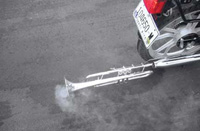
Has "activist" art exited the building for good?
"[...] This evolving hybridization has invited visual art out of the gallery and museum, and into public and unconventional spaces. Most of the art we talk about is not only critical, but also usually situated outside of traditional art venues and often in site-specific circumstances. Does that mean that "activist" art has exited the building for good, leaving only "inactive" works inside? Can socially-engaged, participatory and interventionist art retain its impact within the walls of a museum?
Stephanie Smith, Curator of Contemporary Art at the Smart Museum of Art, has proven that indeed, this work still does have a place in a museum setting. Smith is the curator of Beyond Green: Toward a Sustainable Art, a traveling exhibition of contemporary artists who address sustainability, activism and the future through their work. The exhibition has also been turned into a book by the same name, which showcases the works, essays and artists' statements of the thirteen artists and artists' groups in the show. In her introduction, Smith describes the multiple cultural phenomena and developments in design and art theory that have led to "this holistic, ethical, pragmatic and wildly inventive" artistic practice, and she explores the changing relationship between traditional exhibition spaces and non-traditional art..." From Beyond Green: Toward a Sustainable Art by Sarah Rich, WorldChanging.
Posted by jo at 05:01 PM | Comments (0)
Space Junk Spotting
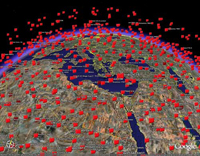
Responsibility and Re-Use
In the more than fifty years that have passed since the conquest of space began, we have succeeded in filling orbits around the earth with surplus satellites, rocket waste, and other debris. We can view this space junk as archeology in the making or, indeed, as a garbage dump in a class of its own.
Space Junk Spotting is a tactical platform for researching this phenomenon, one that seeks to encourage various interpretations for reusing this space excavation site / garbage dump, which is already there and is constantly growing. In this phase, the project thematizes the extent of the pollution in the usable orbits around earth, the ownership of the threatening waste and, consequently, the responsibility for it, and the possibilities of recycling it...
The project shown here is composed of mechanical and programming equipment linked to a database at a U.S. government-owned space observatory; this database contains the fullest possible data on the extent of the pollution and presents remarkable scientific methods for determining the position of space junk. In this way, the wider Internet public is offered a folder of information about space debris (you'll need to download Google Earth), which is strewn across the popular three-dimensional interface Google Earth.
The tactical potential of this catalogue is the possibility it provides for finding a creative and constructive solution to the problem of reusing material whose position in usable orbits is already determined, without the enormous initial costs that arise whenever rockets are shot into space...
Collaborators: Saso Sedlacek, Boštjan Špetic, Jure Cuhalev, Anže Cesar, Almir Karic, Mirae Seo, Yosuke Hayashi,Yu Fukui Thanks to: Atsuhito Sekiguchi, Falk Wittel, Ferenc Kun, Takanori Endo, Kiberpipa, Err0r Production: Galerija Kapelica Project was supported by: Ministry of Culture of the Republic of Slovenia, Municipality of Ljubljana, Sipronika, d.o.o., IAMAS (Institute and Academy for Advanced Media Art and Science, Japan). [via VVork]
Posted by jo at 04:31 PM | Comments (0)
Camp for Climate Action

Workshop on Art Activism
Departure Lounge: A weekend workshop designing creative resistance against the root causes of Climate Change :: July 13-15, near Heathrow, London.
Some of the most successful political movements have been those that have developed creative forms of protest: the suffragettes chaining themselves to buildings, the beautiful tree houses of the anti roads protesters, the Zapatistas with their poetic communiques and masks, Reclaim the Streets' rebel carnivals, the Italian white overalls' imaginative take on civil disobedience. All these forms have emerged when the unbridled imagination of art mixes with the deep social engagement of politics. The growing radical movement for climate justice needs its own new forms.
Departure Lounge is a weekend workshop where we will collectively explore the spaces between art and activism and design creative actions in preparation for the Camp for Climate Action. The Camp, which takes place near Heathrow from 14th to 21st August, has been described by the Independent as "Glastonbury, science seminar and protest all in one." It mixes low-impact ecological living, dozens of workshops and mass direct action aimed at the root causes of climate change. This year it will be targeting the aviation industry and airport expansion.
At the workshop we will work together to create imaginative new forms of protest, share skills and ideas, and design events / actions that will take place during the Camp to engage, delight, provoke, challenge and encourage participation.
The weekend is suitable for those who are interested in work that does not merely 'represent' a political issue, nor serves as propaganda but directly confronts and transforms the issue itself. If you are interested in radically engaged practices that look neither like art nor activism but take the best of both of these worlds, that sit somewhere between direct action and performance, resistance and creativity then this workshop is for you.
A key inspiration for the workshop will be Steven Duncombe's concept of creating "Ethical Spectacles".
Taking place from the evening of Friday 13th July to late Sunday afternoon, 15th July, the workshop will be funded on a donations basis. We hope to be in one of the villages threatened with destruction by the expansion of Heathrow airport. The exact location will be confirmed later.
Facilitated by artist / activist John Jordan, and writer / activist Katharine Ainger, the workshop aims to inject a large dose of radical imagination into the rising movements for climate justice.
Places will be limited so please fill in the attached form and email it to - createresist[at]riseup.net -- before the 29th June. We will Confirm your place by 1st July. Even if you have done nothing like this before, please consider applying. We are looking for a diversity of perspectives. If you have special needs for attendance please let us know once your application has been received and accepted.
"Heathrow is its own city, a Vatican of the western suburb! The airport complex with its international hotels, storage facilities, semi-private roads, is as detached from the shabby entropy of the metropolis as is the City, the original walled settlement. They have their own rules, their own security forces, the arrogance of global capitalism. They service Moloch in whatever form he chooses to reveal himself; they facilitate drug / armament, blood / oil economies." - Ian Sinclair, "London Orbital"
Posted by jo at 04:20 PM | Comments (0)
Seoul International Film Festival 2007 Net Section
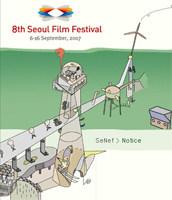
CALL FOR ENTRIES
The 8th Seoul International Film Festival is open for entries. Seoul International Film Festival Net Section is trying to introduce talented visual artists all over the world and their brilliant works and to lead the new audio-visual experiences based on the Internet and New Media. We sincerely hope you consider this exciting opportunity to show your great endeavors in the digital convergence era.
WHEN : September 6 - December 31, 2007 :: WHERE : WWW.SENEF.NET / Mobile and DMB :: SUBMISSION DEADLINE: July 13, 2007 :: ELIGIBILITY: For the official competition section, only works completed after January 2006 may be submitted to the Festival. Submissions should be creative works produced or adopted through digital technology. There will be no restrictions regarding the genre, length or subject matter of the work and all types of works, including fiction, documentary, experimental work, music video, animation, motion graphic, flash animation, game, web-art, etc. will be accepted.
MATERIALS REQUIRED FOR SUBMISSIONS:
1. Completed application form (can be downloaded here)
2. Preview material:
- By Post : DVD / DV6mm / CD / VHS (Seoul International Film Festival Head Office - Program Dept. of Net Section, 5F Youahn Bldg. 146-23 Samsung-dong, Kangnam-gu, Seoul, 135-090 South Korea)
- By FTP Server (under 300 MB) : FLASH / WMV / MOV / AVI / MPEG
* For File-Transferring indications, please mail to program3[at]senef.net
- By E-MAIL : URL address to program3[at]senef.net
3. Complete script in English (.doc)
4. Photo of the Work (.jpg) : more than 300 dpi
5. Photo of the Artist (.jpg) : more than 300 dpi
6. Any other publicity materials related to the submitted work (optional)
* Application form and photos can be submitted by E-MAIL.
* Resolution should be more than 640 * 480.
CONTACT
Park, Ju Youn
Program Coordinator
Seoul International Film Festival
program3[at]senef.net
bleu3901[at]hotmail.com
Tel. +82-2-518-4332
Fax. +82-2-518-4333
Mobile Phone. +82-11-9923-3190
5F, Youahn Bldg. 146-23 Samsung-Dong,
Kangnam-Gu, Seoul, South Korea
zip code 135-090
Posted by jo at 03:39 PM | Comments (0)
EVA Conference: Keith Armstrong
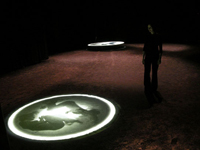
Ecology, Performance and Collaboration
As part of this year's EVA Conference, Australian media artist Keith Armstrong is giving a talk for the Computer Arts Society at Birkbeck: Ecology, Performance and Collaboration - Embodying Intimate Transactions :: July 10; 6:30 for 7:00 :: The Screen on Gordon Square, Birkbeck, 43 Gordon Sq, London, WC1H 0PD :: Nearest tubes - Euston Square, Warren Street, Russell Square. More info.
Intimate Transactions is a dual site, telematic installation currently been shown in the US. It allows two people located in separate spaces to interact simultaneously using only their bodies (predominantly their backs and feet), using two identical interfaces called 'Bodyshelves'. During a 30-minute, one-on-one session their physical actions allow them to individually and collaboratively explore immersive environments. Each participant's own way of interacting results in quite different, but interrelated animated and generative imagery, real time generated audio (seven channels), and three channels of haptic feedback (felt in the stomach and back). This experience allows each participant to begin to sense their place in a complex web of relations that connect them and everything else within the work.
Intimate Transactions is an investigation in creating embodied experiences that are both performative and improvisational by harnessing individual, performative languages of 'untrained' bodies as a means to engender understandings of 'ecological' relationship. It arose from a deep collaboration between media artists, performance practitioners, sound artists, hardware and software engineers, a furniture maker and a scientific ecologist. Our entire process was informed by a praxis-led approach to art making that stressed embodied connectivity and inseparability. This allowed us to understand how participants might move within the constraints of a particular interface, allowing us to shape and form the overall phrasing and sensibilities of their experiences, whilst maintaining the unique nature of their collaborative experiences. In this presentation Keith will discuss his practice-! led rese arch approach and illustrate the presentation with videos, images and sound.
Keith Armstrong is an Australian/English interdisciplinary media artist, Australia Council New Media Arts Fellow, Queensland University of Technology Faculty of Creative Industries Research Fellow and has just finished a Visiting Professorship at Calpoly State University, California, working in collaboration with their Liberal Arts and Architecture Faculties. His recent work Intimate Transactions, created with the Transmute Collective, received an Honorary Mention in the 2005 Prix Ars Electronica and featured in the 2005 Ars Electronica Festival in Austria. His latest interactive installation, Shifting Intimacies, was presented at the ICA London in March 2006.
Posted by jo at 12:40 PM | Comments (0)
Mute Vol 2 #6 Call for Artwork Contributions
![]()
Mute Vol.2 #6 is due to come out in August 2007 and will feature a group of articles investigating the implications of a global economy sustained by unprecedented levels of debt, and the crisis of value production that underlies it; a crisis whose hallmarks are the widespread looting of resources and non-reproduction of infrastructures and labour power, the inflation of asset bubbles, high levels of liquidity and personal debt. We are making this call for artwork and visual contributions to the theme. Artworks submitted will be hosted on this site and those selected for inclusion in the printed magazine will win a year's free subscription to Mute. Please check here and here for freshly uploaded content on this theme.
Please submit your artwork in .zip .pdf .jpeg .png .mp3 .ogg or .mp4 to mute[at]metamute.org (with the subject header 'artwork' or register at metamute.org and upload image files to the following gallery. More >>
Posted by jo at 12:22 PM | Comments (0)
Canal Street Station

Participatory Public Pay Phone Who-Dunnit
31 Down's interactive telephone mystery Canal Street Station runs through October 31, 2007. To play, call this toll-free number from a pay phone inside the station: 1-877-OR-WHAT-31 (1-877-679-4283). Note: This mystery takes place on the N, Q, R, W, 6, and J, M, Z platforms, not the A, C, E, station.
Canal Street Station is a free public media art installation set in the Canal Street Subway Station in New York City. Participants are invited to make a toll-free call from any public payphone in the Canal Street station (inside of the turnstyles). Participants will then be guided on a pay phone mystery. The game takes approximately 45 minutes to complete.
Tajna Tanovic stars in this public pay phone who-dunnit set in the maze of tiles that make up the Canal Street Subway Station. This is an interactive piece that challenges participants to test their skills at listening and following directions. Players are put in the shoes of Mike Sharpie, private investigator, as he searches the depths of Canal Street Station for a young French woman that may have committed a murder, or may be a figment of Mike's wandering imagination.
"Canal Street Station" is co-produced by 31 Down radio theater and free103point9 and presented by free103point9 as part of the transmission arts non-profit's Tenth Anniversary celebration. Created by: Ryan Holsopple, Shannon Sindelar, Mirit Tal, and Tanja Tanovic.
Posted by newradio at 10:44 AM | Comments (0)
Will Web 2.0 Kill Cyberspace?
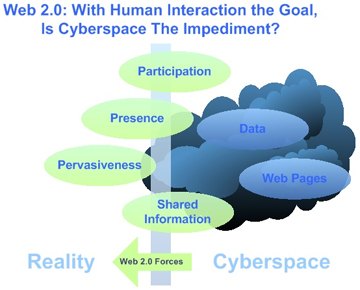
"[...] These days the boundaries between reality and cyberspace are becoming increasingly blurred and the activities on the Web are becoming more two way and integrated with reality ... With going into cyberspace no longer being a discrete step (folks are more and more always there now) and with the primary activity often being to interact with other folks transparently, and you have a folding of cyberspace so severe that it just disappears into the ether." From Will Web 2.0 Kill Cyberspace? by Dion Hinchcliffe.
Posted by jo at 09:45 AM | Comments (0)
killer banshee
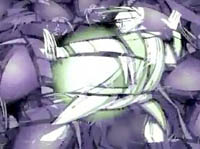
Live Video at Bluestockings
killer banshee brings live, dual screen video performance to Bluestockings for a night of mesmerizing visuals and sound :: June 23rd, 2007 @ 7pm :: Bluestockings, 172 Allen St. Lower East Side NYC :: Subway: F, V to Lower East Side-Second Ave :: 212-777-6028 :: $5-10ss (NOTA: No One Turned Away for lack of funds).
killer banshee is a collaborative partnership between Eliot K Daughtry and Kriss De Jong devoted to creating challenging audiovisual art works. Calling a performance by killer banshee a VJ event fails to describe what you will see. Unlike others using live video in conjunction with dance or music events, this pair uses an arsenal of visual imagery culled from video they've shot, archival footage, their own paintings, drawings and sculpture, to reinterpret and redefine what their art is about. While the duo works in combinations with other performers, their focus is on works of their own. Armed with Laptops and projectors, these two willfully make a dance out of their art. When not working behind the video projectors, Kriss & Eliot can be found doing audio for video, recording spoken word artists, or working on their own eccentric art.
Posted by jo at 09:18 AM | Comments (0)
The Robot Zoo is Now Open!
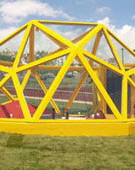
Robotarium X
Artist Leonel Moura advertised his latest project, the Robotarium X, with a grand announcement that 'The first zoo dedicated to artificial life is now open at Alverca, Portugal.' In a park in this small village near Lisbon, Moura has installed a large-scale steel glass construction inspired by the bilunabirotunda, one of the famous geometrical forms known as 'Johnson's solids.' Since June 12, forty-five different robots have lived within this structure--most powered by photovoltaic energy. All of them are original creatures specifically designed by Moura and his partners, Carlos Nogueira and the company IdMind, for the 'Robotarium X.' They represent fourteen species differentiated according to body morphology and behavioral patterns. Some resemble small vehicles similar to those currently used in space exploration; others are similar to small animals, insects, and plants; while others are distinct from anything found in Nature. Many are responsive to humans, and execute subsistence-related activities. Informed by the enlightenment movement's educational displays (like the aquarium) and mixing new technologies and his past experience as a user of robotics within an art context, Moura created an experimental, futuristic work that constitutes a step forward in the ongoing relation between humans and machines that marks the beginning of the twenty-first century. - Miguel Amado, Rhizome News.
Posted by jo at 09:04 AM | Comments (0)
Merce Cunningham - Biped
Posted by jo at 08:56 AM | Comments (0)
PARTICIPATE IN URBAN SPACE
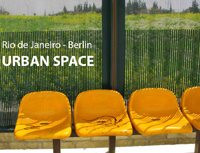
Deadline: July 1, 2007
Urban Space is part of the biannual Brazilian photography festival FotoRio, taking place in Rio de Janeiro in July. Project curators will select 25 artists to participate in the 2007 edition of FotoRio. On July 20th, selected images from these artists will be projected at the festival location Oi Futuro - a landmark cultural institute in Rio de Janeiro. Simultaneous with the projections in Brazil, the same selection will be projected in the Berlin gallery, New Life Shop.
Urban Space invites submissions from artists working with issues regarding the urban environment, such as anonymity, community, displacement, informal architectures and gentrification. Traditional documentary photography as well as urban portraits, architectonic interventions, actions and documentation of street art projects, are to be considered for selection.
URBAN SPACE OPENING - RIO & BERLIN
The Urban Space opening will be held on Friday, July 20th in Rio and Berlin at 8 PM local time.
RIO DE JANEIRO VENUE:
Rua Dois de Dezembro 63/ 8º andar
Flamengo
Rio de Janeiro, RJ
Metro: Largo do Machado
BERLIN VENUE:
New Life Shop
Choriner Strasse 85
10119 Berlin-Mitte
U-Bahn: Rosenthaler Platz (U8)
Posted by jo at 08:01 AM | Comments (0)
June 21, 2007
Tribute to Reggie
This is a tribute to Exxon employee Reggie Watts, who volunteered his body to be turned into fuel. Eventually, we will turn the billions victims of climate change into fuel as well, to make life better for the rest of us. See www.vivoleum.com for more info.
Posted by jo at 05:51 PM | Comments (0)
Mapping the Internet
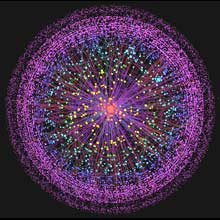
Peer-to-Peer Networks could stave off Congestion
"The increased use of peer-to-peer communications could improve the overall capacity of the Internet and make it run much more smoothly. That's the conclusion of a novel study mapping the structure of the Internet.
It's the first study to look at how the Internet is organized in terms of function, as well as how it's connected ... The researchers' results depict the Internet as consisting of a dense core of 80 or so critical nodes surrounded by an outer shell of 5,000 sparsely connected, isolated nodes that are very much dependent upon this core. Separating the core from the outer shell are approximately 15,000 peer-connected and self-sufficient nodes.
Take away the core, and an interesting thing happens: about 30 percent of the nodes from the outer shell become completely cut off. But the remaining 70 percent can continue communicating because the middle region has enough peer-connected nodes to bypass the core..." From Mapping the Internet: Routing traffic through peer-to-peer networks could stave off Internet congestion, according to a new study; by Duncan Graham-Rowe, Technology Review.
Posted by jo at 05:22 PM | Comments (0)
Second Earth
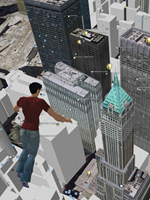
Toward a Metaverse
[...] The first, relatively simple step toward a Second Earth, many observers predict, will be integrating Second Life's avatars, controls, and modeling tools into the Google Earth environment. Groups of users would then be able to walk, fly, or swim across Google's simulated landscapes and explore intricate 3-D representations of the world's most famous buildings ... A second alternative would be to expand the surface area of Second Life by millions of square kilometers and model the new territory on the real earth, using the same topographical data and surface imagery contained in Google Earth ... That's a much more difficult proposition ...
[W]ithin 10 to 20 years--roughly the same time it took for the Web to become what it is now--something much bigger than either of these alternatives may emerge: a true Metaverse ... It will look like the real earth, and it will support even more users than the Snow Crash cyberworld, functioning as the agora, laboratory, and gateway for almost every type of information-based pursuit. It will be accessible both in its immersive, virtual-reality form and through peepholes like the screen of your cell phone as you make your way through the real world. And like the Web today, it will become "the standard way in which we think of life online..."
While Second Life and Google Earth are commonly mentioned as likely forebears of the Metaverse, no one thinks that Linden Lab and Google will be its lone rulers. Their two systems are interesting mainly because they already have many adherents, and because they exemplify two fundamentally different streams of technology that will be essential to the Metaverse's construction...
"Google Earth itself is really neat," comments Jamais Cascio, the Metaverse Roadmap coauthor. "But Google Earth coupled with millions of sensors around the world, offering you real-time visuals, real-time atmospheric data, and so on--that's transformative."
Indeed, it's important to remember that alongside the construction of the Metaverse, a complementary and equally ambitious infrastructure project is under way. It's the wiring of the entire world, without the wires: tiny radio-connected sensor chips are being attached to everything worth monitoring, including bridges, ventilation systems, light fixtures, mousetraps, shipping pallets, battlefield equipment, even the human body ... "Augmented reality and sensor nets will blend right into virtual worlds," predicts Linden Lab's Ondrejka. "That's when the line between the real world and its virtual representations will start blurring." From Second Earth - The World Wide Web will soon be absorbed into the World Wide Sim: an environment combining elements of Second Life and Google Earth; by Wade Roush, Technology Review.
Posted by jo at 04:16 PM | Comments (0)
DRIFT 2007 Exhibition @ Rush Art Gallery, NYC
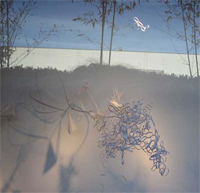
Call for Live Performance + Video Art
DRIFT (Santa Fe NM): Drift is an annual exhibition that travels to a new location every year. DRIFT 2007 marks its 5th anniversary and is scheduled as a two-day performance art and video art show at Rush Arts Gallery in the Chelsea art district in New York City. Curated by: Eileen Olivieri Torpey and Bradley Pecore. The show will take place during NYC's Performa Biennial Performance Art events in November. Proposal Deadline: Postmarked July 13, 2007. Contact them here.
DRIFT characterizes the impermanence and site-specificity of the artworks as well as the adaptive qualities of the participating artists. DRIFT highlights talented under represented artists while emphasizing the critical role of experimentation and process within both conventional and unconventional exhibition spaces.
DRIFT was first conceived in the winter of 2002 as a one-day exhibition on the Jersey Shore. The Atlantic Ocean inspired temporary works by twelve artists from the greater New York City area. Fluxus artist, Geoffrey Hendricks, punctuated the day with a famous headstand on a pile of ocean boulders. In 2003 the show moved to a former home of Buckminster Fuller, River Run Farm in New Jersey. Artists responded to thirty acres of pastoral/river landscapes and the cultural history of the farm, which was part of the Underground Railroad in the early 1800's.
In 2004 DRIFT took place at Valentino Pier Park, located on the Buttermilk Channel in Red Hook Brooklyn. The exhibition featured 20 artists working in video, painting, sculpture, installation and sound. Red Hook was one of the first areas in Brooklyn to be inhabited by Algonquian tribes and later settled by the Dutch. The surrounding landscape was named for its red clay soil and hook shaped peninsula. Today, the view from Valentino Pier includes: The Statue of Liberty, The Verrazano Bridge, and Lower Manhattan.
DRIFT 2006 took place at the Bronx River Art Center in the South Central Bronx and included 28 artists working in sculpture, installation, video and performance. Part of the exhibition existed outdoors along the Bronx River for one-day while the other part of the show stayed up for six weeks in the center’s gallery. The river covers 23 miles and runs through the Bronx and Southern Westchester. The Mohicans were the first people to live and fish along the river and named it Aquehung or "River of High Bluffs." Beginning in the 1700’s, European immigrants built twelve mills on the river and by the end of the 1800’s, the river was so polluted from industrial waste that people called it an open sewage. Today, school groups and community organizations are working hard to ecologically restore the river and have made substantial progress– there are now a growing number of fish and plant species that have returned.
Posted by jo at 12:29 PM | Comments (0)
SATELLITE VOYEURISM
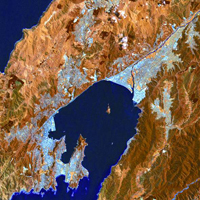
Workshop Call
SATELLITE VOYEURISM - Workshop Call :: July 20 - 22, 2007 :: Hartware MedienKunstVerein at PHOENIX Halle Dortmund, Germany :: limited to 12 participants :: Application Deadline: June 29, 2007.
The Workshop Satellite Voyeurism addresses questions of production and reception of satellite images. In addition to public lectures by international media artists, committed scientists and commercial companies' representatives of the regions' geo-data industry, a two day workshop program with up to 12 participants takes place. Within the hands-on part the participants learn how to use a simple antenna, computer, soundcard combination to retrieve satellite images of NOAA satellites, and share own ideas and projects with the other participants. Both lectures and workshop discuss the image quality of satellite images but of course the subject will also touch upon the field of locative media, as GPS, GIS.
Through the workshop the basis for a publication shall be created, which includes documentation about recent media art projects in the field of mapping, satellite images and satellite technology.
The workshop is open to 12 participants. Participants will get free accommodation and depending on the distance we can partly support the travel costs. There is no workshop fee. With the participation in the workshop the participants agree to actively support the production of a documentation (deadline for texts October 15).
In order to apply for the workshop, please let us know, why would you like to like to participate, what's your field of interest, and what exactly you would present to the other participants. Please also send a short CV. All material to info[at]hmkv.de.
The workshop is funded by Der Ministerpraesident des Landes NRW, LAG Soziokultur NRW, and Kulturbuero Stadt Dortmund.
PROGRAM
July 20, 2007 - from 4 pm on :: Arrival of participants, Internal workshop presentations.
July 21, 2007 - 11 am - 4 pm :: Public lectures with Regine Debatty (WMMNA), Dr. Tristan Thielmann (University Siegen), Frank Warmelink (Free Consultant for geo-data appliance), Francis Hunger (HMKV, Dortmund) Internal workshop presentations by participants (until 9 pm.)
July 22, 2007 - 11 am - 4 pm :: Internal Hands-On Workshop with Thilo Elsner (Observatories Bochum/Amsat-DL) Receiving satellite images from NOAA satellites with just an antenna and a PC. Internal workshop presentations and BBQ.
July 23, 2007 :: departure.
THE LECTURES ON SATURDAY, 21 JULY 2007, ARE PUBLIC AND DO NOT REQUIRE BOOKING.
About Hartware MedienKunstVerein, Dortmund: HMKV serves as a platform for the production, presentation, education on and contextualisation of contemporary and experimental media art. The activities of HMKV deal, in different formats, with the theme Augmented Space": in exhibitions, workshops, performances, symposia, publications, Internet applications and in European research projects. The success of last year's "How I learned to love RFID" workshop at HMKV (conceived by Francis Hunger) and the emergence of popular geographic mapping tools led to the development of the Satellite Voyeurism" workshop in 2007, directed by Francis Hunger.
CONTACT
Office:
Hartware MedienKunstVerein
Francis Hunger
Guentherstrasse 65
44143 Dortmund
Exhibition and Workshop Venue:
HMKV at PHOENIX Halle
Hochofenstrasse / corner Rombergstrasse
44263 Dortmund-Hoerde
info[at]hmkv.de
http://www.hmkv.de
Tel: ++49+231+823106
Posted by jo at 11:06 AM | Comments (0)
COOL MEDIA HOT TALK SHOW
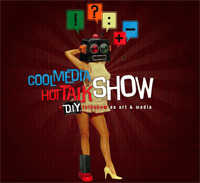
Brutal Realities - Art, Subjectivity and The News
COOL MEDIA HOT TALK SHOW: D.I.Y. talk show on art & media :: TOPIC: Brutal Realities - Art, Subjectivity and The News :: SPEAKERS: Nanette Hoogslag / OOG and Florian Schneider / DICTIONARY OF WAR :: QUESTIONS: ask-it-yourself now and during the show :: June 27, 20.30 CET :: Video stream and interface for online participation :: Location: De Balie - Centre for Culture and Politics, Amsterdam (bring your laptops and mobiles) :: EXTRA: music performance of Nanko.
ABOUT THE TOPIC: Brutal Realities - Art, Subjectivity and The News :: In the digital age you cannot stop information - how many times did we hear this hollowed out clichi? Countless for sure. But exactly what kind of information? How to judge it? How to develop a personal relation to it?
The News is one of these information flows that in the era of digital media seems to become ever more pervasive, inescapable really. As it does so it seems to divide itself into a curious dichotomy: it ( the news ) either becomes trivialised, or it reflects the perpetual miseries of the brutal realities that apparently surround us; disasters, war, famine, oppression, ecological devastation, family drama, and a general feeling of estrangement. In any case difficult to develop a personal relationship to it, be it trivia or conversely our daily portion of misery...
How does art and how do artists relate to this omnipresence of suffering in real-time? Can art help us to develop the distance, the silence, the space in-between that makes it possible to reflect The News ? Can it point a way out of estrangement of the global anxiety machine? Can it rekindle our empathy for the pain of others?
And is social reality in any case coextensive with the news ? Or should we rather develop and alternative relationship to social reality? And how then should this be done?
Can a project such as OOG in the web edition of the Dutch national daily newspaper De Volkskrant, where a different artist is invited every two weeks to comment on the news in an on-line art work every two weeks, help us to develop another (a more healthy?) subjective relationship to the news ?
Can a project such as the Dictionary of War help us to establish an alternative critical relationship to social reality? How can it reach a broader audience without falling into the same trap of mass-mediation?
Or is the very idea of subjectivity towards the news nothing but a regressive and reactionary gesture?
ABOUT THE SPEAKERS:
Nanette Hoogslag (NL) is a visual artist and illustrator. She studied graphic design at the Gerrit Rietveld Academy in Amsterdam and did an MA in illustration at Royal College of Art in London in 1990. She established herself as an illustrator and designer in Amsterdam, working for design and editorial clients worldwide. She has been teaching illustration and design at various art colleges in The Netherlands, currently she teaches illustration and concept development at the Illustration Department at the school of Visual Arts, HKU in Utrecht.
In 2005 Nanette Hoogslag developed the idea for OOG ("eye" in Dutch), inviting artists to react to the news, their role, function and content, in an online environment, which became 'Oog' a weekly online page in one of the largest Dutch national newspapers the 'Volkskrant'. In 2006 the concept of Oog was presented in a live show 'Ooglive' in the Westergasfabriek and shown as part of Faith in Exposure in Montevideo 2007. Oog: http://extra.volkskrant.nl/oog; Ooglive: www.ooglive.com; illustrations: www.hoogslag.nl
Florian Schneider (DE) is a filmmaker, writer, and developer in the fields of new media, networking and open source technologies. In his work he focuses on bordercrossings between mainstream and independent media, art and activism, theory and technology. As a filmmaker he directed several award-winning documentaries and made theme-evenings for the german-french tv station "arte" on the topics of migration and new global movements. He is one of the initiators of the KEIN MENSCH IST ILLEGAL campaign at documentaX and subsequent projects. He founded, designed and supported countless online-projects, such as the European internet platform D-A-S-H and the online-network KEIN.ORG. He is the director of the new media festivals MAKEWORLD (2001), NEURO (2004) and one of the co-organizers of the upcoming FADAIAT2 event in Tarifa / Tangiers, in June 2005. His publications include contributions in Der Spiegel and other renowned magazines and newspapers. From 2001, he has published Makeworlds paper 1-4, a newspaper magazine for theory, art and activism. For incommunicado 05, a special issue will be published as well.
DICTIONARY OF WAR, a collaborative platform for creating 100 concepts on the issue of war, invented, arranged and presented by scientists, artists, theorists and activists. The aim is to create key concepts that either play a significant role in current discussions of war, have so far been neglected, or have yet to be created.
Dictionary of War
Summit of Non-Aligned Initiatives in Education and Culture
Kein.org
SUBMIT YOUR QUESTIONS & COMMENTS!
VOTE FOR THE PROPOSALS OF OTHERS!
JOIN THE DISCUSSION!
here & now: http://www.coolmediahottalk.net/
SPECIAL: ASK THE BEST QUESTION & win the COOL MEDIA PRIZE! the winner will be selected through direct and open voting.
Tickets: 5 euro :: Reservations by telephone: +31.20. 55 35 100 (during opening hours of the ticket office) Or via the Balie website: http:// www.debalie.nl/agenda.
De Balie - Centre for Culture and Politics, Kleine Gartmanplantsoen 10 Amsterdam.
Posted by jo at 10:44 AM | Comments (0)
Fresh Moves: New Moving Images from the UK
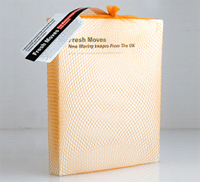
tank.tv @ ICA London
tank.tv: Fresh Moves: New Moving Images from the UK; a DVD of film and video art :: ICA, London :: June 28, 2007; 7:00 pm :: Book now.
The appearance of Fresh Moves is a unique event making artists' moving images, some of which are rarely seen, available beyond the conventional context of art exhibitions and fleeting lives online. The project is the result of tank.tv's continuous collaboration and exchange with artists, institutions and independent curators which has made it the inimitable platform for moving image practice that it is today.
Showcasing new moving image work since 2003, tank.tv presents its first DVD anthology. This collection contains 24 film and video pieces by 24 UK based artists, each around three minutes long, and reflects the creativity, innovation and wide variety of subject matter for which http://www.tank.tv has become known and respected. It also includes five new, specially commissioned interviews pieces between feted curators and artists.
Fresh Moves was compiled by a panel that included Hans Ulrich Obrist, director of the Serpentine Gallery, and Stuart Comer, curator of film and video at Tate Modern. Turner Prize winner Jeremy Deller and infamous philosopher Slavoj Zizek both make an appearance in the series of interviews.
The DVD features recent work from some of the most important artists working in moving images today, such as Cerith Wyn Evans, Daria Martin, Runa Islam, Spartacus Chetwynd and Andrew Kötting, as well as emerging artists like Torsten Lauschmann, Anja M. Kirschner and David Blandy. Rather than a comprehensive overview, Fresh Moves aims to provide an anthology encompassing animation, fictional narrative, digital film, montage and installation-based film work. The works explore a wide variety of subjects - from politics to identity and aesthetic practices, all tempered with a healthy measure of humour - and so celebrate not just the artists featured, but the art of moving images as a whole.
"...this special project addresses the idea of carrying video and filmic work beyond the boundaries of contextually, or spatially, confined spaces pertaining to where a work can be seen. [...] It furthers the investigation into how different modes of filmmaking evolve within the changing consciousness of the public media [...] a sort of polyphony of voices, stories and philosophies. [The project] ...produced an investigation into a new generation of artists working in the UK. [...] Eric Hobsbawm, the great English historian speaks of the very necessary and urgent need for our hyper-paced culture to issue a 'protest against forgetting'." - Hans Ulrich Obrist
ARTISTS: David BLANDY, Ben CALLAWAY, Duncan CAMPBELL, Ergin CAVUSOGLU, Spartacus CHETWYND, Kate COOPER, Ann COURSE, Katy DOVE, Max HATTLER, Runa ISLAM, Kevin HEAVEY, Anja M. KIRSCHNER, Zineb SE DIRA, Andrew KÖTTING, Torsten LAUSCHMANN, Daria MARTIN, Alex HEIM, Ben RIVERS, Samuel STEVENS, Stephen SUTCLIFFE, Mark Aerial WALLER, Saskia OLDE WOLBERS, John WOOD & Paul HARRISON, Cerith WYN EVANS
INTERVIEWS: Steven EASTWOOD with Benjamin COOK, Jeremy DELLER with Chrissie ILES, Ryan GANDER with Hans Ulrich OBRIST, Laure PROUVOST with Michael CONNOR, Sophie FIENNES with Slavoj ZIZEK.
The compilation was selected by: Hans Ulrich Obrist (the Serpentine Gallery), Benjamin Cook and Mike Sperlinger (LUX), Stuart Comer (Tate Modern), Michelle Cotton (Independent curator, London), Rose Cupit (Film London) and Kathrin Becker (NBK, Berlin).
A project by: Laure Prouvost and Birgit Ludwig
Fresh Moves: New Moving Images From the UK
ISBN: 978-0-9555181-0-2
Paperback 150 x 180 mm portrait
300 pages / content printed on 81 colour pages
PAL DVD / Region 0 / running time 85 min
Published by Tank Form Ltd
Distributed by Thames & Hudson.
Interviews with artists and curators involved with Fresh Moves are on http://www.tank.tv until July 15th.
Generously funded by the National Lottery through the Arts Council, England.
Posted by jo at 08:56 AM | Comments (0)
June 20, 2007
xxxxx 2007: Life Coding - Call for Participation

xxxxx call for participation in a speculative 12 hour life coding event (organising hardware and software) to be held in Mid-November as part of the Piksel festival in Bergen, Norway :: Deadline for email submission: July 31, midnight.
Life coding is a mapping of the descriptive means of hardware and programming onto the world. In this instance it includes the invention and construction of models and language to actively describe and code the event; instructing, structuring, re-structuring and constructing the 12 hours. Life coding is obviously influenced by the existence of programming, fiction, scripting and execution. Participation is not limited to potential forms including: - performative presentations - advanced participatory workshops - actions - interventions
The above will be assembled into shifts which move between hardware, interface and (life) code. Proposals should suggest which shift would be suitable. Proposed topics for shifts include open hardware in relation to control, the world as interface, material as question of substance (soft/hard), and the relation of technology, code and pornography.
Please submit an introduction to your area of research/practise as well as examples of projects, performances, texts, proposals for advanced participatory workshops, performative presentations, actions, interactions, interventions and email your entry to: m[at]1010.org
Further information on the event: xxxxx [2007] is proposed and wilfully structured as a 12 hour life coding event within the context of previous xxxxx activities (Crash 2005, xxxxx 2006), and influenced by Plenum (collaboration with KOP, 2006). xxxxx [2007] will exist as a major, inspired durational, performative event allowing for exchange and construction between invited international participants who truly exist on the bleeding edge of what could be termed contemporary Crash culture.
xxxxx [2007] expands software and hardware with a wilful emphasis on construction, an interface between theory and the active entry of making' in the world.
xxxxx [2007] as event manifests a free software-led, coded structure of self-organisation, and unique working groups. Although some of these events will be ongoing (for example several working groups, and background material), the 12 hours will be assembled by way of shifts.
Posted by jo at 02:40 PM | Comments (0)
[iDC] game culture (?) (!) (%#@)
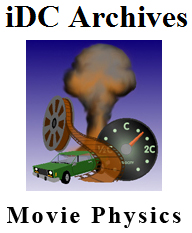
Game Physics
[...] I am at the beginning of some research into the area of game physics (that is, the simulation of physics in video games) ... The research is somewhat motivated by several observations:
Physics has an interesting split personality in that it is viewed as very fundamental in the sciences with a lot of 'prestige' (Einstein is a folk-hero), but at the same time Physics seems to be largely rejected as a discussion topic by non-science educated folks. As soon as it gets a bit more detailed and mathematical, most people will react try to avoid Physics. The current state of physics education (low number of graduates, etc.) confirms this.
Games on the other hand are well on the way (if not already there) to become the most used, most influential, most profitable entertainment medium. Therefore one can safely assume that they exert a significant influence on our culture. This trend which will continue in the years to come, especially as graphics capabilities reach photorealistic levels.
Game Physics is an element in video games that was always present and is even at the root of games (SpaceWar, the first video game was a physics simulation). It is becoming even more common due to the 3D and immersive nature of todays video games, because it makes games 'playable'. Generally it is a very important aspect of games since it is directly linked to the interactivity and 'feel' of the gameworld, but as a topic of game theoretical analysis, it is often overlooked.
As for some specific questions, I am currently interested in a discussion on how games affect the relationship we have with the real world. Obviously there are social implications to video game play as we can see from the whole "violence in games" debate. In relationship to Physics, I am looking at more fundamental changes in how we construct truths: Does video game physics create a form of "folk physics" (my immediate answer would be yes) and does that change the way we think or even act? For readers unfamiliar with video games, think of the 'Movie Physics' - which todays games largely adopt - such as the engine roar of a space ship flying by the camera (... this should be silent in vacuum).
So in some sense, the question extends the common "does it matter that movies have pseudo physics?" discussed extensively on site like http://www.intuitor.com/moviephysics/ to "does it matter when video games have pseudo physics?" (and believe me they do!). Why don't game developers try harder and game players expect more?
If one looks critically at mass media today, are we not creating a whole new "church of entertainment" especially with video games, where - at least as far as physical simulations are concerned - the scientific method and precision becomes irrelevant or at best secondary over the goal of implementing the next, better implementation of a game as 'VR drug' or 'consentual hallucinations' as W. Gibson puts it?
Could the trend we see in the popularity for 'documentaries' - especially ones with a scientific slant such as 'An Inconvenient Truth' be extended to mainstream video games? Personally I feel sad to see that Physics is typically reduced to animating ragdoll-enemies, chaingun-bullets and flamethrower-particles ... so why not extend game physics to include more quantum-mechanics? Maybe this would allow us to bridge the gap between game-cultures and science-cultures.
--AS
Corrado Morgana wrote:
Andreas,
I think you may be misinterpreting the notion of physics within games...it is not to demonstrate science, but physics as in physicality..objects have weight, mass and motion similar to real life objects and are used as ludic elements..that which foster gameplay..check out Half life 2 et al and much indie gaming which, for a while seemed to be obsessed with physics based gaming..it is simulation within set parameters
Folk physics..yup agreed, but you have to consider the role of games, Freelancer is a damn sight more fun than Orbiter, a very realistic, space flight simulator
There are few games which address scientific issues, OK Prey and the soon to be released Portal may look at disjointed physicality (that word again)..but talking about games and quantum mechanics may be more about pedagogic simulation; difficult game premise
However there may be an answer..
Check out Garry's mod for Half life 2...a physics based sandpit that could ideally be used, I think in your terms
Corrado Morgana...games researcher
iDC -- mailing list of the Institute for Distributed Creativity iDC[at]mailman.thing.net http://mailman.thing.net/cgi-bin/mailman/listinfo/idc
List Archive:
http://mailman.thing.net/pipermail/idc/
iDC Photo Stream:
http://www.flickr.com/photos/tags/idcnetwork/
Posted by jo at 12:29 PM | Comments (0)
Red Line Surveillance
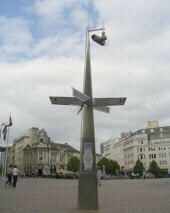
Birmingham
RED LINE SURVEILLANCE - As part of FESTIVAL OF EXTREME BUILDING and NEW GENERATION ARTS FESTIVAL :: June 23-29, 2007 :: Birmingham / UK; On Site (The corner of The Priory Queensway and Moor Street Queensway).
Red Line Surveillance are out to provide security for the city of Birmingham; from a surveillance tower erected on site, mobile monitoring units will emanate through the surrounding urban environment. This project is a collaboration between nine European artists, and has been developed in partnership with the Festival of Extreme Building and New Generation Arts.
Surveillance literally means "watching over", and can be seen as the art of watching over the activities of a person or group from a position of higher authority. Commonly used to describe observation from a distance by means of electronic equipment, it can also involve simple, relatively no- or low-tech methods such as direct observation, observation with binoculars or similar methods.
The surveillance tower will be a monitoring station occupied by personnel 24 hours a day, providing 'security and surveillance' for the site; this presence will be clearly visible through signage, uniformed officers and increasing levels of activity emerging from the tower. These roving patrols will expand from the base into the wider landscape of the city centre, with each reconnaissance mission seeking to find the effective range of this security service and its impact on its surroundings. The collective observation of the city will ensure that no event goes un-noticed!
This process will involve: Ana Benlloch [UK], Pelle Brage [DK], Sabine Hagmann [CH], Andreas Kebelmann [GER], MACHFELD (akaMichael Mastrototaro & Sabine Maier) [A], Ed Orton [UK], Niki Russell [UK], Eliane Rutishause [CH], and Stuart Tait [UK].
Posted by jo at 11:39 AM | Comments (0)
Locus Tangent Return
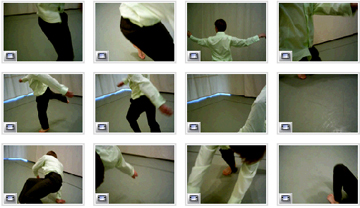
Invitation to Re-Construct, Re-Mix, Re-Choreograph
From Hyperchoreography: The video clips for Locus Tangent Return were shot on 2 DV-5 D'zign HDD camcorders. The dancers improvised movements based on a series of instructions. The focus of these movements was repetition of simple gestures and building complex sequences. Sometimes these would accumulate in length or sometimes they would multiply by superimposing, and sometimes they would take a movement from the other dancer and drop one of their own. On top of this they had to work with the concept of the title: Postion - Locus :: Change - Tangent :: Repetition - Return. Short video clips have been extracted from the recordings and made available for re-construction, re -mixing and re-choreographing to create new works.
Posted by jo at 11:29 AM | Comments (0)
Rafael Lozano-Hemmer

PULSE FRONT: Relational Architecture 12
In association with and linked to Auto Emotion, The Power Plant presents Pulse Front: Relational Architecture 12, a new commission by Montreal-based artist Rafael Lozano-Hemmer. ‘Pulse Front’ features a matrix of light over The Power Plant and Harbourfront Centre, made with light beams from twenty of the world’s most powerful robotic searchlights. The installation is entirely controlled by sensors that measure the heart rates of passersby. Ten metal sculptures with embedded sensors and computers are placed along the harbour where they detect the pulses of people who hold them and convert them into light pulses. Computers also determine the orientation of the beams, recording changes in participants’ physical and emotional states. The resulting effect is a visualization of vital signs, arguably our most symbolic biometric, in an urban scale.
Lozano-Hemmer is an artist who relies on the public to create the work, and claims that he merely orchestrates the tools. While he has exhibited in over 48 countries, ‘Pulse Front’ is his first public interactive installation in Canada. ‘Pulse Front’ is commissioned by and premiered at Luminato, curated by The Power Plant and co-produced by Harbourfront Centre. Presented by TELUS. [Related]
Posted by jo at 11:21 AM | Comments (0)
AUTO EMOTION
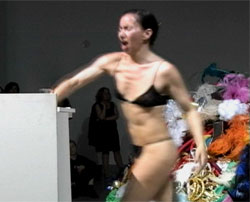
Autobiography, emotion and self-fashioning
[Image: Andrea Fraser, Official Welcome, 2001 -performance, videotape and video installation, 31 min., DVD] The Power Plant presents AUTO EMOTION: Autobiography, emotion and self-fashioning :: 18 May – 19 August, 2007 :: Curated by Gregory Burke and Helena Reckitt.
Despite Conceptual Art’s disavowal of narrative and self-expression, a number of contemporary artists are mining autobiographical and biographical genres. Some artists have not hesitated to express deep feelings about the world, themselves and the artist’s role. Others have wrestled with questions of how to represent the self, sometimes trying to avoid clichés, at others deliberately appropriating them. Drawing inspiration from events in their own lives, and setting up situations that blur the division between art and life, several artists explore art’s potential for transformation and catharsis. ‘Auto Emotion’ includes works that carry an interest in the relationship between social conformism and autonomy, brain chemistry and emotion, automatic behavior and self determination, the fictional and the real.
Performance becomes self-portraiture in Official Welcome (2001) by Andrea Fraser, The Onion (1995) by Marina Abramovic, and during a hypnotized performance given by Matt Mullican. Canadian artist Benny Nemerofsky Ramsay represents the biographical in Live to Tell (2002) and Lyric (2004), where pop songs are represented as folklore both to tell his story, and to investigate notions of clichés as cultural truths. This element is taken into the therapist’s office for artist’s block experienced by Christian Jankowski in the pressure to make new work, or questioned as fictional elaborations of romantic partnerships by a master of disguises, Nikki S. Lee, exposing these states of perpetual flux within the varying personas. Adrian Paci’s Vajtojca (2002) shows the self in the cycle of birth and death, both as an Albanian, and as an artist, when he stages his own funeral and pays a professional mourner to weep for him.
This exhibition is a timely reflection on issues of the complexity of self-representation and deflection, within and outside the art institution as many of the artists in ‘Auto Emotion’ question the role of the artist in society.
Artists: Marina Abramovic, Reza Afisina, Eija-Liisa Ahtila, Sophie Calle, Andrea Fraser, Rodney Graham, Christian Jankowski, Yayoi Kusama, Nikki S. Lee, Rafael Lozano-Hemmer, Matt Mullican, Benny Nemerofsky Ramsay, Adrian Paci, Johannes Wohnseifer.
Posted by jo at 11:03 AM | Comments (0)
June 19, 2007
OFFSHORING SECOND LIFE
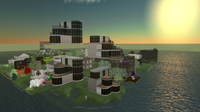
Economic Unreality
"So now, with our active Cayman Residents, the circle of economic unreality is almost surely complete: real money is converted into the currency of a virtual world, which is then converted back into the real money of a semi-virtual country, where it becomes the assets of a company that only exists as a post office box by the Caribbean sea."
Linden Lab's latest user stats include a fascinating tidbit, first unearthed by Celebrity Millionsofus, who used them to compile a list of active users by national origin, then listed these on the blog of Millions of Us (a sponsoring partner of NWN.)
Here are the first ten countries where Second Life Residents are most active, based on the average number of minutes they spend in-world per day, per user: 161 - Cayman Islands; 132 - Indonesia; 130 - Netherlands; 128 - Canada; 122 - United States; 122 - Korea, Republic of; 116 - Russian Federation; 109 - French Southern Territories; 104 - Antigua and Barbuda; 103 - Martinique.
A lot of smaller nations, and a few you might not expect-- a localized version of SL has only recently been released to the South Korean market, for example, and it already boasts 1018 power users.
Second Life's most active Residents, however, are from a country you'd easily recognize, if you read a lot of thriller novels.
Located in the Western Caribbean and a prime destination for scuba divers, the Cayman Islands are a sovereign territory of Great Britain, with a tiny population of some 45,000. But it's mostly known as the world's center for offshore banking and business, the place where companies and wealthy investors from around the globe have their offices and savings, so they can take advantage of the country's low taxes and minimal regulation. (As of 2005, an incredible 70,000 companies are incorporated there.) This encourages a belief that it's a nexus for money laundering and other criminal activities-- it's where Tom Cruise's law office spirits away mob money, in The Firm-- but for what it's worth, an IMF report notes that "the overall compliance culture within Cayman is very strong, including... [that] related to anti-money laundering obligations." In any case, it is where a lot of people from around the world have a lot of their money stored away, when they don't want their own governments taxing or otherwise regulating it. Indeed, besides tourism, managing this activity is the Caymans' only main industry.
And last month, this is where 36 Second Life Residents were, going in-world some 2.7 hours a day, more than Residents from any other country. (Other nations in Celebrity's most active thirty are also known for being offshore bank/tax havens-- Antigua and Barbuda, Aruba, and Netherland Antilles, among others.)
Maybe they're all just tour guides and secretaries who like to play Tringo and dance, in their off hours. But it's entirely plausible to assume at least some of them are in there converting large sums of Linden Dollars to US Dollars and thence to KYD, the Cayman Islands Dollar. (And if they are, I'd hasten to add, there's no reason to suspect anything illegal or unethical.)
No, the point I'd make here is a different one. Over the last several decades, the Caymans have existed as an artificial appendage to the global economy, a country that thousands of corporations call home-- even if their headquarters is a mere mailing address. (And here's a good place to note that corporations are themselves a kind of avatar, a fictitious entity authorized by governments to conduct business as if they were a person.)
So now, with our active Cayman Residents, the circle of economic unreality is almost surely complete: real money is converted into the currency of a virtual world, which is then converted back into the real money of a semi-virtual country, where it becomes the assets of a company that only exists as a post office box by the Caribbean sea.
Pictured: Cayman island of Second Life (not affiliated with RL Cayman Islands.) [blogged by Hamlet on New World Notes]
Posted by jo at 05:50 PM | Comments (0)
Oil Standard

Update (0.2.1)
Michael Mandiberg just uploaded an update to Oil Standard. This version (0.2.1) fixes problems with the crude oil price feed from the mercantile exchange, future proofs the Plug-in & Greasemonkey script against Firefox updates, and enables the Plug-in to auto update itself when future versions of the script are released. If you have a previous version installed, you really should upgrade as your previous version probably doesn’t work…
Direct link to the Oil Standard Firefox Plug-in.
Direct link to the Oil Standard Firefox Plug-in.
Oil Standard is a 2006 commission of New Radio and Performing Arts, Inc., (aka Ether-Ore) for its Turbulence web site. It was made possible with funding from the Jerome Foundation and New York City Department of Cultural Affairs.”
Posted by jo at 05:15 PM | Comments (0)
Second Life Machinima
My Second Life: Episode # 1 was shot entirely in the popular online world Second Life. On one of his visits in SL, Filmmaker Douglas Gayeton came across a series of seven video dispatches by a character named Molotov Alva. It appears that a man by the same name mysteriously disappeared from his real world California home in January 2007. Gayeton put Alva's dispatches together into a documentary of seven episodes. Will he find the answers he's looking for? Go here for the hi-res version.
China Tracy: i.Mirror part 3
[via New World Notes]
Posted by jo at 04:03 PM | Comments (0)
Bill Shackelford
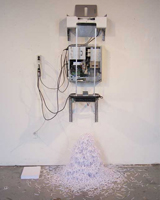
Spamtrap
Spamtrap, by Bill Shackelford, is an interactive installation that prints, shreds and blacklists spam email. It interacts with spammers by monitoring several email addresses he created specifically to lure in spam and an old unused personal email address he uses to lure in spam. Shackelford does not use these email addresses for any other communication. He posts these individual email addresses on websites and online bulletin boards that cause them to be harvested by spambots and then to start receiving spam.
Because he knows that all email sent to these email addresses are spam, he has set the installation to print and then shred each email as it arrives. Simultaneously the installation is feeding spam blacklists on the web with information gathered from all the received spam (a newly added feature). This in turn helps to feed spam filtering systems across the web that are working to reduce the amount of spam we all receive. Click here for more information about Spamtraps.
The installation uses a Pentium II computer connected to a wireless network, personal printer, personal shredder, aluminum rails, Spamtrap email addresses, automatic printing software, email client software, antivirus software, and a SpamCop user account. The paper is recycled after the spam email has been shredded. Video. Related. Via.
Posted by jo at 02:37 PM | Comments (0)
Of money, meaning and artists in residence
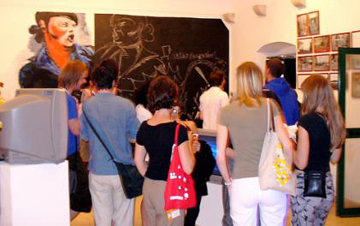
Some commonistas confronted with the exhibition in residence, CC BY 2.0
Shortly before most of my fellow aesthetically challenged comrades arrived in Dubrovnik, whilst the keener iCommoners soaked up the Adriatic sun, a handful of artists in residence were toiling away to produce and curate an exhibition for our benefit. The low level of engagement from practising artists in fields beyond electronica music, academic writing and journalism is a problem familiar to any meeting of free culture communities. So it was a wonderful surprise to sit through a discussion between the artists in residence nominally set-up to discuss their engagment with the 'copyfight' and strategies to build sustainability for peer produced free culture, Less surprising was the theme of the presentations and subsequent conversations; their interest in, and engagement with, the 'commons-based peer production' ideology was varied and complex.
Nathaniel Stern, having been involved last year in Rio, has been trying to build upon that experience to explore how certain 'commons' values might be expressed through participatory sculpture that creates performances. He found a tension between those curated participants who held his frames and members of the public (largely kids) who interacted with the created space, and watching the spontaneity of this interaction certainly made physical and concrete some aspects of peer based production. Quite an irony, trying to replicate a form of production that is itself an abstraction from the concrete production he was engaging in! Or at least that is my interpretation of his work anyway. Nathanel - feel free to comment to the effect that this is a load of tosh!
One comment stood out for me. Joy Garnett, speaking about her experience with the (infamous?) Joywar episode, radically reconceptualised the copyfight. It's not about money, she suggested, it's a battle over meaning. The photojournalist who wanted to obstruct her work was insisting that the meaning of her photograph was intimitely connected to its context - the revolutionary struggle in Nicuragua - and so Joy's painting decontextualised the photo, stripping it of its meaning and artistic integrity. For Joy, the meaning of the work is inherently contextual, i.e. it will depend upon where it is exhibited, how it is exhibited, how it is reinterpreted and transformed by the audience or fellow artist. To constrain art by refusing others the right to recontextualise particular works is completely antithetical to her approach, and arguably to the history of both fine art and culture broadly defined.
In other words, the fight that exploded around that painting wasn't about one copyright owner trying to defend a particular financial interest, nor about a straightforward desire to control her work. It was a battle of critical theory and of aesthetics. Joy became interested in copyright because a key motivation of her work is transgression, and 'permission culture' copyright is one barrier that she finds herself transgressing in a desire to bring forgotten images to the public eye in new forms. She'd face the same barrier if she came across a Creative Commons licensed work that required permission to be sought for commercial use.
This sense that Joy's motivations and approach towards copyright was quite different to the standard Creative Commons discourse ran throughout each presentation. Nathaniel summed it up quite neatly when responding to a question about commercialising Creative Commonc licenses: it's not about using CC licenses to make money, it's about how those licenses relate to and facilitate different artistic practices; where they offer, or assist, a means of making money then so much the better. Ana Husman was refreshingly willing to recognise the public value of her work, and her civic responsibility to share her work freely when she received public funding. Kathryn Smith and Jaka Železnikar recognised that the general ethic of the commons was a natural fit with much of their work. There's a connection, certainly, but CC could hardly be put forward as a central part of their practise.
Too often we can start to view culture (and what a broad term that is!) through the lens of copyright, Creative Commons or even the free software community's norms. When we do this we lose sight of the intense diversity of artistic practice out there, and forget the true import and relevance of our work, so it was really significant to have a space where practising full time artists could discuss their thoughts with their fellow commonistas. [posted by tchance on iCommons iSummit]
Posted by jo at 12:28 PM | Comments (0)
Performance Paradigm 3 (May 2007)
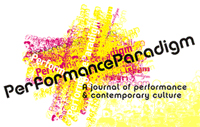
The End of Ethics? Performance, Politics and War
"The announcement of the ‘End of History’ has not produced nor been coincident with an end to the ideological differences encoded within that concept. Instead it has seen an intensification of conflicts which, however local in origin, are global in scope: civilization wars, culture wars, wars on terror and drugs, perhaps a re-emergent cold war? In terms of the local investment in these conflicts, the government led by John Howard in Australia has been an enthusiastic protagonist in these wars and in the absurd parody of ‘situation ethics’ that they have produced. This is the least ethical government in living memory in Australia but it has still been tremendously popular. Perhaps it’s the sheer frankness of this unethical behaviour at the highest level of political life in Australia in the last decade that provokes the question in the title of our issue of Performance Paradigm. But it is not our intention here to rehearse the litany of subtle abuses of ethics in this part of the world or in this period of political history. Nor are we announcing the ‘End of Ethics’ as the ethical correlative to arguments about the ‘End of History’. The title is a provocation to re-think the discourse of ethics in relation to political performance and art, and to re-assert its significance in a time when neo-con furies are unleashed upon the world and, in the global context, war has displaced alternative methods of conflict management and resolution.
In the Australian context, performance has been a significant site of engagement with these issues, as a number of the essays in this issue attest. Some artists have responded directly to a number of the key policy initiatives of the Howard government, particularly in respect of its infamous mistreatment of asylum seekers. But we also see evidence of an international context for this kind of protest, even if it is not in forms of direct action, in which artists and theorists are promoting alternate forms of ethical engagement.
The essays in this issue of Performance Paradigm provide an account of the diverse range of recent performance works in which the possibility of the ethical response to political events is directly broached or even structurally implicated in the work itself..." From the Introduction by Edward Scheer.
You'll need to register (it's free) to read:
Theatre of/or Truth by Maaike Bleeker
Performing war: ‘military theatre’ and the possibilities of resistance by Michael Balfour
Rupture in the Surface: Ethics of the Abject by Horit Herman Peled
Is there a gene responsible for our obsession with perfection? Disability, ethics and responsibility by Lalita McHenry
Performance, Politicians, and War: Selling Iraq in the culture war by David A. Williams
Being Near: Visiting the Rwandan genocide memorial site at Murambi, Gikongoro by Jeff Stewart
Interviews
Art And Politics And The Zürcher Theater Spektakel: Maria Magdalena Schwaegermann talks with Margaret Hamilton
Envisioning Ethics Anew: Rustom Bharucha talks with Performance Paradigm
Pathologies of Hope: Baz Kershaw talks with Performance Paradigm
Book Reviews
Unsettling Space: Contestations in Contemporary Australian Theatre, Joanne Tompkins by Gay McAuley
Making Theatre in Northern Ireland: Through and Beyond the Troubles, Tom Maguire by Rebecca Pelan
Postdramatic Theatre, Hans-Thies Lehmann, trans. Karen Jürs-Munby
Denise Varney
Performance Reviews
I La Galigo. Directed by Robert Wilson. State Theatre, Melbourne International Arts Festival, 19 – 23 October 2006 by Margaret Hamilton
Posted by jo at 10:53 AM | Comments (0)
V.O.S.T.
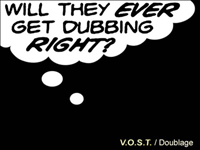
Dubbing/Doubling
V.O.S.T. / Dubbing: video works and video installations about and around dubbing :: June 24, 2007 :: Installations : 5:00 - 8:30 PM :: Video projection and performances: 8:30 PM @ Cinima de La Ginirale, 10-12 rue du giniral Lassalle, M0 Belleville.
The event V.O.S.T. / Dubbing presents video works and video installations that adapt dubbing as a form, that explore the nature of dubbing, but also notions of doubling and the double that impact the relationship between language, image and sound. Installations by Cicile Bicler, Pierre Bismuth, Frederico Camara, RYbN, and Anri Sala; Video projections by Christophe Atabikian, Nicolas Boone, Alexis Chazard, Matthieu Clainchard, Marie Daubert, Yan Duyvendak, Flatdog, Jimmy Owenns, and Michakl Sellam; Performances by Michakl Sellam, and Gwenola Wagon; and Documentary by Cicile Bicler, Alexis Chazard, Maja Drzewinska, and Fanny Martin.
The V.O.S.T. sessions are organized by Alexis Chazard (Cela Etant) and Marika Dermineur (Incident.net). Thanks to the artists, La Ginirale, Mains d'uvres, Ars Longa, Florence Brissard, galerie Chantal Crousel, Vidioart.ch and Cosmic Galerie.
Posted by jo at 10:17 AM | Comments (0)
Digital Contagions:
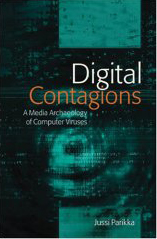
A Media Archaeology of Computer Viruses
Digital Contagions: A Media Archaeology of Computer Viruses by Jussi Parikka (New York: Peter Lang, 2007) :: Digital Contagions is the first book to offer a comprehensive and critical analysis of the culture and history of the computer virus phenomenon. The book maps the anomalies of network culture from the angles of security concerns, the biopolitics of digital systems, and the aspirations for artificial life in software. The genealogy of network culture is approached from the standpoint of accidents that are endemic to the digital media ecology. Viruses, worms, and other software objects are not, then, seen merely from the perspective of anti-virus research or practical security concerns, but as cultural and historical expressions that traverse a non-linear field from fiction to technical media, from net art to politics of software. Jussi Parikka mobilizes an extensive array of source materials and intertwines them with an inventive new materialist cultural analysis.
Digital Contagions draws from the cultural theories of Gilles Deleuze and F?lix Guattari, Friedrich Kittler, and Paul Virilio, among others, and offers novel insights into historical media analysis.
Posted by jo at 09:48 AM | Comments (0)
Avatar Machine
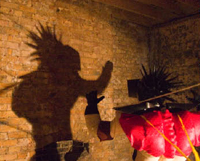
Virtual Reversal
"The virtual communities created by online games have provided us with a new medium for social interaction and communication. Avatar Machine is a system which replicates the aesthetics and visuals of third person gaming, allowing the user to view themselves as a virtual character in real space via a head mounted interface. The system potentially allows for a diminished sense of social responsibility, and could lead the user to demonstrate behaviours normally reserved for the gaming environment."
That was the blurb i read on the website of Charming Disaster, an exhibition featuring several works created by students of the Royal College of Art’s Design Products department (thanks Noam for telling me about it!) What i like about Avatar Machine is that, like the One Eye Ball but unlike several similar projects i've blogged in the past, it's not just about coming up with a nice, funky, geeky project before everybody else, it is also a very eye-pleasing work. I love the way that the designer pushed the concept further by making the user wear the costume of an avatar, i imagine that it allows observers to participate (albeit in a much more discreet way) to the experience. So i asked design student Marc Owens to tell me more about the work.
How does it work technically?
The system works in a very simple way. The user wears a body harness, which has three 2m long aluminium rods protruding from it, to form a type of tripod. A wide angle pinhole camera exists at the point where all three rods meet. The camera is pointing directly back at the user. The video footage being recorded by the camera is transmited to the monitor inside the headset so it can be viewed by the user. Therefore the user can see themselves in the third person, from head to toe on the monitor interface.
It is WoW that inspired the kind of costume that the player has to wear in your installation, did i get that right? Any reason why you chose to refer to WoW?
You are correct in thinking that the project is World of Warcraft inspired. As the worlds most popular online game, the asthetics and characters of WOW are the most easily recognisable, also i wanted the character i created through the costume be be large in stature, so the user could experience a sense in invincibility when controlling the avatar on the interface. Also, WOW, is more classically fantasy based than other MMORPGs, like second life for example, so that is an element i wanted to bring into the experience of the product.
Thirdly, i am ashamed to admit, quite a fan of World of Warcraft!
Which kind of behaviour did you observe when visitors of the Charming Disaster were playing with your work?
At the Charming Disaster show a few weeks ago, the screen within the headset burned out after an hour into the performance. So only one or two people had the opportunity to experience the system. However since then, i have carried out some avatar sessions in Hyde Park, allowing ample room for the user to do as they wish, and behave as they like.
The types of behaviour i observed were all quite similar. That being, everyone was quite cautious with their movements to begin with, moving around with baby steps as they slowly got used to controling their movement from the third person perspective. After a few minutes, users began to gain confidence not only with faster and more fluid movement, but also began to mimic the types on movement that they imagined the avatar would demonstrate, ie: stoping around and swinging of arms. Another element to the type of behaviour i observed was that after getting used to using the system, users felt comfortable enough to approach passing 'humans' and observed their reaction through the interface.
All images courtesy of Marc Owens. [blogged by Regine on we-make-money-not-art]
Posted by jo at 08:31 AM | Comments (0)
r4wb1t5 (rawbits) macro/micro-fest
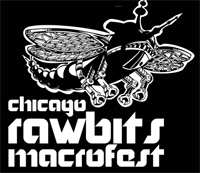
Mexico-Chicago
r4wb1t5 - Festival of Electronic Art :: June 20-24, 2007 :: Centro Multimedia, CENART, Casa Vecina Centro Cultural La Piramide, Mexico.
r4WB1t5 micro.Fests in Mexico City will build contextualized, temporary and contingent social structures in the forms of interconnected New Media Art Festivals, Sound Art Events, Social Software, Open Networks of Collaboration and Realtime Audio and Video Performances. These handcrafted digital systems and timespaces will operate as open ports and collaborative situations. Selected artists from Chicago will inhabit these open sourced software architectures hosted by institutions, organizations and individuals in Mexico City. Artists in Mexico City will collaborate and continue conversations initiated by the MEXICAN r4wb1t5 macro.Fest hosted in Chicago during April 2006.
r4WB1t5 micro.Fests are international, decentralized, self-organized and independent festivals of raw bits of digital art and dirty new media. (A) r4WB1t5 micro.Fest is itself an open platform or framework for creating these events in alternative and conversational contexts such as bars, basements, lofts, art spaces, apartments, galleries, online video game environments and other networked spaces. (A) r4WB1t5 micro.Fests extend out of and feeds back into DaDaist, Situationist, Fluxist, punk, digital art and New Media theorypractices, histories, possibilities and positionalities. (A) r4WB1t5 micro.Fests are always free and open collaborative projects, available to anyone interested in self-organizing Digital Arts and dirty New Media.
Posted by jo at 08:01 AM | Comments (0)
June 18, 2007
Bloomsday on Twitter
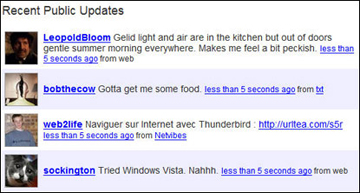
Bloomsday on Twitter: A performance of Wandering Rocks on Twitter, and a commentary on both. Created by Ian Bogost and Ian McCarthy :: I do not like Twitter, the micro-blogging service that allows users to send short (SMS-sized) text-based updates that are displayed publicly and shared with friends social-network style.
For me, Twitter represents the worst trends in the new internet culture. It purports to allow people to "communicate" in new ways, a promise that mostly creates new obligation and infatuation to stay "up to date" and "connected." In the world of Twitter, you (and me, and everyone) pay constant, tiny homage to a new gimmickry.
This is a gimmickry that doesn't even rise to the level of the gadget, with its industrialist promise of technological progress. It is a kind of softer soft-pornography determined to make identity-assertion the new masturbation. Russel Davies' Twitter parody Dawdlr comments on this trend, asking users to send updates via postcard.
In the world of Web 2.0, a public sheds the chains of a tightly-controlled mass media market in which individuals are converted into the "consumers" needed to purchase mass produced goods and services. In its stead, that public gets a loosly-controlled micro media market, in which individuals are converted into the "users" needed to create databases for sale to Google or Yahoo! or News Corp for $35 a head. But now the market outsources manufacture to those very "users." The workers may have had nothing to lose but their chains, but the users are lining up to link their own together. It's the new fashion; chains are the new black.
Invective like this may amuse, but it doesn't necessarily change opinion or create discussion. My friend and sometimes-collaborator Ian McCarthy and I had been talking in San Francisco recently, looking for an intervention that would both comment on Twitter as a social force and also attempt to use the service in a culturally interesting way. What if the focus on socialization and identity is actually the least interesting way to use Twitter?
So, here's what we came up with.
Today, like every June 16, is Bloomsday, a holiday that celebrates James Joyce and his novel Ulysses, which takes place on this date in 1904. Ulysses already offers a parallel commentary; Joyce conceived of the book's principal character, Leopold Bloom, as an everyman counterpoint to Odysseus, whose adventure Bloom's parallels. Each of the book's 18 chapters take place in roughly an hour's time.
The 10th of these, Wandering Rocks, follows 19 Dubliners walking through the city, doing their daily business, some intersecting with others. It's a famous and often-studied section of the book, one that also speaks to an experience of urban modernity that has become second-nature to us now.
Enthusiasts often retrace the characters' steps on Bloomsday, and innumerable animated maps and the like have been created by fans and scholars. The latter technique still doesn't really represent the interleaved simultaneity of Wandering Rocks, the complexity yet ordinariness of space and interaction that Joyce's writing accomplishes. And the former technique turns the ordinariness of the episode into a kind of theme park, missing the importance of the Wandering Rocks as a vignette of the scenario that grounds the rest of the novel (I've written about this theme more in relation to videogames in a chapter of my book Unit Operations).

We took Wandering Rocks and adapted it into a large series of 140-character or less utterances in the first person. We organized and timed these and built a database for them. We registered key characters in the novel as users on Twitter. For example:
STEPHENDEDALUS: I see Dilly's high shoulders and shabby dress, shut the book quick, don't let see.
Then we wrote some software to automate the performance of Wandering Rocks on Twitter, so basically we just turn it on and it runs. The result, we hope, will offer both an interesting and unique perspective on the novel and on Twitter. I'll let our critics be the judge of that.
Bloomsday tradition normally demands that festivities take place on Dublin time, which is unfortunately 6 hours ahead of the US East Coast. Wandering Rocks starts at 2:55pm, which is barely the crack of dawn (especially on a Saturday) out on the West Coast. So we decided to synchronize our performance to EDT. If you wish, you can watch the public stream on Twitter starting at 2:55pm EDT. You can also watch the individual characters, or even add them as "friends" to get the updates.
Update: the performance is now completed; while there were a few hiccups that made a very small minority of the characters unable to participate, the vast majority worked as planned, and you can now click through to read their contributions. I'll put together some documentation of the live version to share soon.
BUCKMULLIGAN
STEPHENDEDALUS
[go to post for live links]
LEOPOLDBLOOM
BLOOMSCAT
BLAZESBOYLAN
JOHNCONMEESJ
ONELEGGEDSAILOR
WIFEOFSHEEHYMP
BRUNNYLYNAM
DENISJMAGINNI
MRSMGUINNESS
BLONDEINTHRNTNS
HELYS
MISSDUNNE
TOMROCHFORD
SATCHELLEDBOYZ
NOSEYFLYNN
MCOY
LENEHAN
JJOMOLLOY
UNLABORINGMEN
CORNYKELLEHER
CONSTABLE57C
THESHOPMAN
EARLOFDUDLEY
OLDWOMANONTRAM
PATRICKDIGNAM ALMIDANO
THELACQUEY
DILLYDEDALUS
SIMONDEDALUS
HAINESINDUBLIN
JOHNPARNELL
ELIJAHISCOMING
KATEYDEDALUS
BOODYDEDALUS
MAGGYDEDALUS
MISTERKERNAN
NEDLAMBERT
CLERGYMANJACK
FRBOBCOWLEY
DENISBREEN
BENDOLLARD
CASHELFARRELL
BLINDSTRIPLING
DUDLEYWHITE
RICHIEGOULDING
THEPODDLERIVER
2SANDEDWOMEN
THEPOLICEMAN
MARTNCUNNINGHAM
JOHNWNOLAN
HORNBLOWER
MANINMACINTOSH
Late last night, partly to test and partly to put a stake in the ground, we did perform the first ten minutes of the novel properly synchronized to Dublin time.
Happy Bloomsday!
[blogged by Ian Bogost on bogost.com/blog] [Related]
Bloomsday On Twitter
Perhaps one day we will remember Twitter as the peak of exhibitionism on the Internet, a phenomenon that started with blogs and social networks. It is hard to imagine anything more compulsive: Twitter is a community of thousands of people who publish brief messages answering the simple question "what are you doing right now?". It is a sort of self-imposed big brother, a Babel of self-referential statements ("I'm checking my email", "I'm buying a computer on eBay"), a massive collective stream of consciousness. On June 16, in Dublin, there are celebrations for the Bloomsday, a day of cultural activities centered on James Joyce's Ulysses. Among the most important events of that day is the reenactment of day of Leopold Bloom, the odissey of the common man that unravels on the streets of Dublin in a single day. What do the most important novel of the twentieth century and the most extreme platform of web 2.0 have in common? Nothing, or so it was before the last June 16, when Ian Bogost and Ian McCarthy, game designers and non-linear narration researchers, chose Twitter as the stage of a strange online performance. The tenth chapter of Joyce's Ulysses, that narrates simultaneously the lives of nineteen citizen of Dublin was adapted to microblogging. The original text was broken down into fragments and inserted into a database for a computer program to read and publish as messages on Twitter at the right times, signed with the names of the characters/users. The result is a bizarre short-circuit between time and space units, between high and low culture. Characters from a novel are animated by a machine and their voices mix with those, paradoxically more artificial, of real human beings. The performance, coherently with the pace of that chapter, lasted only an hour, and it probably wasn't noticed by the users of Twitter, lost as a drop in an ocean of communicating solitudes. - Paolo Pedercini, Neural.
Posted by jo at 06:49 PM | Comments (0)
The Art Happens Here: The Full Exhibition Review by Paddy Johnson
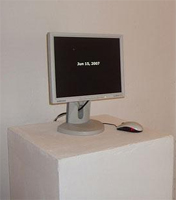
@ iCommons iSummit 2007
[...] Individual works are of varied success, largely reflecting the portability of the artist’s practice. In that respect probably the most successful work in the show, came from the New York art collective MTAA whose net art piece On Kawara Update displayed beautifully on an “antique” computer screen dating to (I’m guessing) the early 90’s. Unlike some many art titles that leave viewers befuddled, this work tells you exactly what the piece does. Drawing upon the canonical On Kawara’s “Today Series”, an ongoing project whereby the artist creates Spartan black canvases with only the date, and a separate collection of news clippings from the day, MTAA’s update recreates that same canvas for the web as a splash page displaying only the date which is also a link to a program that pulls news stories from that day with Creative Commons licenses [editors note: apparently most newsfeeds are CC licensed so MTAA decided it wasn’t worth the effort to make a specific filter]. Now, to be honest, I’ve always had problems buying into the original series MTAA draw inspiration from, namely because the artist spent a life time doing the project without apparently getting bored of it. For me, this piece immeasurably improves the latter not only because the filter [if it existed] adds a layer of specificity to the work, but by automating the repetitive aspect of the work, thereby eliminating criticisms lodged against artists who remake the same piece through out their lifetime...." Read the full review at iCommons iSummit 2007.
Posted by jo at 05:55 PM | Comments (0)
UpStage version 2
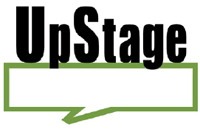
Launch
You are warmly invited to join the UpStage team to celebrate the launch of UpStage version 2 :: June 28, 5:30-7:00 pm :: New Zealand Film Archive (cnr Taranaki & Ghuznee Streets) :: To mark the software launch an exhibition, Puppets to Pixels – an interactive playground for children of all ages, will run at the New Zealand Film Archive Gallery from June 28 - July 15. And 070707, a festival of UpStage performances, takes place on July 7, online and screened simultaneously at the Film Archive.
UpStage is a ground-breaking web-based venue for live, online performance. First launched in 2004, it’s time for the second release with improvements to the interface and innovative new features. UpStage V2 has been developed by Avatar Body Collision and Douglas Bagnall, with funding assistance from the Community Partnership Fund of the Digital Strategy, and the generous support of sponsors CityLink, MediaLab and Auckland University of Technology.
Posted by jo at 05:09 PM | Comments (0)
Upgrade! Tel Aviv-Jerusalem

Yael Kanarek
Upgrade! Tel Aviv-Jerusalem: "Object of Desire" - Yael Kanarek (IL/USA) on the occasion of her new show in Israel :: June 16, 2007, 21:00 :: @ Daila, Shlomtsion Hamalka st. 4, Jerusalem :: Free Entrance.
Object of Desire is the third chapter in World of Awe, and online travelogue (www.worldofawe.net) that chronicles a search for lost treasure in a parallel world called Sunset/Sunrise. The project imagines a post-gender and post-national protagonist. Born from an observation that language defines borders and territory on the Internet, Object of Desire examines these borders, as the chapter is written in three languages: English, Arabic and Hebrew. To raise the notion of physicality of the Internet, the fifteen scenes of the online project download from servers in four locations---New York, Tel Aviv, Ramallah, and Izmir.
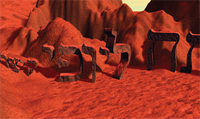
During the artist's talk, Yael will guide the audience through several scenes, point to memes born in the Middle East and Mediterranean that are present in contemporary culture, and talk about her upcoming solo exhibition at Nelly Aman's gallery, opening July 1 in Tel Aviv.
Since 1995, Yael Kanarek has developed a unique project using photography, text, sculpture, and performance. For the past decade she has integrated a range of media into a hypertext system with epic proportions titled World of Awe. Grounded with an original narrative that expands the ancient tradition and genre of a traveler's tale, Kanarek's World of Awe explores connections between storytelling, travel, memory, and technology. With a solo exhibition slated for 2007 at the Jewish Museum, Kanarek has been recognized internationally with a Rockefeller New Media fellowship, the Netizens Webprize, and the CNRS/UNESCO Lewis Carroll Prix Argos in France. Selected for the 2002 Whitney Biennial, she has received grants from the Jerome Foundation Media Arts, New York Foundation for the Arts, and commissions from the San Francisco Museum of Modern Art, Turbulence.org, and The Alternative Museum. Kanarek has also held residencies at Eyebeam and Harvestworks. Her work has been written about in The New York Times, Le Monde Interactif, Tema Celeste, ARTnews, Time Out, Flash Art Italy, Firma, Paper, Wired, The Journal News, ArtByte, and Internet Art by Rachel Greene. In 2000, Kanarek founded Upgrade!, an international network of artists and curators.
Posted by jo at 02:20 PM | Comments (0)
Collaboration:

New Ways of Learning and Working Together
If one principle could be seen to inform the opaque surface of what in the 1990s was called a "new economy" – the shifts and changes, the dynamics and blockades, the emergencies and habit formations taking place within the realm of immaterial production – it would certainly be: "Work together".Facing the challenges of digital technologies, global communications, and networking environments, as well as the inherant ignorance of traditional systems towards these, 'working together' has emerged as an unsystematic mode of collective learning processes.Slowly and almost unnoticeably, a new word came into vogue. At first sight it might seem the least significant common denominator for describing new modes of working together, yet "collaboration" has become one of the leading terms of an emergent contemporary political sensibility.Often collapsed into the most utilitarian understanding, 'collaboration' is far more than acting together, as it extends towards a network of interconnected approaches and efforts. - Collaboration: Seven notes on new ways of learning and working together by Florian Schneider, NOEMA.
Posted by jo at 12:19 PM | Comments (0)
alt.SPACE Festival 2007
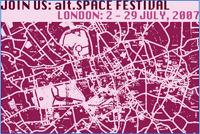
Radical & The Revolutionary
alt.SPACE Network of Artist Research Groups presents alt.SPACE Festival 2007: The Radical & The Revolutionary :: It is time for the third annual alt.SPACE Festival. This time it will take the form of a month-long peripatetic symposium, criss-crossing the urban wilderness that is London in a variety of ways, through a variety of means and involving a variety of events and activities ranging from dinner parties, picnics and informal walks, to project presentations and discussions, to more theoretical papers and a concluding 24 consecutive hour long conference.
The overall theme this year is The Radical and the Revolutionary. What is the validity and usefulness of these concepts in terms of contemporary, and future, forms of politically engaged cultural practice? Can they be reclaimed, rendered affirmative and dissentious tools, and if so, how? What kind of histories can we access and how do we access them? What strategies are ours to employ? What forms of linkages and connections, what kinds of networks and collaboration? This year the overall theme will be engaged with from four perspectives each of which involved its own set of events and activities: *Sound*, *Cartography*, *Illegality*, and *Dissemination*.
*This year also sees* the launch of *alt.SPACE Radio* - our IT-radio station which will broadcast much of the festival and many other forthcoming alt.SPACE events. Additionally, the festival celebrates the very first issue of our journal: *alt.SPACE hardCOPY. *Please see www.altspace.info for further details.
*Come join us.* All events are free of charge. Everyone is welcome. For some events we ask you to let us know beforehand, particularly those that involve public space meetings or preparatory readings or discussions. It's all very informal and convivial. We look forward to seeing you. If you have received this directly from the alt.SPACE Network you will receive updates as of the specific events of the festival: specific speakers, presentations and other details will be announced week-by-week. If you did not receive this email directly from us but wishes to continue to receive these updates, please feel free to join our mailing list. Simply visit www.altspace.info and follow links for 'workspace' and then 'mailing lists' for directions.
Posted by jo at 11:57 AM | Comments (0)
Gallery TPW presents
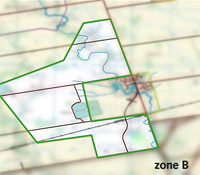
Dubious Views
Dubious Views: Questioning Institutional Representations in Tourism and Cartography :: Curators: Michelle Kasprzak, Michael Alstad, Shawn Micallef :: A bilingual online exhibition produced by Gallery TPW and funded by the Virtual Museums of Canada.
Every time you open your eyes, a hundred different sources vie for your attention. This spectacle - the cacophonous accumulation of images superimposed over the "real" world - is built by everything from advertisements to entertainment to government. This institutional view of the world can come to stand in for and suppress any other visions or versions that might be out there.
The artists discussed in Dubious Views address the role of the "institution" in terms of its effect on the understanding of place. It is examined in relationship to the tourism industry, and in the context of mapmaking and geography. In both cases, the artists involved look at and play with creating alternatives to the institutional view, and attempt to challenge its singularity, its authority, and its monolithic profile.
Artists include: David Rokeby, Surveillance Camera Players, Michelle Teran, Proboscis, Sylvia Grace Borda, Janet Cardiff, Eugene Atget, Nikki S. Lee, Charles Marville, Roger Minick, [murmur], N.E. Thing Co., Shelley Niro, Louise Noguchi, Mitch Robertson, Ed Ruscha, Camille Turner, Jin-me Yoon, and more.
Posted by jo at 11:50 AM | Comments (0)
GameScenes:
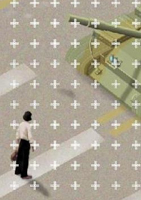
Art in the Age of Videogames
GameScenes: Art in the Age of Videogames :: Edited by Matteo Bittanti and Domenico Quaranta, this volume provides a detailed overview of the emerging field of Game Art, examining the complex interaction and intersection of art and videogames. Text in English and Italian.
Video and computer game technologies have opened up new possibilities for artistic creation, distribution, and appreciation. In addition to projects that might conventionally be described as Internet Art, Digital Art or New Media Art, there is now a wide spectrum of work by practitioners that crosses the boundaries between various disciplines and practices. The common denominator is that all these practitioners use digital games as their tools or source of inspiration to make art. They are called Game Artists.
GameScenes. Art in the Age of Videogames explores the rapidly expanding world of Game Art in the works of over 30 international artists. Included are several milestones in this field, as well as some lesser known works. In addition to the editors' critical texts, the book contains contributions from a variety of international scholars that illustrate, explain, and contextualize the various artifacts.
Posted by jo at 11:49 AM | Comments (0)
Superfactory(TM)
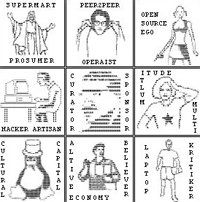
ASCII MEMEX Game "Be A Winner!"
A Memex Wall by Superfactory(TM) in a cooperation with mi_ga :: Rapid flow of letters and numbers on a monitor wall has nothing to do with chaos theory which can cause big disruptions in our world. It has also nothing to do with hackers world as one would like to say. Thus we show the monitor wall within a context of "memex game" a "memory extender" game, the term of which was used to call a proto-hypertext computer system influencing the development of subsequential hypertext and intellectual augmenting computer systems.
A "memex game" is a visual translation of that complex systems proposed by Vannevar Bush back in 1945. Here you get to know exciting people of the scene - the hacker artisan, the peer-to-peer oparist, the open source ego, etc. - all necessary to build up a more or less complex structure of contemporary economy and politics. The monitor wall or a Bookshelf how originally was called, represents a network traffic translated into descriptive form, so the unseen side of "networking" would be understandable or at least readable. In a technical terms the flow of letters and numbers on the monitors would sound like 'tcpdump', a common computer network debugging tool.
In the game you have to find certain motives with as few clicks as possible and as quick as possible. With click on 'neues Spiel' (new game) for a short time nine pictures are shown, whose situation must be reminded! You start the game with 100 points, each second is started one point is taken and each wrong click costs 3 points. Score as much points as possible and be a winner! Much fun and success!
Posted by jo at 11:43 AM | Comments (0)
Turbulence Artists' Studios
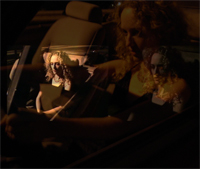
Boulevard by Peter Horvath
Turbulence Artists' Studios: Boulevard by Peter Horvath :: DSL / Cable access, Internet Explorer 5.0+ or Safari and the Flash 9 plugin are required for viewing.
In "Boulevard" we follow a striking woman, the passenger of a convertible car, driven by an unidentified driver through the city, passing its generic streets, billboards and motels, with an unknown destination.
"Horvath's videos have a sense of grand drama; frenetic, contemporary anxiety; and an interest in the collision of the beautiful with the grave. This drama of sexual angst has shades of David Lynch's Mulholland Drive and the edge-of-the-earth angst of contemporary California Gothics such as Magnolia and Crash. The central figure is a by-turns haughty and vulnerable beauty, one of Horvath's reoccurring angst-laden women passing through the glamorous and tawdry landscape of Los Angeles' Laurel Canyon." - Felicia Feaster
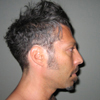
Peter Horvath works in video, sound, photo and new media. Camera in hand since age 6, he inhaled darkroom fumes until his late 20's, then began exploring time based art processes. He immersed himself in digital technologies at the birth of the Web, co-founded 6168.org, a site for net art, and adopted techniques of photomontage which he uses in his net and print based works. Exhibitions include the Whitney Museum Of American Art' s Artport, the 18th Stuttgarter Filmwinter (Stuttgart, Germany), FILE Electronic Language International Festival (Sâo Paulo, Brazil), Video Zone International Video Art Biennial (Tel Aviv, Israel), the Musée national des beaux-arts du Québec (Québec City, Canada), as well as venues in New York, Tokyo, London, and numerous net.art showings. He is the recipient of commissions from Rhizome.org at The New Museum, NYC (2005) and Turbulence.org/New Radio and Performing Arts, New York (2004). A founding member of the net.art collective Hell.com, he likes to consider a future when high bandwidth will be free.
Posted by jo at 11:30 AM | Comments (0)
June 15, 2007
(re)Actor2: The Second International Conference on Digital Live Art
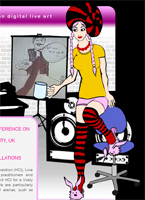
CALL FOR PAPERS, INSTALLATIONS & PERFORMANCES
(re)Actor2: The Second International Conference on Digital Live Art: Bad Girls, Gadgets & Guerrilla Performance :: Broadcasting House & Leeds Met Gallery, Leeds Metropolitan University, UK :: September 10th, 2007.
Digital Live Art is the intersection of Human-computer Interaction (HCI), Live Art and Computing. (re)Actor2: The Second International Conference on Digital Live Art seeks to bring together practitioners and academics from the varying worlds of Live Art, Computing and HCI for a lively debate and event which will explore this emerging field. We are particularly interested in unanticipated performance spaces and playful arenas, such as festivals and nightclubs.
This year's theme, BAD GIRLS, GADGETS & GUERRILLA PERFORMANCE focuses on women who are practicing at the intersection of Computing and Live Art. In focusing on women, Computing and the Arts, this year we look to celebrate the diverse skills, knowledge and experience that women bring to the field. It is our hope that bringing these people together will foster an environment for mutual learning, mentoring and support. Proposals and participation are welcomed from all genders.
KEYNOTE
Our keynote presentation this year will be from the Guerrilla Girls of New York. In 1985, a group of women artists founded the Guerrilla Girls. They assumed the names of dead women artists and wore gorilla masks in public, concealing their identities and focusing on the issues rather than their personalities. Between 1985 and 2000, close to 100 women, working collectively and anonymously, produced posters, billboards, public actions, books and other projects to make feminism funny and fashionable. At the turn of the millennium, three separate and independent incorporated groups formed to bring fake fur and feminism to new frontiers. Guerrilla Girls, Inc. was established by two founding Guerrilla Girls and other members to continue the use of provocative text, visuals and humor in the service of feminism and social change. They have written several books and create projects about the art world, film, politics and pop culture. They travel the world, talking about the issues and their experiences as feminist masked avengers, reinventing the “f” word into the 21st century. They could be anyone; they are everywhere.
VENUE – DAYTIME EVENT
As before, this year we include both a daytime and evening event. The formal daytime event will take place in the old BBC Broadcasting House, a newly refurbished building at Leeds Metropolitan University on Monday, September 10th, 2007. The day will consist of keynote presentations, formal papers and interactive installations. Leeds Met Gallery will curate a special exhibition which will see some of the accepted proposals exhibited in the gallery during the conference.
EVENING AFTER PARTY
The daytime event will be followed by an exhilarating after party with commissioned installations, DJs, VJs and live performances in the vibrant city of Leeds. Commissioned performances will be followed by the incredible Lost Vagueness http://www.lostvagueness.com/ of Glastonbury fame. Over the years, Lost Vagueness has picked up a reputation for being the most anarchic and culturally twisted location at the festival, a place where performers and guests languish together in the warped decadence of the surroundings. This will be the first time Lost Vagueness has performed in the city of Leeds.
FUNDING
We have a limited number commissions available for live performances and installations. You can make a request for funding when you submit your proposal. We also have a limited number of travel bursaries available for those who may not be otherwise able to make it to the conference.
PROPOSALS
All proposals will be peer reviewed by the conference committee. Proposals must not exceed the 2-page limit and must be prepared using the conference publications format provided on our website. However, you may provide additional info (links to digital material including online video, photos and websites) using the third page of the proposal template. We are accepting proposals for:
* academic paper presentations (day)
* live performances (including DJ/VJ sets) (day and evening)
* interactive installations (day and evening)
Topics of interest included but definitely not limited to:
• Technology as a vehicle for social and peformative interactivity
• Human-computer interaction and intervention
• Women, performance and technology
• Audience behaviour and rules of engagement in interactive works
• Non-complicit performance
• Stumble performance and digital live encounters
• Guerrilla interventions
• Performative contracts – rule making and rule breaking
• Digital/live performance and the club space
• Experimental visual and sonic interfaces for live performance
• Performance and social infection
Accepted proposals will be published in the conference proceedings and included on our website. Following last year’s conference, participants were invited to submit their papers to a special edition of the International Journal of Performance Arts and Digital Media on Digital Live Art (2007 - Intellect Press). A similar publication will be produced from this year's conference.
IMPORTANT DATES
Proposal submission deadline: 28th June, 2007
Notification of acceptance: 28th July, 2007
Conference date: September 10th, 2007
(re)Actor DIRECTORS
Jennifer Sheridan, BigDog Interactive
Alice Bayliss, University of Leeds
CONFERENCE CHAIRS
Rebekka Kill, Leeds Metropolitan University
Alice Bayliss, University of Leeds
Jennifer Sheridan, BigDog Interactive
EVENT ADMINISTRATION
Patsy Robertshaw, Leeds Met University
CONFERENCE COMMITTEE
Maribeth Back, FX PAL, California
Christopher Baugh, University of Leeds
Steve Benford, University of Nottingham
Joanna Berzowska, Concordia University
Teresa Brayshaw, Leeds Metropolitan University
Daniel Brine, Live Art Development Agency, UK
Susan Broadhurst, Brunel University
Nick Bryan-Kinns, Queen Mary, University of London
Linda Candy, University of Technology, Sydney
David Collins, Doncaster College
Beatriz da Costa, University of California
Steve Dixon, Brunel University
Jon Dovey, Bristol University
Linda Drew, Chelsea College of Art and Design
Matt Fenton, Nuffield Theatre Lancaster
Geraldine Fitzpatrick, University of Sussex
Bill Gaver, Goldsmiths University of London
Gabriella Giannachi, University of Exeter
Ceri Hand, Metal, Liverpool
Rania Ho, Korean Advanced Institute of Culture & Technology
Moira Innes, Leeds Met Gallery
Clare Jackson, Axis
Lois Keidan, Live Art Development Agency, UK
Boriana Koleva, University of Nottingham
Charles Kriel, London Metropolitan University
Annie Lloyd, Leeds Metropolitan University
Suzy Mason, Speedqueen, UK
Jill Morgan, Leeds Metropolitan University
Angela Piccini, Bristol University
Sita Popat, University of Leeds
Michelle Teran, Artist, Canada
Mick Wallis, University of Leeds
Sponsored by the Arts Council of England, University of Leeds, Leeds Metropolitan University, BigDog Interactive and Nokia. Jointly organised by the School of Performance and Cultural Industries – University of Leeds, Leeds Metropolitan University and BigDog Interactive
Posted by jo at 03:14 PM | Comments (0)
Second Life
Posted by jo at 01:15 PM | Comments (0)
June 14, 2007
SMS2Wall + Mobile Whispers
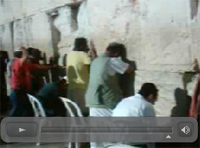
Your Prayers Delivered to the Western Wall
SMS2Wall is a result of an effort to enable people all around the world to communicate their intimate messages to the Western Wall, directly from their mobile phones. Whatever the wish, prayer, hope or thought you would like to address to Western Wall, all you have to do is to compose text message (SMS) with the text: WALL (space) your message and send it to 46898. We will print out your message and (without revealing the message or your personal data) place it as a note into the Western Wall in your behalf.
Every week we will publish a video of the notes being placed in the Wall, so you can verify that your message has indeed reached its destination. You are welcome to use this service whenever you feel the need to express your inner self and reach to Western Wall. It is our imperative to treat you and your intimate message in a decent and professional way, emphasizing the attention and respect for privacy and prompt service.
Mobile Whispers is a global platform with the goal of aiding people all over the world in their spiritual and emotional needs, regardless of race, nationality or religion. We utilise the latest (mobile) technology in closing the distances in time and place and enabling communication between people and their intimate destinations, ensuring the highest sense of responsibility and respect to people's privacy and their inner values. Together with our network of worldwide mobile and internet connections combined with our proven technology and operated by experienced and knowledgeable team, we are able to deal with each request promptly and in the highly professional manner. Our vision is to bring closer people and places. We are working intensely to develop new and meaningful services each time.
Posted by jo at 07:21 PM | Comments (0)
Conor McGarrigle's
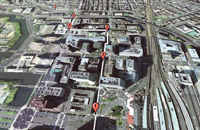
Joyce Walks
Joyce Walks a new project by Conor McGarrigle: Because somewhere, sometimes it's always Bloomsday. Every June 16th in Dublin Joyce enthusiasts celebrate Bloomsday with re-enactments of events from Ulysses. Unfortunately not everyone can be in Dublin for that day but why should that stop you celebrating Bloomsday where you want when you want. So as Bloomsday approaches we announce Joyce Walks a web 2.0 service which will let you map routes from Ulysses to any city in the world so that Bloomsday can be celebrated in any place at any time.
Joyce Walks is a psychogeographical tool which generates walking maps based on routes from James Joyce's Ulysses in any city in the world using Google Maps. The system prints maps to be used as the basis of walks exploring the city of your choice and generates mashups using your pictures and videos documenting these walks to share with other users.
Inspired by the Situationist idea of the Derive Joyce Walks seeks to provide the walker a means of exploring the urban environment which is unique, truly random but removed from a reliance on chance. Although based on a fixed route each map generated is unique as it is based on an individual selection by the user of the center point of their chosen city thus every map provides the walker a means of exploring the urban environment which although based on routes which are predetermined according to a strict adherence to a text is individual to them. Of course removing these routes from Dublin removes specific spatial relevance but they still retain an aura of association which creates a link between the locations and Joycean Dublin.
Joyce Walks saves every map generated to a database. These walks, in addition to being specific to their creator, form part of a continuum where each specific walk performed by any user of the system is added to an searchable archive of unique performative walks from around the world. This archive over time will become a tool to explore and view many unique walks in many cities around the world creating a veritable web 2.0 psychogeographical rough guide.
Requirements: Firefox or Safari browser , in this beta version Internet Explorer is not supported, support for IE will be added shortly. Due to copyright issues between Google and the British Ordnance Survey cities in the UK and Northern Ireland are not searchable, we are working to find a solution for this.
Posted by jo at 06:03 PM | Comments (0)
LOCATIVE MEDIA IN THE WILD
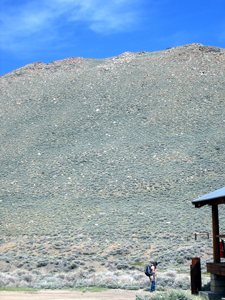
Student Explorations
In the Spring quarter of 2007 at UCSD, a group of particularly rugged and conceptually edgy students volunteered to take contemporary computing topics to the wild. Venturing to the White Mountains, near the Nevada state line, and adjacent to Mount Whitney and her Sierras, the students inhabited the UC White Mountain Research Facility. Their art's practices took them out into the topography... see what they did.
Artists: Zane Andre, Christopher Baker, Adriana Barraza, Heather Clark, Sara Gevurtz, Jonathan Huntoon, Andrew Kim, Gen Kobayashi, Jose Lopez, Sarah McClelland, Christina Tam, Christin Turner, Ryan Velasquez, Thao Vo, Britni Wenck.
Projects: 37°29'59"N, 118°10'06"W, A Sound Perspective: Site Specific Azimuth at Crooked Creek, Another Methuselah, Follow the White Rabbit, GPS Animated Geoglyph, In Search of Sephiroth, MapZ, Phantom Walk (The Linear Cube), Psychogeographic Maps, Shade Walking, Sighted, Sonic Trajectory, Sonifying the White Mountain, Spiritual Geocaching, Visual Biodiversity Survey: 25 Samples, Visions From An Exhange Student.
Posted by jo at 05:43 PM | Comments (0)
Living Room Lecture Series: Alison Norrington
![]()
Female Icons: It's Not The Gaze, But The Look...
FEMALE ICONS: IT'S NOT THE GAZE, BUT THE LOOK... As a part of the Living Room Lecture Series, De Geuzen welcomes author Alison Norrington. The event will be streamed live from Rotterdam :: FRIDAY, JUNE 15, 2007 @ 15:00 (calculate the time for your own region).
For the Female Icons series, Norrington will be lecturing about her own experiences in the world of Chick Lit, a rapidly expanding genre of women's contemporary fiction. Talking about some of the characters in her novels, she will discuss the possibilities and restraints of the genre as a whole. Norrington's lecture is a part of De Geuzen's Living Room Lectures, a series of talks hosted in our respective homes.
Alison Norrington is the author of Class Act, Look Before You Leap and Three of A Kind. She has written articles for The Irish Star, Irish Tatler and Evening Herald. She is also a regular contributer to Women's Way. For more information on Alison Norrington see:
:: Alison Norrington's site http://www.alisonnorrington.com
:: Alison Norrington on Wikipedia http://en.wikipedia.org/wiki/Alison_Norrington
For background reading on Chick Lit visit:
:: Chick Lit defined by wiki http://en.wikipedia.org/wiki/Chick_lit
:: Chick Lit Author Rountable http://www.authorsontheweb.com/features/0402-chicklit/chicklit.asp
:: Step into the shoes of a chick-lit author http://living.scotsman.com/index.cfm?id=1753802006
Posted by jo at 05:30 PM | Comments (0)
LOYAL_ROOFTOPS_2007
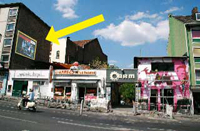
OPEN CALL
As part of the program of the festival "Bürgerstolz und Stadtfrieden" (Civil Pride and Urban Peace) we offer a billboard for screening video works from May 15 - September 24, 2007. Loyal_Rooftops_2007 shows video works, that point at social grievances and/or the struggle of independent culture/cultural institutions and therefore the festival "Bürgerstolz und Stadtfrieden" seems to be the right place at the right time to position themselves, short before those free spaces are closing.
The works will be shown without sound and as a loop, alternating daily. All participating artists will be present on our info media. We will be happy to give you a hand concerning accommodation. (more info here shortly; Galerie Loyal -Werner-Hilpertstr. 22 - 34117 Kassel)
Download Application Form.pdf. Send your DVD to: Martin Dege, Menzelstrasse 13, D - 34121 Kassel (dege (ät) uni-kassel.de).
Posted by jo at 04:19 PM | Comments (0)
Neural n. 27
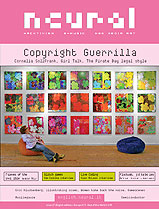
Celebrating 10 years
The new printed Neural issue in English is available. Neural.it celebrates 10 years of activity! Please check it and subscribe to RSS feeds, if you want :: 1 YEAR SUBSCRIPTION! 3 issues + EXCLUSIVE DVD BY GRENZE (Helsinki, 2006); Europe 24,90 Euro - World 38.97 U.S. Dollars :: BACK ISSUES:
Neural n. 27 contents: new.media.art . Cornelia Sollfrank (interview) . Arthur Kroker (interview) . news (Mire.project, Journal, Wordie, Email Clock Independent Robotic Community) . reviews (Book of Imaginary Media, In Human Format, City2City, Electronic Literature Collection 1, At the Edge of Art Words in Flux, GameScenes, Designing Interactions) . centerfold: 'netPong' by Oriol Ferrer Mesia.
e.music: . Girl Talk (interview) . Kim Cascone (interview) . Alex McLean, Live Coding (interview). news: (SoniColumn, Deep House for Symphonic Band and Choir, Ambient Addition, Breadboard Band, Forester) . reviews: (Vj, RT-32 Acoustic Space Lab, Synken, We Are All Drifting, 7ft_Konka, Women Take Back The Noise) . reviews cd: (Muslimgauze, @C, Funkstorung, Johan Johannsson, Kim Cascone, Nathan Davis, Mattin, Giuseppe Ielasi, Rosy Parlane, Strange Attractor vs Disinformation, Eric La Casa, Freiband, Flim, The Alps, Cagesan, Chris Watson & Bj Nilsen, Peter Rehberg, Marc Behrens and Paolo Raposo, Nick Didkovsky, Blotnik Brothers).
hacktivism: . Pirate Bay legal response style . Thieves of the Invisible . An Education and Labor Dispatch, by Trebor Scholz . news (PigeonBlog, Fake Progress Bar, View Finder Heatmap, Ad Generator, Logo.Hallucination) . reviews: ([the] xxxxx [reader], M.White - The Body and the Screen, H. Wagenbreth - Cry for Help, 36 scam Emails from Africa, F.Snelting+P.Westenberg - The Language of Sharing, T. Hansen - What Does Public Mean?)
Posted by jo at 03:58 PM | Comments (0)
Andy Gracie and others
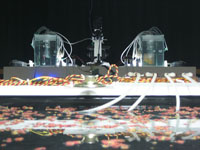
BIORAMA
DIGITAL UNIT RESEARCH presents BIORAMA @ MEDIA Centre Huddersfield :: July 13, 2007: A one-day event serving to contextualise, examine and expand upon the work and theory produced while Andy Gracie is Artist in Residence at the DRU. The research undertaken during the residency weaves together the microbiology of the Pennines around Marsden Moor, traditional and digital networking systems, perceptions of landscape and the history and possible future of interstellar communication.
Biorama Hike: _starting at 10 a.m. @ Marsden :: A 5 mile guided walking lecture and environmental study with Andy Gracie and Brandon Ballangee on Marsden Moor lasting around 3 hours. The walk will cover some of the physical territory featured in Andy's research, the talk will cover the parallel conceptual territories and simple scientific experiments will be carried out at various points on the way. Each participant will receive the Biorama Hiking kit with which to enhance their experience of the event. Particpants should book in advance as places are limited and should bring sturdy walking footwear and sun block.
Biorama Sessions: _starting at 3 p.m. @ Media Centre of Huddersfield :: The Biorama Sessions will introduce a number of artists whose work explores the natural environment, artificial landscapes and interactions with real or imagined lifeforms.
Participants: Agnes Meyer-Brandis, Andy Gracie, Brandon Ballengee, C-Lab, etoy, France Cadet, and London Fieldworks. Special guests in the evening.
Designed and presented by Monica Bello (CAPSULA) for the Digital Research Unit. Contact: monica[at]capsula.org.es.
Posted by jo at 03:46 PM | Comments (0)
Artists Space
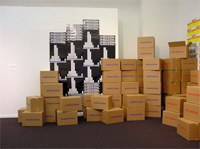
New Economy
Artists Space presents New Economy, curated by João Ribas :: June 15 – July 28, 2007 :: Opening Reception: June 15; 6:00-8:00 PM :: 38 Greene Street, 3rd Floor, New York, NY 10013 :: 212.226.3970 :: info[at]artistsspace.org
Chantal Akerman, Kader Attia, Ursula Biemann, Mike Bouchet, Heath Bunting, Los Carpinteros, Carolina Caycedo, Daniel Dewar & Grégory Gicquel, Harun Farocki, Eva and Franco Mattes a.k.a. 0100101110101101.ORG, Cildo Meireles, Henrik Plenge Jakobsen, Oliver Ressler, Joe Scanlan, Santiago Sierra, Rirkrit Tiravanija, Milica Tomic, and Donelle Woolford.
Special Film Screenings in conjunction with New Economy: Anthology Film Archives, 32 Second Avenue (at Second Street) :: June 19 and July 5; 7:30 pm - Chantal Akerman's FROM THE OTHER SIDE / DE L'AUTRE CÔTÉ; 2002, 99 minutes. In English and Spanish with English subtitles.
Posted by jo at 03:39 PM | Comments (0)
Netherlands Media Art Institute
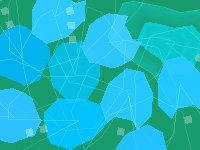
Pond
pond: Artists in Residence - Aymeric Mansoux and Marloes de Valk, Opening and presentation: June 15, 4:00 pm :: Exhibition from June 16 -July 14, 2007 :: Nederlands Instituut voor Mediakunst, Keizersgracht 264, 1016 EV
Amsterdam, Nederland :: Tel: 020 6237101 :: Email: info[at]montevideo.nl
Part of the 'Metabiosis' project, Marloes De Valk (NL) and Aymeric Mansoux (FR) investigate to what extent information can develop in a network of computers linked with each other and how it is possible for an audience to interact with it. The pond installation consists of three interconnected machines. Each machine runs a simple ecosystem model in which small strings of data are produced, processed and sent back and forth from computer to computer.
In reality the string contains a set of items that only make sense in the virtual machine / pond that interprets all this information. Because the model includes a two dimensional environment, visualized on screens, it is possible to follow the whole process as it is being computed on each machine. Even though the number crunching methods are abstract, with the aid of the visual output, one string of information can be tracked and referred to as a visible and animated 'creature'. When the machines are turned on, these 'creatures' remain in the computer memory and can jump to other computers/ecosystems.
They can reproduce (copy of information), evolve (update of information), and they can die (non recoverable loss of information). These self organized ecosystems produce patterns emerging from the initial rules set in the ecosystem model. At the same time, on a projection, the whole process and data exchange is visualised, bringing an even higher level metaphor and different point of view on how the information is flowing through the three machines.
It is possible for the audience to interact with each pond via a touchscreen, directly influencing and breaking the self organizing process. The input has immediate effect on the overall system and provides a way to bend or control the information flow.
pond is an experiment and a game for people who are curious about the possibilities of standalone processes, generative systems and artificial life.
During the residency, Mansoux and de Valk will investigate how the fragile transition regime between periodic and chaotic phases of a self organizing system can lead to complex behaviours with which an audience can interact with. The two visualisation models of the processed information raise the issue of the matryoshka effect through the relationship between interpretation and processed data.
Aymeric Mansoux is an artist and co-founder of GOTO10, an organization dedicated to create, produce, and support FLOSS+Art. He has taken part in many artistic experiments based on the internet and the emergence of networks, and considers any form of data to be a new clay that can be used to develop autonomous artistic processes. Currently part of the Digital Research Unit of the University of Huddersfield, his recent projects include the mysterious packets toolkit (with Tom Schouten and Marloes de Valk), the 0xA band (with Chun Lee), the digital artlife Metabiosis project (with Marloes de Valk), the pure:dyne GNU/Linux live distribution for media artists (with Chun Lee and Antonios Galanopoulos) and ongoing theoretical research into tools and digital autonomous processes. He is also part of the production and curatorial team of make art, an international FLOSS+Art festival in France.
Marloes de Valk is an audiovisual artist, part of digital art collective GOTO10. She was born in Holland, 1976, and is currently based in the UK. She studied Sound and Image at the Royal Conservatory in the Hague, specializing in abstract compositional computer games, HCI and crashing computers. Her work consists of audiovisual performances and installations, investigating machine theater and narratives of digital processes. She is part of the packets project, developing and documenting new tools for artistic creation, and is currently collaborating with French artist Aymeric Mansoux on Metabiosis, a project investigating the ups and downs of data packets living in a world of connected ecosystems. Marloes is part of the Digital Research Unit at the University of Huddersfield.
Posted by jo at 10:55 AM | Comments (0)
WGBH Lab

Open Call and Filmmakers-in-Residence Programs
WGBH Lab's Open Call seeks big ideas for small screens, including cell phones, PDAs, and television broadcast. Selected applicants receive funding to complete their short films, input during the production process from professional media makers, and a place to showcase their work.
This year, the Lab invites filmmakers and other aspiring media makers to submit proposals for 3-minute videos expressing reflections on and/or responses to war. Possible entries might include a grandfather’s story from World War II, thoughts on the current war in Iraq, or other contemplations on how war impacts society. Finished work may be presented via broadcast and broadband in conjunction with Ken Burns’ PBS documentary miniseries The War, airing in September 2007.
The deadline for entries is June 21, 2007. Later this year, P.O.V. will curate a Lab Open Call to develop original short content. P.O.V.’s editorial team will work closely with WGBH Lab and filmmakers to create rich content that can be distributed on multiple platforms during P.O.V.’s 2008 season.
Filmmakers-in-Residence: WGBH invites filmmakers and innovators from related industries to work on their independently funded projects during a nine-month residency at WGBH. Selected participants will receive a stipend, working space, administrative support, editing equipment, editorial guidance, and access to WGBH staff to advance their projects.
The deadline for the next round of filmmakers-in-residence applications is August 4, 2007.
P.O.V. will host a visit of Filmmakers-in-Residence at their New York offices. Workshops on a variety of topics will be conducted on areas such as: communications, production, community engagement and interactive strategies. These sessions will be individually tailored to the needs and goals of each filmmaker.
Sandbox: The WGBH Lab Sandbox is an open content initiative that allows users gain access to use rights-cleared, WGBH-owned content to use for their own (non-commercial) purposes. The public is invited, but not required, to share the results of their work by posting a link to the site. Users can post comments on each other’s work. The WGBH Lab Sandbox will relaunch in July with a new and expanded collection of content.
WGBH Boston is America’s preeminent public broadcaster, producing such celebrated national PBS series as Masterpiece Theatre, Antiques Roadshow, Frontline, Nova, Arthur and more than a dozen other award-winning primetime, lifestyle and children’s series. Boston’s last remaining independent TV station, WGBH’s local TV productions (among them, Greater Boston, Basic Black and La Plaza), focus on the region’s diverse community, while WGBH 89.7 FM is Boston’s NPR Arts & Culture station, offering a rich menu of classical, jazz, blues, news programming and more. WGBH is the leading producer of online content for pbs.org—one of the most-visited dot-org sites on the Internet—a major producer for public radio and a pioneer in developing educational multimedia and new technologies that make media accessible for people with disabilities. For its efforts, WGBH has been recognized with hundreds of honors, including Oscars, Emmys, Peabodys and duPont-Columbia Journalism Awards.
Produced by American Documentary, Inc. and celebrating its 20th season on PBS in 2007, the award-winning P.O.V. series is the longest-running showcase on television to feature the work of America's best contemporary-issue independent filmmakers. Airing Tuesdays at 10 p.m., June through September, with primetime specials during the year, P.O.V. has brought more than 250 award-winning documentaries to millions nationwide, and now has a Webby Award-winning online series, P.O.V.'s Borders. Since 1988, P.O.V. has pioneered the art of presentation and outreach using independent nonfiction media to build new communities in conversation about today's most pressing social issues.
Posted by jo at 10:45 AM | Comments (0)
iCommons Summit 2007
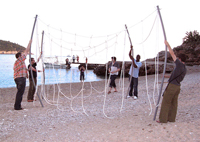
The Art Happens Here
[Image: Nathaniel Stern's Sentimental Construction #1, part of The Wireframe Series site-specific, publicly performed “spaces,” made of rope (2007). Performers / documentarians / collaborators: JC Bukenya, Tomislav Domis, Joy Garnett, Ana Husman, Kathryn Smith, Tim Whidden (MTAA) and Jaka Zeleznikar.] The Art Happens Here :: Opens 15 June @ 21h30, Croatian time :: iCommons Summit 2007, Lazareti Art Workshop, Dubrovnik Croatia :: Simulcast to Annenberg Island in SL, 12h30 PDT, Second Life.
The Art Happens Here is a contemporary art exhibition and presentation at the iCommons Summit 2007, resulting from an ongoing artist in residence programme. Six international artists and a critic were invited to produce physical and virtual work that engages with fair use, copyright, re-mixing, piracy and/or collaboration on some level - whether directly or indirectly.
Works on show will include, but not be limited to, art books, murals, net.art, sculpture, public performance, video and installation -- all conceptually linked by their engagement with the Commons, by the artists' time spent in Dubrovnik. Participants include: Joy Garnett (USA), Ana Husman (Croatia), Kathryn Smith (South Africa), Nathaniel Stern (USA / South Africa), MTAA (Mike Sarff & Tim Whidden, USA), Jaka Zeleznikar (Slovenia) and blog-critic Paddy Johnson (of artfagcity, USA). There will also be a special appearance in the SL exhibition by Patrick Lichty, aka Man Michinaga (USA).
Artist Discussion Panel on Creative Commons and its potential uses and effects in professional arts practice will be a part of the iCommons main programme in Dubrovnik, 15h00 Croatian time.
Posted by jo at 10:35 AM | Comments (0)
June 13, 2007
Rosemarie Fiore
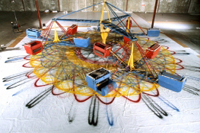
Scrambler & Firework Drawings
Rosemarie Fiore utilises common appliances and machinery, including amusement part rides, to facilitate her mark making explorations. The Good-Time Mix Machine: Scrambler Drawings appear as gigantic mandalic spirograph patterns (technically Hypocycloids), incredibly up to 60×60ft in size!
‘I connected a gas generator and air compressor to buckets of paint and secured them into the seats of a Scrambler amusement park ride. Once the ride was in motion, paint sprayed out of the benches onto vinyl tarps placed underneath. The result is a series of enormous hypocycloid designs which recorded the hidden patterns created by the ride as it turned’
Continuing a process based path her firework drawings appear as Rayogrammic chromatography experiments with subtle overlapping colour arrangements. This time she uses the after burn of live fireworks’ exploding to create saturated abstract compositions! Who could resist ‘lit fireworks on paper, collage’ as a media description?
More on the Hypocycloids & other Spirographic drawing machines
More Drawings of Harmonic Motion [blogged on dataisnature]
Posted by jo at 07:29 PM | Comments (0)
Canadian Journal of Communication
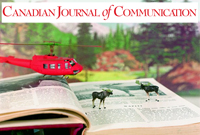
Call for Papers
Special Issue on Wireless Technologies, Mobile Practices :: Mobile wireless devices such as handheld pdas, cellular telephones, and portable computers are part of a changing landscape of communications and culture. In the last decade alone, for instance, the use of cell phones has increased fourfold in Canada signaling a remarkable shift in the telecommunications industry, the convergence of a number of technologies onto a single platform, and new ways of conducting person-to-person communication and creating community. In addition to these devices, Wi-Fi networks, Bluetooth, WANS, and GPS comprise integrated segments of the new infrastructure of the so-called wireless world as well as an emergent vocabulary for citizens and consumers.
The Canadian Journal of Communication invites submissions, in English or in French, for a forthcoming special issue on mobile communications and wireless technologies. We are interested in innovative, critical approaches that decipher a range of mobile technologies and practices in wireless contexts. Possible themes include:
:: Everyday uses: sharing our lives via the mobile (text, voice, video)
:: Civic engagement, activism and mobile technologies
:: Wireless services and emergency communication
:: Privacy, surveillance and mobile phones
:: Community Wireless Networks
:: Policy: CRTC regulations and spectrum policy
:: Mobility, Labour: new conditions of work
:: Shifting notions of space, place and time in a mobile world
:: Rhetoric and discourses on mobility and wireless worlds
:: Art, design and mobile technologies
:: Mobile genres and cellular convergence
:: Global and international perspectives on mobile technologies
Full-length papers (@ 7000-9000 words) should be submitted electronically following the guidelines laid out on the CJC submissions website. Make sure to write in all caps "MOBILE" in the Comments to the Editor field, and to include it on the cover page of your article as well. Do not include your name on the cover page.
Deadline for papers is Sept. 1, 2007. Papers selected by the editors will then be sent for peer review for final decision.
Comments and queries can be sent to one of the special issue editors:
Dr. Barbara Crow, York University, bacrow[at]sympatico.ca
Dr. Kim Sawchuk, Concordia University, kim.sawchuk[at]sympatico.ca
Dr. Richard Smith, Simon Fraser University, smith[at]sfu.ca
Posted by jo at 06:55 PM | Comments (0)
Lynette Wallworth
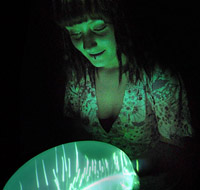
Hold: Vessel 2, 2007
Lynette Wallworth: Hold: Vessel 2, 2007 :: BFI Southbank, London SE1 :: 23 June - 2 September :: Artist's talk: Lynette Wallworth in Conversation with renowned scientist, writer and presenter Mark Lythgoe - July 3, 18:20 NFT2 :: FREE :: 020 7928 3232
Lynette Wallworth's London debut sees the BFI commissioning Hold: Vessel 2, 2007, enabling the artist to further develop her critically acclaimed piece Hold: Vessel 1, 2001. An interactive, large-scale installation that explores the intimacy and immensity of the natural world and our relationship to it, this work uses moving image and technology to reveal the hidden intricacies of human immersion in the wide, complex world.
The piece is activated by the viewer, the interaction being a metaphor for our connectedness within biological, social and ecological systems. Upon entering the exhibition space, the visitor is encouraged to 'catch' falling projected images of astronomical and underwater life in lens-shaped glass bowls. With intimate moments of synchronised light and sound, the installation celebrates minutiae - microscopic views of marine life forms and photographic imagery of deep space - leaving the visitor with a sense of communal participation within a complex system of which we are a part.
The images in Hold: Vessel 2 come from current visioning technologies such as X-ray Microtomography and remotely operated light sensitive cameras allowing us to see intricate detail inaccessible to the human eye. A reflection upon our own place in a complex and starkly beautiful world, the work helps us explore the complex interconnectivity between things that we do not always see or know.
Lynette Wallworth is the second of an ongoing series of art exhibitions at BFI Southbank exploring contemporary artists' use of the moving image.
Lynette Wallworth - Hold: Vessel 1, 2001
Courtesy of and commissioned by the Australian Centre for the Moving Image, Melbourne, Australia http://www.acmi.net.au
Lynette Wallworth - Hold: Vessel 2, 2007
Commissioned by the BFI, London, Produced by Forma Touring and Supported by Arts Council England
Posted by jo at 06:40 PM | Comments (0)
N3krozoft Ltd
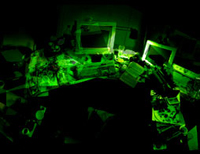
The REMOTE FAIRYTALES
REMOTE FAIRYTALES - CONTES LOINTAINS - FABEL OP AFSTAND - N3krozoft Ltd exhibit + live internet performance :: Performance: June 14, 2007, 7pm :: Exhibition: June 14-September 12, 2007 :: Location: MAAC Gallery, 26 rue des Chartreux, 1000 Brussels, Belgium.
LIVE INTERNET PERFORMANCE: feat. the girl without hands, a lecture & the Aether collective. The opening performance can be followed ONLINE :: June 14, 7 pm CET (central european time) - 10am in California - noon in Colombia - 9pm in Moscow - midnight in Bangkok - 2am in Tokyo. Get your local performance time here.
INCLUDING: 3 fully functional ZOETROPES, graphical prints, a rare exhaustive screening of the classic videoperformance LOL (laughing out loud) & other artifacts. Additionally, n3krozoft ltd will release an EXCLUSIVE edition of its complete videographic works (1904-2007).
In addition to being the world leader in Biometrics-Based Information Exchange (BBIX), N3KROZOFT has strong market positions in non-euclidean translation systems and on-the-fly data processing and visualisation. The Strategic Imagery Group is currently testing and integrating a fully functional real-time media architecture that will be reliable, unexpensive, and packaged with documentation and source code (though not necessarily complete in terms of desired features).
Aether collective: Initiated in May 2007 during a workshop at the Mapping Festival in Geneva, Switzerland, Æther9 is a collaborative art project exploring the field of realtime video transmission. Developed by an international group of visual artists and collectives working in different locations spread around the globe and communicating solely through the Internet, Æther9 intends to become a functional framework for collaborative video performance.
Zoetrope: The zoetrope was invented in 1834 by William Horner. It was based on Joseph Plateau's phenakistoscope, but was more convenient since it did not require a viewing mirror and allowed more than one person to use it at the same time. Original zoetrope by William George Horner, 1834. Exhibit of Optical Toys.
LOL (laughing out loud): Media performance created by N3krozoft Ltd Media Group (2003-2005).
Beklemmende Online-Tragödie – review by Raffael Dörig for Regioartline (in german)
in(security) by Ryan Holsopple for ITP 2006 Thesis Week.
Posted by jo at 10:38 AM | Comments (0)
[-CC-] "curating media/net/art

Call for Papers
Call for [-CC-] "curating media/net/art--papers" :: Abstracts deadline: June 30, 2007 :: Notification of acceptance: July 7, 2007 :: Deadline for finalized papers: August 31, 2007.
For the project [-CC-] "circualting contexts--curating media/net/art" from June 1st - October 31st, 2007 which takes place in Vienna and in the online medium, the public is invited to enter papers concerned with contemporary curatorial practices in- and outside the virtual space. The papers should be limited to max. 15.000 characters and must be licencened under the Creative Commons Attribution 3.0 Unported License. [-CC-] "curating media/net/art--papers" is open to all thematic fields but may be related to the topics below too. Selected papers will be printed in the forthcoming catalogue.
1 visualizing work.flows and (filtering-) processes
2 virtual/real representations in real/virtual spaces
3 facing participation / the lack of collaboration
4 web 2.0--curatorial facilities or technical barriers
5 involvement of (art-)institutions / rise of significance
Please send your submissions or questions to: curating(at)cont3xt.net
The curating of Internet-based art on the Internet is a multifaceted communication-process between Internet-users with all kinds of different backgrounds regarding the content. Along with the changing conditions of production and reception of art on the Internet came new possibilities of curation which deserve study. [-CC-] "circualting contexts--curating media/net/art" is a series of experimental long-term research projects hosted by the Vienna-based organisation CONT3XT.NET, investigating current tendencies in the curation of (New) Media and Internet Art.
Posted by jo at 08:53 AM | Comments (0)
June 12, 2007
Torrent Raiders
Aaron Meyers put together a short promo music video-ish thing for Torrent Raiders! Music by Cursor Miner.
Torrent Raiders is a dynamic network visualization realized through the idioms and aesthetics of arcade-style video games. Driven in real-time by the activity of bit torrent swarms, Torrent Raiders takes place on the ad-hoc networks created by bit torrent users. Torrent Raiders playfully addresses issues of domestic surveillance and intellectual property by putting players in the role of a mercenary copyright enforcer, encouraging them to capture evidence against peers on torrents in order to collect bounties. Players assist in the distributed surveillance of these torrent swarms, sending information to a central server where it will be used to drive further visualizations of this information. As a dynamic visualization exploring privacy, piracy and surveillance, Torrent Raiders challenges Internet users, content pirates and government spooks to examine their allegiances and mistrust their computer connections.
Posted by jo at 06:59 PM | Comments (0)
INFOWARROOM
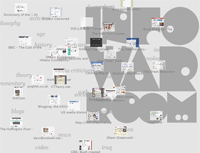
The Society of the Unspectacular
It is time to leave the theories of Debord about the Society of the Spectacle behind us. If today we witness the hyper-spectacular in the mass-media, this should not fool us. It is not the apotheosis of the spectacle, but much rather the eclipse of the spectacle - the final moment of tragic sublimity, of hyper-violence, before it fades out....
In many ways the fate of the spectacle society mirrors (and is mirrored in) the culture of the spectacle par excellence, that of the mass-mediated United States of America. If today the USA projects its power as super-state throughout the world with an unprecedented hyper-violence, then this tragic spectacle should not fool us. The USA has long shed it status as the sole superpower in the world. Silently financed by China, economically eclipsed by the EU, again China, and soon even India, unable to procure for its own wasteful energy needs (hence its dependence on countries like Russia, Venezuela, Saudi Arabia), culturally and intellectually unsettled - it has become a crash waiting to happen...
The mass-media are about to dissolve into a sea of hypermedial fragments, transforming into a multitude of hybrids and singularities (does anybody still know what television actually is these days?). This inevitably invites a radical fragmentation of 'the public'. This is a process that has at long taken hold of the informational societies. The current explosion of self-publication in countless weblogs, on community websites, self-video portals, in on-line diaries, web fora and a plethora of individual websites is only the visible sign of an undercurrent that was already for many years transforming 'the public' into an amalgamation of increasingly unrelated subjectivities and singular interest groups.
What can be witnessed today is the rise of swarm publics - highly unstable constellations of temporary alliance, creating a public sphere in constant flux - globally mediated flash mobs that never meet- fuelled by sentiment and affect - escaping fixed capture.
The face of "radical mediocrity"
Rather than tending towards the expression of hyper-individuality, these swarm publics, by lack of common frame of reference, tend towards the lowest common denominator; the absolutely unparticular - mediated in excess to find confirmation of its own averageness. This is what we could perhaps call the face of "radical mediocrity" (as philosopher Henk Oosterling would probably call it, though I'm not sure he understands the same thing with this as what I'm getting at here).
Mass Media then become Generic Media: What we can see on YouTube is first and foremost the eternal return of the same, the absolutely average, the radically unparticular, the excessive practice of everyday life.
The media space of Generic Media is a quotidian space: It is the space of the everyday. It is inherently unspectacular. Generic Media is never in any sense an anti-spectacle, it is simply the denial of spectacle altogether.
What can be witnessed in the universe of self-media is the nominalisation of the mediated image - and what is so striking about it is that the image (on average) is so exceedingly boring. It is the grand testimony to the human spirit's inability to move beyond itself. We can witness it day in and day out trapped in its own circularity. The media image in the universe of self-publication tends towards that negative horizon where it looses all its articulation and becomes 'vernacular', something that is impossible to capture.
The current excess of self-mediation was already prefigured in the early experimental internet cultures of the 1990s. When I was asked to reflect on the Liverpool variation of the Superchannel project, a do-it-yourself web-tv platform facilitated by the Superflex collective from Copenhagen, called Tenant Spin. I couldn't help but noticing while going through the archive of this web-tv project in the UK's oldest tower-block during reconstruction how incredibly boring and unspecific, 'normal' these webcasts were. In no way did they reflect the spectacles of mass media. I called it "Aesthetics of the Unspectacular", and of course these were media without an audience par excellence!
The dark face of "YOU"
The productive moment of self-media is quite evidently its escape of authoritarian indoctrination. However, this certainly does not mean that it constitutes a space without conflict. Much rather conflict flourishes in the space of generic media. In a sense the system of self-mediation is the ultimate expression of Chantal Mouffe's idea of antagonistic pluralism. The space in fact has a double face, at the same time the face of radical mediocrity and a much more darker face:
The dark-face of "YOU" - is constituted by the exponential proliferation of do-it-yourself xenophobia, racism, hatred and paranoia ("don't trust anyone - not even yourself!"). No theory to account for social reality can be trusted anymore. Every argument is immediately overturned, reversed, subverted, distrusted. Discourse is tribalised, fragmented and ultimately atomised. The unceasing on-line debate about the conspiracy theories of 9/11 are the clearest case in point - the excess of do-it-yourself paranoia has resulted in a space of complete disinformation, in which all public discourse breakdown (and decision making removes itself entirely from the public sphere).
The state apparatus - no longer assured of mediated mass-mind-control has to respond to the radical fragmentation of its publics with new systems of control, and adopts the swarm-model of radically distributed surveillance (rfid, smart dust, etc.) and the integration of the biological body of its underlings in a technologically induced system of control (biometrics). If Joseph Goebbles still believed that the true base of political power was "to capture the heart of a people and keep it", today the complete visibility of hyper-surveillance strives for the complete traceability and scrutiny of all people.
Power today is vested not in the ability to connect and become visible, but much rather in the ability to disconnect, to become invisible and thus untraceable, at will. This is the paradox: under conditions of complete media transparency, decision making retreats from the public sphere altogether. Agency today is located outside the domain of visibility.
Eric Kluitenberg,
Amsterdam June 2007.
The short text ... was given as a fast talk in the closing program of the INFOWARROOM series on media criticism and visual cultures at De Balie Centre for Culture and Politics in Amsterdam, June 8 & 9 2007. After three seasons the INFOWARROOM series came to a close this weekend with an extensive two-day lecture program devoted to the theme "At the end of the era of mass media", including presentations by Arthur Kroker (Ctheory.net), David Garcia, Richard Wright (Mediashed.org / Mongrel), Patricia Pisters and many others. The recordings of the live streams will soon be placed on-line.
The archive of the INFOWARROOM series can be found here: http://www.infowarroom.org and at the Balie website: http://www.debalie.nl/dossierpagina.jsp?dossierid=45611 [posted on nettime]
Posted by jo at 06:25 PM | Comments (0)
Erkki Huhtamo:
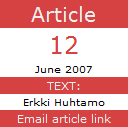
On Art, Interactivity and Tactility
"I have secretly caressed paintings in museums, shaken hands with statues..." This line from asong called "The Tourist" recently caught my attention. Is this an expression of projected affection? The confession of a madman? An account of innocent touristic pranks familiar fromtravel snapshots? Or is it a deliberate subversion of received codes of behavior with - perhaps - ideological implications? As it turns out, the protagonist of "The Tourist" is a loner, "a man lost inhis hometown." Touching paintings and sculptures is a compensation for the lack of a human touch that he has been searching for "in wrong places." Touching the untouchable, crossing theline, avoiding the public eye. Our experiences in public spaces often include the temptation to 'exceed the limits,' at least for a passing moment. Such actions often involve the hand. I have met'normal' people - including artists - who occasionally practice shoplifting. Not for profit or the need for anything - the stolen object is something insignificant, like a piece of gum. For suchpeople the act of shoplifting is more like a sleight-of-hand that challenges the limits of the permissible. It is also a test of one's agility and "guts," bringing to mind the lonely endeavors ofRobert Bresson's Pickpocket (1959). More determined challenges are the "para-legal" arts of street graphics and graffiti that often spring from alienation. They represent the need to "makeone's mark" and to assert one's presence while remaining anonymous, a shadow figure. Posting notes or spraying tags is linked with tearing down, covering, replacing. These acts are part of anunfinished/able urban semioclasm, a palimpsest taking place anywhere where bills are posted and bare walls - potential surfaces to be filled - are available." From On Art, Interactivity and Tactility by Erkki Huhtamo, NeMe.
Posted by jo at 05:53 PM | Comments (0)
Upgrade! Paris

chdh
Upgrade! Paris: Cyrille Henri and Nicolas Montgermont present chdh :: Date: June 15, 2007 at 7:00 PM :: Place: Point Ephimhre, 200 quai de Valmy 75010 Paris, M0 Stalingrad :: Mediator : Dominique Moulon.
chdh is a live hybrid performance, offering a symbiosis between the sound and the image. Between minimalism and industrial, chdh creates a single, cold but organic universe. Thanks to the use of mathematical algorithms and physical models, chdh brings a new vision of the use of data-processing tools in musical creation. The use of audio-visual objects, having a sound component and a video component controlled by the same parameters allow an effective management of the relations between the two medias.
This project evokes a virtual world, made up with more or less autonomous abstract creatures. The aesthetics of the video and the sound is minimalist: sines, diracs and noises interact with cubes, spheres and other primitive in 3D on a black and white visual environment.
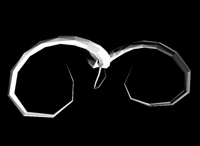
The role of chdh during live performances is to play with the movement of these objects, in order to make them live and react. Two musicians handle the instruments by using an abstracted layer, software representation of the audio-visual object. Each algorithm then creates data used for the video synthesis and for the sound synthesis, creating a strong cohesion during the performance.
Cyrille Henry, artist and multi-field developer, he is interested in interactions between human gesture and data processing for artistic exploration. His work was directed in turn towards the sensors or physical modelling for gestur analysis, human interface devices, as well as the sound and visual synthesis in real time. He worked 4 years in La kitchen in Paris (in charge of the hardware department) for the development of sensors interfaces and their uses in an artistic context (live spectacle, dance, interactive installation, music). He is one of the founder members of the chdh project. Since 2005, he works as a free-lance developer/engineer around pure-data/Gem and sensors.
Nicolas Montgermont, researcher and artist, studies the relations between art and sciences using the computer as a workshop. After a formation in signal processing, he studies sciences applied to music at the IRCAM center, being specially focused on real time control of synthesis. Currently, he carries out a PhD thesis on the analysis of the flutist playing at the Laboratory of Musical Acoustics (LAM) in Paris. His creating work is the search of a numerical aesthetics, using and developing personal tools to explore the specific possibilities of a computer. Founder of Basses Lumihres, an association working on the fusion of the relationship between various mediums of the contemporary art, he works mainly in the musical field, through three projects : chdh ; ABM, a break/noise laptop duo and Ngio, a minimalist and numerical sound.
Info and archives on: http://incident.net/theupgrade. The Upgrade! Paris sessions are organized by Incident.net. They are public and monthly. Artists, researchers, architects, theorists present during one hour their recent work. Partners: CITU, Ars Longa, RYbN, The Upgrade! International.
Posted by jo at 02:41 PM | Comments (0)
Sonar 2007
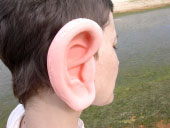
Spam, the Economy of Desire
SPAM as an art form: As in previous years, one of Sonar's exhibition areas is once again set aside exclusively for displaying the latest developments in digital art. Located on the 1st floor of the Centre de Cultura Contemporànea, this year's exhibition focuses on SPAM, one of the most common and undesirable elements on the net. In this selection of works curated by Alessandro Ludovico, the unwanted information that we delete every morning without a second thought becomes an artistic device used by artists to explore different mechanisms for communication – and intrusion - in the technological age.
Sonar also gives a place to the latest new media art from Barcelona through Digital Art on Demand, organised in collaboration with the gallery Niu, one of the city's main new media cultural centres. Local artists and foreign Barcelona-based artists participate in this showcase called Viviendo@bcn. Mediateletipos.net (a satellite project of the important Galician portal artesonoro.org) will also be a guest at this year's Sonar, with eight interesting projects that explore the same general area: the revolution that the widespread use of web 2.0 will imply in relation to the music scene.
Spam, the Economy of Desire :: Alessandro Ludovico (IT) - As one of the inescapable communication phenomena of our times, junk e-mail is a substantial part of our infoscape. "Spam" is an exhibition of works curated by Alessandro Ludovico that explores how digital artists have proven themselves smarter than spammers. Taking Spam beyond the computer screen or responding to it through aesthetic strategies of all kinds, these artists could be considered to be the bravest, definitive email heroes.
Jonathan Land, "The Spam Letters"
http://thespamletters.com
Richard Airlie, Ian Morrison, "Spamradio"
http://thespamletters.com
Alex Dragulescu, "Spam Architecture"
http://www.sq.ro/spamarchitecture.php
Bill Shackelford, "Spamtrap"
http://billshackelford.com/home/portfolio_spamtra_826
Markus Boeniger, "Spam Shirt"
www.spamshirt.com
Luca Bertini, "800-178968, a Toll Free Number"
http://ilnumeroverde.net/about/cornice3_eng.html
Dean Cameron, Victor Isaac, "Urgent & Confidential"
www.spamscamscam.com
Nick Philip, "Nowhere.com"
http://nphilip.best.vwh.net/instal.htm
"Today's Spam"
http://spamtoday.blogspot.com/
Viviendo@bcn :: Niu (ES) - Barcelona, a Mediterranean and usually sunny city, is one of Europe's most active and innovative hubs for audiovisual and multimedia arts. Much of this innovation and richness comes from artists born outside of Barcelona, people from a thousand and one different cities who decide to stop here for a time. Many of these artists explore audiovisual language as a form of artistic expression. This small selection shows the creative scope of eight collectives led by artists who have made Barcelona their home over the last few years. Recent arrivals from Sevilla, Bogota or Berlin who are making Barcelona a stop on their professional path and contributing a cultural richness that may be hard to quantify, but is undoubtedly positive. Niu is a cultural space located in Barcelona's Poblenou area that produces, exhibits and publicises contemporary audiovisual arts, multimedia design, digital art and independent electronic music. The subject of study, production and exhibition is the "audio and visual" culture that emerges with the inrush of digital technology into the world of art, design and communication.
Alberto Tognazzi, "Intimidades"
www.intimidades.es
Dslnc Studio (con música de Pablo Maffi), "Electrospoken World Video
Collage Generator"
www.desilence.net
Matekemata, "Airport"
www.matekemata.com
Sebastián Seifert & Miguel Marín, "Catangos Remixed"
www.niubcn.com/catangos
AC 3monitor, "28 Dead...Hundred Injured"
www.myspace.com/ac3monitor
Háztelo, "El Cruce"
www.haztelo.com
Institut Fatima, "Wireless Artist for Everyone!"
www.myspace.com/institutfatima
Equipo & Txalo Toloza-Fernández, "Usted No Está Aquí"
www.miprimerdrop.com
www.equipoweb.de
Redes Aurales :: Mediateletipos.net (ES) - We find ourselves facing the need to construct a new theory of knowledge that will allow us to study societies through their sound imaginaries. In this supposed new stage, the semantic web plays an essential and major role, a place for construction rather representation: from the figurative plane to pattern, from perspective to immersion, from object to process, from content to context, from reception to negotiation, from observation to action and from brain automatism to the distributing mind. Here in this new context is where we may find the keys to help us resolve the problem. Mediateletipos.net (a satellite project of the portal artesonoro.org), has selected eight projects that use social consensus as a means of working towards constructing that longed for means to knowledge through "aurality".
"Ccmixter"
http://ccmixter.org
"Earlabs"
http://earlabs.org
"Escoitar"
www.escoitar.org
"The Freesound Project"
http://freesound.iua.upf.edu
"Jamendo"
www.jamendo.com
"Pandora"
www.pandora.com
"Ruccas"
http://ruccas.org
"Soundtransit"
http://soundtransit.nl
Posted by jo at 02:12 PM | Comments (0)
CHArt 2007

FINAL CALL FOR PAPERS
CHArt (COMPUTERS AND THE HISTORY OF ART) TWENTY-THIRD ANNUAL CONFERENCE: DIGITAL ARCHIVE FEVER :: CALL FOR PAPERS :: November 8 - 9, 2007 :: London Venue to be confirmed :: Deadline: June 30.
Museums, galleries, archives, libraries and media organisations such as publishers and film and broadcast companies, have traditionally mediated and controlled access to cultural resources and knowledge. What is the future of such ‘top-down’ institutions in the age of ‘bottom-up’ access to knowledge and cultural artifacts through what is generally known as Web 2:0 - encompassing YouTube, Bittorrent, Napster, Wikipedia, Google, MySpace and more. Will such institutions respond to this threat to their cultural hegemony by resistance or adaptation? How can a museum or a gallery or, for that matter, a broadcasting company, appeal to an audience which has unprecedented access to cultural resources? How can institutions predicated on a cultural economy of scarcity compete in an emerging state of cultural abundance?
For the twenty-second CHArt conference we are looking for papers that reflect upon these issues, particularly in relation to visual culture. We particularly welcome contributions from those working in either ‘traditional’ cultural organisations or those involved in new forms of cultural access and distribution.
Please email submissions (a three hundred word synopsis of the proposed paper with CV of presenter/s and other key figures) by 31 May 2007 to Hazel Gardiner (hazel.gardiner[at]kcl.ac.uk).
Dr Charlie Gere, Chair, CHArt
CHArt
c/o Centre for Computing in the Humanities
Kings College, University of London
Kay House
7 Arundel Street
WC2R 3DX
Posted by jo at 10:28 AM | Comments (0)
June 11, 2007
Vehicular Ad-hoc Networks (VANET)
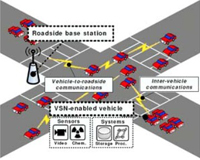
Turning cars into wireless network nodes
You can see above how vehicular sensor networks (VSNs) can be built on top of Vehicular Ad-hoc Networks (VANET) by equipping vehicles with onboard sensing devices. (Credit: Network Research Lab at UCLA) You'll find more details by looking at the MobEyes research project home page. This is one of the projects handled by the Network Research Lab at UCLA Computer Science Department, where computer science professor Mario Gerla and researcher Giovanni Pau are trying to turn your cars into wireless networking nodes.
As Gerla said, "We have all of these computer devices as integrated systems inside our cars. It's time to extend that concept. Computers are already being installed in many vehicles, and wireless capability will soon follow, so a mobile network deployment would only require the relatively low-cost addition of sensors to the vehicle's roof and bumpers and configuring the computer with new 'mobile' applications."
Pau added that the UCLA's team was using existing technologies. "We use standard radio protocols such as Digital Short Range Communication, or DSRC, combined with wireless LAN technology to create networks between vehicles equipped with onboard sensing devices. These devices can gather safety-related information, as well as other complex multimedia data, such as video. The most essential aspect of this network is that it is not subject to memory, processing, storage and energy limitations like traditional sensor networks. It relies on the resources of the vehicle itself, along with those vehicles around it."
Turning a car into a wireless network node might be easy to do, but what would be the benefits? According to the researchers, they are broad. Here are some of them. Day-to-day driving could be safer and more convenient; Drivers would have access to information about dangers within or near their mobile network, such as the presence of smoke from a forest fire; More importantly, the technology could also provide life-saving communications between emergency personnel.
The team has already built "a vehicular testbed to explore these issues and to study car-to-car networking experiments under various traffic conditions and mobility situations. With a successful field test already completed, Gerla's team has further plans to develop a UCLA Campus Vehicle Testbed, or C-VeT, through a wireless testbed environment called WHYNET."
For more information, you can read a technical paper published by IEEE Wireless Communications, "MobEyes: Smart Mobs for Urban Monitoring with a Vehicular Sensor Network" (Vol. 13, No. 5, Pages 52-57, October 2006). Here are two links to the abstract and to the full text of this paper (PDF format, 6 pages, 187 KB).
So when will see these network on wheels? According to Gerla, it could take five years because of two main reasons. First, car makers would need to add another piece of technology in the vehicles they build. And second, some of us might not like the idea of our cars transmitting information about where we are in real time. [source]
Posted by jo at 06:45 PM | Comments (0)
Telematic Dress
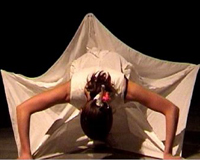
Distributed Proprioception
Abstract: Centered around several short films from streaming performances created in 2005, this paper explores new ideas for movement technologies and garment design in an arts and digital research context. The "telematic dress" project, developed at the DAP Lab in Nottingham, involves transdisciplinary intersections between fashion and live performance, interactive system architecture, electronic textiles, wearable technologies, choreography, and anthropology.
The concept on an evolving garment design that is materialized (moved) in live performance originates from DAP Lab's experimentation with telematics and distributed media addressing "connective tissues" through a study of perception/proprioception in the wearer (tactile sensory processing) and the dancer / designer / viewer relationship. This study is conducted as cross-cultural communication with online performance partners in Europe, the US, Brazil and Japan. The inter-active space is predicated on transcultural questions: how does the movement with an evolving design and wearable interactive sensors travel, how does movement - and capturing of movement - allow the design to emerge toward a garment statement, and how are bodies-in-relation-to sensory fabrics affected by the multidimensional kinesthetics of a media-rich, responsive environment." From The Telematic Dress: Evolving garments and distributed proprioception in streaming media and fashion performance by Johannes Birringer and Michèle Danjoux. [via]
Posted by jo at 05:32 PM | Comments (0)
Come Out & Play Festival
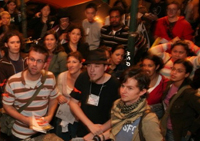
CALL FOR PROPOSALS
TURN AMSTERDAM INTO A PLAYGROUND IN THE SECOND ANNUAL COME OUT & PLAY FESTIVAL, SEPTEMBER 22-23 :: SUBMISSION DEADLINE :: July 15, 2007 :: The Come Out & Play Festival seeks to provide a forum for new types of public games and play. We want to bring together a public eager to rediscover the world around them through play with designers interested in producing innovative new games and experiences. Oh yeah, and we want to have city-size fun.
The festival offers a chance to explore new styles of games and play. Last year the festival featured games from the creators of I Love Bees, PacManhattan, The Go Game, Conqwest, Big Urban Game and more. From massive multi-player scavenger hunts to public play performances, the festival gives players and the public the chance to take part in a variety of different games. We are extremely excited to announce that Come Out & Play will be landing in Amsterdam, Netherlands this September for a two day festival. In collaboration with the PICNIC'07 cross media week, Come Out & Play will be running a two-day mini-festival in Amsterdam this September.
SUBMIT TO THE FESTIVAL
Have you got a game? We want to include as many different types of games as possible in the festival schedule. We are looking specifically for games with defined goals and interesting, meaningful choices for the players. These games should be interactive and directly engage the participants. Your game can have a technology component or it can be old school with absolutely no tech; to us, it's much more important that the game produce an interesting experience for the players. We will be reviewing submissions focusing on these criteria when we select games for the schedule:
Most importantly, your game must be playable in Amsterdam during the festival.
Your submission will be reviewed by a panel of street game "experts" brought together to assemble the lineup for this most sacred event. Okay, we are actually a bunch of yahoos. But we have run a few games and we really like playing in fun ones. So make sure your game sounds fun and interesting. We like innovative use of public space. We like games which make people interact in new ways. We like games that alter your perception of your surroundings. But most importantly, we just want the players to have fun.
APPLICATION :: Download the application form (.doc).
SCHEDULE
- Submission deadline: July 15
- Notifications: July 31
- Festival: September 22-23
INQUIRIES?
Email us at info[at]comeoutandplay.org
PLAY or VOLUNTEER
WHAT ABOUT NEW YORK?! The Come Out & Play Festival will return to New York City in the Spring of 2008 for more city-sized fun.
Posted by jo at 05:14 PM | Comments (0)
Disrupting Narratives
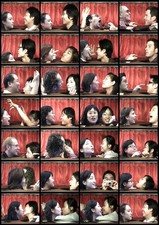
Real-time Interaction in Electronic Media
LIVE WEBCAST OF Disrupting Narratives :: July 13, 2007, 10.00–18.30 :: Tate Modern Starr Auditorium, Bankside, London SE1 :: in collaboration with iRes (Research in Interactive Art & Design) at University College Falmouth :: Concept by Kate Southworth, developed in collaboration with Tate Modern :: Tickets £20 (£12 concessions) booking recommended or call 020 7887 8888.
This international symposium brings together some of the world's leading media artists, theorists and researchers to explore real-time interaction in electronic media. Over the last few years network theories have started to shape our thinking about social and cultural issues. This event seeks out artistic strategies and art forms that engage with these ideas. Contributors include: Mark Amerika, Alexander R Galloway, Andrea Zapp, Kelli Dipple, Kate Rich and Paul Sermon.
Timetable
10:00 Arrival and Registration
10:15 Welcome and Introduction (Kate Southworth)
10:30 Session 1: Counter-Narratives
Mark Amerika: Remixology, Hybridized Processes, and Postproduction Art: A Counternarrative - In this keynote address, artist and theorist Mark Amerika remixes personal narrative, philosophical inquiry, spontaneous theories, and cyberpunk fictions that investigate the emergence of digitally constructed identities, fictional personas, experiential metadata, narrative mythologies, and collaborative networks. Locating what he describes as the "postproduction artist" who engages with D-I-Y networking and alternative distribution schemes to build new models of audience development, Amerika will role-play the contemporary remixologist who is part VJ, part novelist, and part net artist, a made-up character in a book yet written, someone who uses the forms of new media not so much to counter spectacle in the media culture, but to create a counternarrative drift that moves away from the art object per se while investigating the depth of possibilities waiting to be discovered in the creative unconscious.
11:30 Andrea Zapp: For We are Where We are not: Mixed-Reality Narratives and Installations - Andrea Zapp’s practice focuses on room installations in the gallery that are linked to a digital network, mostly through components of surveillance technology. At present she also concentrates on model and miniature aesthetics as a format of expression and narrative architecture; small or shifting scales become another motif to discuss virtual and personal spaces of memory and identity. Life-sized installations like a hut or a hotel room as well as participants are linked to their remote model replicas or online versions – to create surreal stages of viewer involvement that discuss the change of existence in a wired world.
12:15 Kelli Dipple: ... duration, distribution and participation _ the performative-emergent narrative - Focussing on examples of contemporary artists' work, this presentation will observe a notion of performativity in context of cross-platform artistic and curatorial practice. Providing examples of emergent counter-narrative; demonstrated through interaction, participation, interventions and interfaces - that effectively penetrate an exhibition's mode, duration, functionality, and design. Technology is increasingly ubiquitus within all practice, it permeates interpretation, education, exhibition, performance, communication and distribution; it is sometimes therefore, difficult to tell where an artwork begins and ends. The fluid spaces without protocol dominate emergent narratives of New Media that engage both internal and external configurations of the institution. In order to redraw our expectations of what is possible, how are we able to imagine the virtual museum, the distributed museum or the online gallery - are they feasible platforms? How satisfied are we with broadcast and redistribution as primary modes? How do we present New Media Art and make better use of platform-specific versioning in conjunction with social networks, to facilitate more detailed dialogues and provide more satisfyingly responsive cultural architectures?
13:00 Lunch Break
14:00 Session 2 Counter-Protocols
Alexander R Galloway: Counter-Protocol - In this keynote address, Alexander Galloway asks us to imagine an art exhibit of computer viruses. How would one curate such a show? Would the exhibition consist of documentation of known viruses, or of viruses roaming live? Would it be more like an archive or more like a zoo? Perhaps the exhibit would require the coordination of several museums, each with "honey pot" computers, sacrificial lambs offered up as attractor hosts for the contagion. A network would be required, the sole purpose of which would be to reiterate sequences of infection and replication. Now imagine an exhibit of a different sort: a museum exhibit dedicated to epidemics. Again, how would one curate an exhibit of disease? Would it include the actual virulent microbes themselves (in a sort of "microbial menagerie"), in addition to the documentation of epidemics in history? Would the epidemics have to be "historical" in order for them to qualify for exhibition? Or would two entirely different types of institutions be required: a museum of the present versus a museum of the past? In this talk Alexander Galloway explores a "counter-protocol" aesthetic and how it relates to the contemporary landscape of artmaking.
15:05 Paul Sermon: My work in the field of telematic arts explores the emergence of a user-determined narrative by bringing remote participants together in a shared telepresent environment. Through the use of live chroma-keying and videoconferencing technology, two public rooms or installations and their audiences are joined in a virtual duplicate that turns into a mutual, visual space of activity. Linked via an H.323 Internet videoconference connection, this form of immersive interactive exchange can be established between almost any two locations in the world. As an artist I am both designer of the environment and therefore ‘director’ of the narrative, which I determine through the social and political milieu that I choose to play out in these telepresent encounters.
15:50 Tea Break. Tea, coffee and biscuits are served in the Starr Auditorium Foyer
16:15 Kate Rich: Feral Trade (Import-Export) is an artist-run grocery business established in Bristol, 2003. The process is called Feral Trade to distinguish it from other methods such as Fair or Free. Feral Trade forges new, wild trade routes across hybrid territories of business, art and social interaction. Goods are run along social routes, avoiding official channels of grocery distribution in preference for a hand-carried cargo system, often using other artists or curators as mules. This distribution infrastructure is modelled on the 'store and forward' protocol of email, and proposes the surplus freight potential of networked social and cultural movements as a viable alternative to regular freight services (white van, supermarket lorry, Parcelforce, DHL).
17:05 Panel Discussion
17:50 Closing Remarks (Kate Southworth)
18:00 Drinks Reception. Drinks are served in the East Room on Level 7
Mark Amerika has been named a "Time Magazine 100 Innovator" and has had four retrospectives of his digital art work. In spring 2000, GRAMMATRON was selected as one of the first works of Internet Art to be exhibited in the prestigious Whitney Biennial of American Art. His most recent book, META/DATA: A Digital Poetics, was just published by The MIT Press. A Professor of Art and Art History at the University of Colorado, Amerika's practice-based research methods have been translated into novels, feature-length films, museum installations, and live multimedia performances that integrate experimental music, live writing, and video sampling into the narrative mix.
Kelli Dipple is the Webcasting Curator for Tate, working across Tate Media, Performance and Adult Education programmes. Her role is to oversee live event broadcasts, curate a context for the development of Tate's Net Art commissions and to curate performances For Tate Modern's Long Weekend. Kelli trained in theatre directing and choreography at the Queensland University of Technology in Australia and has worked for over a decade at the intersection of new media and performance practice, specializing in the integration of visual, interactive, communication and network technologies. Previous to working for Tate, Kelli curated and produced digital media and performance programmes for Site Gallery in Sheffield. She also continues her own performative research, which has taken the form of site-specific and interactive performance, software development, personal data exchange and multi-screen or single-channel broadcast. For the past twelve years she has worked in the area of live cinematic and networked events. Undertaking artist residencies and projects in conjunction with Virtual Platform (NL), PVA (UK), Montevideo (NL), Steim (NL), Interaktions Labor (Germany), The University of Manchester (UK) and The University of Florida (USA). She has also worked and collaborated extensively with artist-lead groups in the UK including NODE.London, Active Ingredient, Future Physical, Resonance FM and Furtherfield; as well as with Australian artists, Company in Space, Keith Armstrong and The Transmute Collective.
Alexander R. Galloway is an author and programmer. He is a founding member of the software collective RSG and creator of the data surveillance engine Carnivore. The New York Times recently described his work as "conceptually sharp, visually compelling and completely attuned to the political moment." Galloway is the author of Protocol: How Control Exists After Decentralization (MIT, 2004), Gaming: Essays on Algorithmic Culture (Minnesota, 2006), and a new book coauthored with Eugene Thacker called The Exploit: A Theory of Networks (forthcoming). He teaches at New York University.
Kate Rich is an Australian-born artist & trader. In the 1990s she moved to California to work as radio engineer with the Bureau of Inverse Technology (BIT), an international agency producing an array of critical information products including economic and ecologic indices, event-triggered webcam networks, and animal operated emergency broadcast devices. The Bureau's work has been exhibited broadly in academic, scientific and museum contexts. Restless at the turn of the century, she headed further east to take up the post of Bar Manager at the Cube Microplex, Bristol UK; where she launched Feral Trade, a public experiment trading goods over social networks. She is currently moving deeper into the infrastructure of cultural economy, developing protocols to define and manage amenities of hospitality, mobility, catering, sports and survival in the cultural realm.
Paul Sermon is Professor of Creative Technology and leader of the Creative Technology Research Group in the Adelphi Research Institute for Creative Arts and Sciences, University of Salford. Born in 1966, he received a BA Hons. Fine Art at the Gwent College of Higher Education in 1988 and an MFA at the University of Reading in 1991. He was awarded the Golden Nica for Interactive Arts at the Prix Ars Electronica 1991 in Linz, and the Interactive Media Festival Sparkey Award in Los Angeles in 1994. Paul Sermon was artist-in-residence at the ZKM Center for Art and Media Karlsruhe in 1993; dozent for telematic arts at the HGB Academy of Visual Arts in Leipzig, Germany from 1993 to 1999; and guest professor for performance and environment at the University of Art and Industrial Design in Linz from 1998 to 2000. Since June 2000 he has been based at the University of Salford, where he is researching immersive and expanded telematic environments.
Kate Southworth is an artist and researcher. With Patrick Simons she is a founding member of the art group glorious ninth - producers of distributed artworks, DIY installations and invisible networks. Current experiments into co-poietic relationships between code and ritual find form as aural-visual works, installations, performative presentations and texts, and expose their ongoing aesthetic and political attempts to evade systems of control. Recent works, such as November and love_potion, use magic, tactical gardening and social networks to recover knowledge of herbs and healing from commercial control and to share it as common knowledge. glorious ninth’s work has been exhibited in academic, gallery and online contexts. Kate received BA (Hons) in Fine Art and an MSc in Multimedia Systems. She has taught Media Art subjects at Universities in London, Dublin and Cornwall. Currently she is leader of the iRes Research Group in Interactive Art & Design at University College Falmouth where, for the last five years, she has been Course Leader of MA Interactive Art & Design.
Andrea Zapp was born in Germany and has a background in film and TV studies and creates disorientating digital platforms mixing real, virtual and online spaces, combined with surveillance interfaces and technology. She has edited two books, Networked Narrative Environments as imaginary spaces of being, MMU/FACT Liverpool, 2004; and New Screen Media, Cinema/Art / Narrative, BFI, London/ ZKM, Karlsruhe, 2002, (with Martin Rieser). She curated StoryRooms, an international Exhibition on Networking and Media Art that took place at The Museum of Science and Industry in Manchester, from October 05 to January 06. She has lectured widely internationally; her art works have been shown at Siggraph 06 Boston, Ars Electronica Linz; ISEA Liverpool and Paris; Pittsburgh Center for the Arts; Festival of Visions Hong Kong - Berlin, Media Forum Moscow, Austrian Photo Triennial Graz, Museum of Image and Sound Sao Paulo; Machida City Museum of Graphic Arts Tokyo; Kunstverein Stuttgart, Intern. Art Fair Madrid, Film Festival Rotterdam; and at conferences including the Biennale of Electronic Arts Perth, Australia; Siggraph Los Angeles, ISEA 02 Nagoya; Muestra Euroamericana de Video y Arte Digital, Buenos Aires. In 2005 she was appointed Senior Lecturer and Route Leader for the MA Media Arts at Manchester Metropolitan University.
Posted by jo at 02:27 PM | Comments (0)
Igor Stromajer presents Ballettikka Internettikka
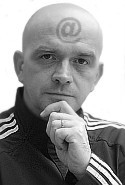
Valencia, Spain
Igor Stromajer presents Ballettikka Internettikka :: June 14, 18:30 :: Sala Parpalls, New Media Room, Carrer Alboraia 5, Valencia, Spain.
Igor Stromajer's Internet oeuvre is characterized by the substitution of the traditional theatre space by the use of the Internet for his intimate performance.
[ . . .] "Ballettikka Internettikka" realized by net.artist Igor Stromajer and net.composer Brane Zorman is an internet guerrilla performance. Differently from other net.art works by Stromajer, which are confined to fixed spaces on the Net, accessible from infinite co-ordinate combinations of time, place, and space, "Ballettikka Internettikka" combines the Internet based ubication with the artist's placement in an offline scenario (corporeally speaking), so the intervention takes place both online and offline, conceived as a complimentary effect. [ . . .]
This Internet situationist performance is a critique of elitist and bourgeois art spaces and consumer art culture and capitalism, by claiming public art spaces. This is achieved by entering secondary locations of established art institutions and then broadcasting the action via the Internet, taking advantage of the whole new scope that the Internet offers: a higher bandwidth, a complimentary effect to off-line activism, omni-directionality, and participation.
Posted by jo at 12:13 PM | Comments (0)
SWITCH, Issue 23
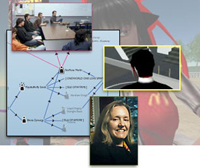
FUNCTION // BORDER // DYSFUNCTION
SWITCH: The online New Media Art Journal of the CADRE Laboratory for New Media at San Jose State University is pleased to announce the launch of Issue 23: FUNCTION // BORDER // DYSFUNCTION.
After 2 solid years of work leading up to ISEA2006 and the ZeroOne Festival, CADRE and SWITCH have been considering new agendas, strategies and opportunities. Over the last several months, the CADRE Laboratory has engaged in a diverse set of activities. We have explored issues such as failure (its lessons and its utility), borders (real / virtual, body / technology, open / closed), and in what direction "new" media may be going. Issue 23 highlights the diversity of these activities, which we have grouped under the rubric of "Function / Border / Dysfunction". Among other things, we have interviews with Michael Joaquin Grey, Saskia Sassen and Lu Jie. Cultural theorist / art historian Dore Bowen explores "The Function of Dysfunction" in her article on Fluxus event scores. The CADRE Lab introduces its Speaker Salon Series, it's new artist residency with the Montalvo Arts Center and its collaboration with Ars Virtua in sponsoring the Borders conference in Second Life.
About SWITCH: SWITCH is the new media art journal of the CADRE Laboratory for New Media of the School of Art and Design at San Jose State University. It has been published on the Web since 1995. SWITCH is interested in fostering a critical viewpoint on issues and developments in the multiple crossovers between art and technology. Its main focus in on questioning and analyzing, as well as reporting and discussing these new art forms as they develop, in hopes of encouraging dialogue and possible collaboration with others who are working and considering similar issues. SWITCH aims to critically evaluate developments in art and technology in order to contribute to the formation of alternative viewpoints with the intention of expanding the arena in which new art and technology emerge. SWITCH is overseen by CADRE faculty Joel Slayton and Rachel Beth Egenhoefer.
Posted by jo at 11:58 AM | Comments (0)
Speculative Data and the Creative Imaginary:
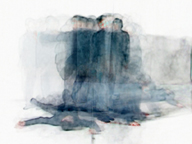
Shared Visions between Art and Technology
Speculative Data and the Creative Imaginary: Shared Visions between Art and Technology :: June 4 - August 24, 2007 :: Opening Event: Wednesday, June 13, 2007 :: Exhibition Viewing - 6:00-8:00 PM :: Performance by Roger Dannenberg :: ACM Creativity and Cognition Panel: Bridging Art and Science with Creativity Support Tools with Rita Colwell (University of Maryland), Sara Diamond (Ontario College of Art and Design), Paul Greenhalgh (Corcoran Gallery of Art), and Dr. William Wulf (National Academy of Engineering) - 8:00 - 9:00 PM :: National Academy of Sciences Rotunda Gallery, 2100 C Street N.W., Washington D.C. :: Curator: Pamela Jennings.
Complementing the ACM Creativity and Cognition Conference themes: cultivating creative minds; sustaining creative communities; and promoting creative engagement, the works in this exhibition illustrate the breadth of creative digital media that impact interdisciplinary practices across the arts, science and technology research.
This exhibition features interactive computer installations, large format digital prints, and wearable technology, representing a confluence of technology research and creativity that include the visual arts, design, architecture, performance, science, technology and engineering. The exhibited works share a common trajectory of exploring speculative inquiries, imaginary scenarios and real-time phenomenon from outer space to cyberspace; multi-dimensional space to urban space; public space to virtually embodied space; ecological space to social space.
This exhibition is dedicated to outgoing National Academy of Engineering President William A. Wulf, in recognition of his many years of support for the arts program at the National Academies in Washington D.C. Contributors to this exhibition include: Nell Breyer, Sheldon Brown, Donna Cox, Roger Dannenberg (opening night), Ernest Edmonds, Tiffany Holmes, Pamela Jennings, Greg Judelman and Maria Lantin, George Legrady, Marcos Novak, Sabrina Raaf, Bill Seaman, Thecla Schiphorst, Christa Sommerer and Laurent Mignonneau, and Martin Wattenberg.
Special Presentation Event at the National Academy of Sciences Gallery Auditorium Thursday, July 12, 2007:
Film Screening of Robert Rauschenberg's - Open Score with special Introduction by producer Julie Martin
Reception: 5:00 PM - 6:00 PM
Film Screening: 6:00 PM - 7:30 PM
In 1966, 10 New York artists worked with 30 engineers and scientists from the Bell Telephone Laboratories to create groundbreaking performances that incorporated new technology. They used video projection, wireless sound transmission, and Doppler sonar -- technologies that are commonplace today but that had never been seen in the art of the 1960s. Julie Martin, producer of the ?9 Evenings? DVD series, will discuss the film series as well as the 1966 event that was the first large-scale collaboration between artists, engineers, and scientists. Open Score is co-produced by E.A.T. and ARTPIX and distributed by Microcinema International.
Press Contact: Alana Quinn, Outreach Manager, Office of Exhibitions and Cultural Programs, National Academy of Sciences (202)-334-2415 aquinn[at]nas.edu
Public Contact: arts@nas.edu (202) 334-2436
Posted by jo at 08:27 AM | Comments (0)
June 08, 2007
Daniel Langlois Foundation
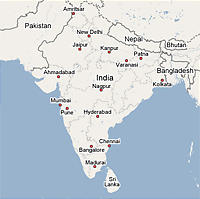
Projects in India
Artist in residence — Vishal Rawlley, Legend of the Sea Lord (2007): Using a creative mix of voicemail technology and mythology, Rawlley developed a prototype for an interactive light installation which seeks to raise public awareness about water pollution in Mumbai.
Artist in residence — Surajit Sarkar, Ring of Blue (2006): Highlighting audio and video recordings collected from the performances of the Catapult Arts Caravan, Sarkar created a low-cost digital technology prototype for an interactive travelling digital exhibition.
Ashok Sukumaran, Recurrencies: across electricity and the urban (2006): This ongoing project (2006-2008) seeks to build some fifty "embedded" electronic arrangements in physical urban spaces, primarily in the cities of Mumbai and Bangalore. More >>
Posted by jo at 05:40 PM | Comments (0)
Four Eyed Monsters - Entire 71 minute Film - (1 week only)
YouTube Hosts First Feature Length Film by Adario Strange, Wired, June 08, 2007 - "YouTube has allowed the independent directing team of Arin Crumley and Susan Buice to be the first ever to post an entire feature length film on the site. The 70-minute film, “Four Eyed Monsters,” premiered at the indie film fest Slam Dance a couple of years ago. While reviews of the film have generally been mixed, the one sure thing about this online event is that it will make Hollywood sit up and take notice..." [Related posts on networked_performance 1, 2]
Posted by jo at 03:37 PM | Comments (0)
Second Life Spaces: Machines
Ars Virtua Artist-in-Residence Brad Kligerman: An in-world exhibition made from interactive hyper-spaces --images, ideograms, models and text-- filling the gallery, an «Image-Space» (rather than a space for images or a space with images).
Images project space, space becomes image, resonating on its surface, through its envelope and beyond its physical reach, to project atmosphere. Avatars merge in image, emerge through image, losing themselves in an image, of art, only to reemerge through it. The colors, lights and forms, the tensions and compressions of the space's force, superpose to project «Image-Space» as its primary atmosphere and not as background noise.
Second Life Spaces: Territories
Reviewed at New World Notes.
Posted by jo at 03:24 PM | Comments (0)
University College Dublin Conference
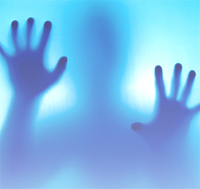
Perspectives on the Body and Embodiment
Perspectives on the Body and Embodiment :: University College Dublin :: Friday June 8-9, 2007 .
Since the investigations of phenomenological theorists such as Husserl, Merleau-Ponty and Heidegger, the themes of embodiment and situatedness have enjoyed increased popularity over a wide range of disciplines, including philosophy, psychology, cognitive science, neuroscience, literature, women's studies among others. Recognition that the body is not merely an appendage to the self, but rather is what opens up the possibility of meaningful subjective existence, has radically shifted the classical philosophical understanding of the body. Within popular culture this shift is reflected with an increased interest in embodiment in realms such as design, architecture, education and business.
This conference aims to explore the themes of the body and embodiment in contemporary discourse inviting papers from a range of disciplines including, but not limited to, philosophy, psychology, cognitive science, performance studies, women's studies and literature. This unique inter-disciplinary perspective will provide a multi-faceted understanding of how Western thinking has changed with understanding the role of the body in constituting or influencing cognition, subjectivity, identity and discourse.
Nathaniel Stern: Implicit Bodies through Explicit Action
This research contends that the body is performed. A body can “act” as a site of emergence, a boundary project, and an incipience. While Rebecca Schneider’s “explicit body” in feminist performance art performatively unfolds (Latin: explicare) and explicates, the implicit body concordantly enfolds (Latin: implicare) and implies. Inter-action is both constitutive of, and always already involved in, the flesh. Like an animated moebius strip, the body feeds back between affection and reflection. This paper attempts to think through digital art as a proscenium for, and framer of, the implicit body.
Nathaniel Stern is an internationally exhibited installation and video artist, net.artist, printmaker and performance poet. He is currently working towards a production- and research-based PhD on interactive art and embodiment at Trinity College, Dublin. Recent works include an article in the Leonardo Journal of, Art Science and Technology, a write-up in NY Arts Magazine, solo exhibitions at Art on Paper gallery (Johannesburg) and the Johannesburg Art Museum, and artist residencies at the iCommons (Croatia), Frans Masereel Centre (Belgium) and the Anderson Ranch (USA).
Posted by jo at 03:12 PM | Comments (0)
Faster than Sound 2007
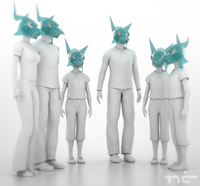
Becoming Animal: Story of the Kerberos
Minimaforms presents: Becoming Animal: Story of the Kerberos @ Faster Than Sound 2007 :: Design Team: Stephen Spyropoulos, Theodore Spyropoulos, and Ivan Safrin.
Becoming Animal is an interactive performance piece that develops the story of the mythical three headed beast Kerberos, guardian of the underworld. The objective is to create an environment of performance through the collective participation and conversation of Kerberos and participants in the event. Each participant’s presence will stimulate the three heads of the Kerberos triggering behavioral interactions and exchanges. Interactions will be expressed through sounds, facial expressions and general activity of the Kerberos. The continued dialogue between users and Kerberos will demonstrate emotions such as love, hate and anger. Participants will be given custom made masks to interact with the Kerberos and each other. This collective playfulness will construct interactions that evolve and become animal.
The project will be installed at the K9 building in Bentwaters Airbase in Suffolk, England. The K9 building will serve as the entrance to this years Faster than Sound Festival. The installation derives its concept from this threshold (entrance to festival), the K9 building and the sound event to create a piece that is context specific.
The Myth of Kerberos (Cerberus): Cerberus was the guardian of the Greek Underworld, and a faithful servant of Hades. He was represented as a grotesque dog that had three heads all of which snarled at those foolish enough to attempt to leave the Underworld; the dog also had the tail of a serpent. According to legend, Cerberus was the result of the union of Echidna and Typhon, two beings that are best described as somewhat monstrous themselves. Additionally, he was the brother to both the Hydra and the Chimera. Cerberus is featured in several mythological stories in his role as the watchdog of Hades. One famous story depicts the poet and singer Orpheus charming Cerberus by the power of his song, which emphasizes Orpheus's magical gifts of enchantment (Cerberus was notorious for not allowing mortals who were still alive to enter the Underworld).
Posted by jo at 02:35 PM | Comments (0)
Nico Vassilakis - Visual Poetry In The Continental Review
Poet Nico Vassilakis in May 2007 presents five short works of video poetry in The Continental Review.
Posted by jo at 11:36 AM | Comments (0)
Plundr
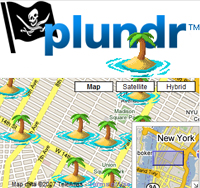
Piracy on the High Seas of NY
Plundr is a location-based game of piracy and trading on the high seas created by area/code. Start out as a bilge-spewing land-lubber in a leaky tub, search the ocean for unsuspecting ships to pillage, upgrade your ship, and amass a fortune in black market goods.
Plundr is designed to be played on laptop computers by players who are navigating through real-world space. The gameplay takes place on Islands where you can buy and sell goods, prey on Merchant Ships, and battle other nearby players. Each Island corresponds to a real-world location. [via]
Posted by jo at 11:30 AM | Comments (0)
glich-gen by DreamAddictive lab
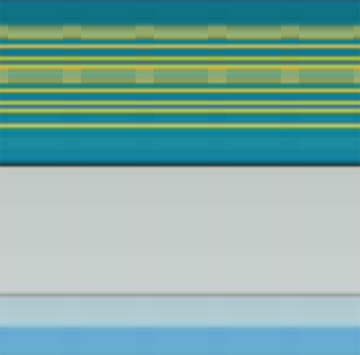
glich-gen by DreamAddictive lab :: Glitch is the digital deconstruction of an image that suffers a rupture in its source code, this rupture is known as a system error. Glich-gen uses a series of errors processed through a source code in actionscript 2 in order to generate computer animations based on image errors.
Posted by jo at 11:19 AM | Comments (0)
June 07, 2007
H2.0: New Minds, New Bodies, New Identities
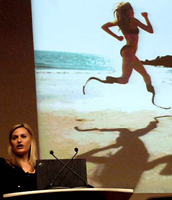
'Hacking the Human'
[Image: Aimee Mullins, a Paralympic athlete and model, showed an image of her running with her 'cheetah legs,' which helped her break world running records.] Creative technology meets quiet humanity in Media Lab's adaptive device event: Mission is 'hacking the human,' says director Frank Moss - by Stephanie Schorow, MIT News Office Correspondent, May 11, 2007. VIDEO -Archived webcasts and presentations.
Forget cool new gadgets or killer-ap software. "We're hacking the human," said Frank Moss, director of MIT's Media Lab, in introducing "H2.0: New Minds, New Bodies, New Identities," the lab's May 9 symposium that showed -- often in mind-blowing detail -- how addressing the challenges posed by disabilities can broaden the scope of human ability.
"The goal of today's symposium is to demonstrate the amazing possibilities in new adaptive technology," as MIT President Susan Hockfield noted.
But "amazing" came with a sense of humor, as provided by MIT Media Lab Distinguished Fellow and veteran TV journalist John Hockenberry, who acted as master of ceremonies and got things rolling by showing off the sparkling lights on his wheelchair.
And tales of the "amazing" were tempered by the quiet humanity of author and neurologist Oliver Sacks, the keynote speaker, who mesmerized his audience with stories of the brain's adaptability.
Hockenberry set the tone by bringing on stage a telephone and a typewriter (which he defined as a "laptop that prints while you type.") The typewriter, he noted, was invented to let the blind write, and telephone inventor Alexander Graham Bell was seeking ways to help the deaf.
What if, he asked, new technology was about more than creating new devices to "dump" on the population? What if it involved thinking about "human mechanisms and abilities?"
"Who knows about that? People with disabilities," Hockenberry said. They "know about that intimate relationship with technology. In a sense, people with disabilities are first adopters of this extreme collaborative quality that's going to define technology in the 21st century."
The 73-year-old Sacks, the author of "Awakenings" (which became a movie starring Robin Williams) and the seminal "The Man Who Mistook His Wife for a Hat," took the stage, the very picture of vitality in black sneakers, black pants and a black T-shirt, his large dome of a head matched by a snowy beard. Yet he acknowledged he has some retinal problems and is keenly interested in new eye research.
Speaking diffidently, in the self-effacing style of a bookish don, Sacks described how Parkinson's patients, frozen into human statues, could be led into dancing and singing with the right stimuli. Perhaps, he speculated, the Media Lab will come up with a device that will provide the right stimulation. But "the most wonderful power resides in music," he said. Music "will facilitate movement and action in a Parkinsonian as nothing can."
Sacks also spoke of "phantom limbs," a phenomenon in which amputees retain sensation in missing limbs. Once thought to be a "nostalgic construct like the memory of departed parents," such sensations represent the brain's ability to map out senses and motor skills, Sacks said. A famous pianist who lost his right arm could still create fingering on a new piece for students.
Citing 19th-century doctor Silas Weir Mitchell, who identified the phenomenon in the Civil War, Sacks noted, "A phantom is longing, as it were, to be re-embodied."
South African poet David Wright lost his hearing at age 9, but he didn't realize he was deaf because he would continue to hear phantom voices, Sacks said. "If they turned away, he couldn't hear them." In the blind, the sensory cortex of the brain becomes hypersensitive, producing experience or images that are "quasi visual," something the rest of us cannot imagine, he said.
Sacks turned from natural to artificial adaptations, describing how a grid of electrodes can be placed on the tongues of the blind and connected to a video camera.
"This sounds absurd, if not obscene, but in fact people who have this can not only rapidly learn to interpret it and derive information, but they can start to experience it as if visual. You don't have to have eyes to have a visual experience."
But "one needs some caution in this brave new world." Sacks also told of "Virgil," a congenitally blind man, contented with his life, who was talked into an operation that would restore his sight. When the bandages were taken off, there was "a long confused silence." The shifting mass of colors and textures meant nothing to him and only worsened his disabilities. Virgil "was never able to make sense of the visual world," Sacks said. "You have to learn to see."
Other speakers described MIT research initiatives for augmenting mental and physical capabilities to improve human life. Many gave deeply personal accounts. Writer Michael Chorost ("Rebuilt: How Becoming Part Computer Made Me More Human") explained -- and showed -- what he could hear with his cochlear implant. Deb Roy, AT&T Career Development Professor of Media Arts and Sciences, who is videotaping every waking moment in his home, demonstrated ways to cull specific information from the "ultra dense" data of recording, including his son's vocal progress from saying "ga-ga" to "water."
During a talk by Hugh Herr, NEC Career Development Professor of Media Arts and Sciences, about breakthroughs in building adaptive gait prostheses, Herr reached down and rolled up his pants leg to show the latest prototype, adding that he often forgets to mention he is an amputee himself. "This is the strongest ankle in the world -- when I walk up steps it pushes me up," he said, provoking an Arnold Schwartzenegger imitation from Hockenberry. (Herr lost his legs in a climbing accident as a teenager.)
Another symposium high point came when Aimee Mullins, a Paralympic athlete and model, strutted on stage with her prosthetic legs tucked into four-inch stiletto heels. Not only does she compete in sports events, often on unusual, curved "cheetah legs," Mullins, a stunning, slender blonde, has modeled her "legs" as fashion accessories. "People say I have no legs, but, in fact, I have 10 pairs," she remarked.
Rosalind Picard, professor of media arts and sciences, demonstrated software that recognizes human emotions (which may help those with autism), while Cynthia Breazeal, LG Career Development Professor of Media Arts and Sciences, introduced the robot Leonardo, which can work through classic "false belief" scenarios.
William J. Mitchell, MIT Design Laboratory director, showed designs for folding electric cars that address both air quality and parking issues. Other experts outlined differing ways to approach neural disorders, from "back entrances" via the nervous system to direct brain interfaces.
The symposium also was punctuated by short films in which Hockenberry -- in deadpan, Stephen Colbert fashion -- visits various MIT luminaries to demand an "upgrade." The clips showed images of MIT's research from robots to voting screens to spray-on clothing.
Famed architect and designer Michael Graves, who suffered a mysterious illness in 2003 that paralyzed his legs, discussed new home product designs, such as adjustable tub rails, easy-grip shower heads and reversible walker/wheelchairs -- all increasingly attractive to an aging baby boomer population, as well as the disabled. "This is a business opportunity," Hockenberry noted. Indeed, "There are things that are simple to do and they don't cost more; you just have to use your mind and your convictions," Graves said.
Receiving a standing ovation was a performance of "My Eagle Song," by Dan Ellsey, who has cerebral palsy, on a computer designed by Tod Machover and Adam Boulanger that allows him to both compose and play.
The symposium ended with a flourish as Herr nimbly scaled a climbing wall erected on stage (he said he had been told he would never climb again) and Hockenberry showed off his "upgrade," a "hacked" Segway wheelchair.
"You see how we're changed. How have you changed?" he asked the audience.
To see the archived webcast of "H2.0: New Minds, New Bodies, New Identities," go to h20.media.mit.edu/.
A version of this article appeared in MIT Tech Talk on May 16, 2007 (download PDF).
Posted by jo at 04:59 PM | Comments (0)
Scratch, Media Lab Video
Scratch is a new programming language that makes it easy to create your own interactive stories, animations, games, music, and art -- and share your creations on the web. Scratch is designed to help young people (ages 8 and up) develop 21st century learning skills. As they create Scratch projects, young people learn important mathematical and computational ideas, while also gaining a deeper understanding of the process of design. Scratch is available free of charge, go to Download. Currently available for Mac OSX and Windows.
Posted by jo at 01:21 PM | Comments (0)
Interview with Susana Mendes Silva
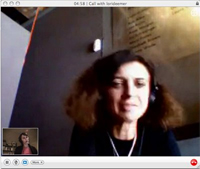
Explorations of 'Constraint'
Interview with Susana Mendes Silva by Miguel Amado; Commissioned by Rhizome.org :: Lisbon-based Susana Mendes Silva is a pioneering artist in the Portuguese new media art scene. Although her practice reaches beyond the conventional genres of this field, her technologically mediated performances, in which she explores the emotional states underlying personal relationships in general and intimacy in particular, granted her a deserved recognition both locally and abroad. She is about to relocate to London, where she will do a studio-based PhD at Goldsmiths College and, recently, she presented the latest installment of her important work ‘art_room’ in the US at Upgrade! International in Oklahoma City. This led Rhizome Curatorial Fellow Miguel Amado to interview her about her practice.
MA: Tell me about your background.
SMS: I have studied Visual Arts in Lisbon’s University and have been showing my work since 1996, being part of what one defines as the generation of Portuguese artists of the mid- to late-1990s.
Recently, I have had a solo show, called ‘Did I hurt you?,’ in the Zoom program (dedicated to cutting edge projects) at Lisbon’s Carlos Carvalho Gallery, and a site-specific installation was commissioned for the group show ‘(Re)Volver’ at Lisbon’s independent space Plataforma Revolver. My practice, however, is not only studio-based, as I participate in several projects that take the form of discussions or talks. For example, I was a participating guest in the ‘Bare Life’ conversation, moderated by Christina McPhee, that took place during July 2006 at Empyre - http://www.subtle.net/empyre - in a collaboration with Documenta 12 Magazine.
MA: What are your interests as an artist?
SMS: My practice addresses the human condition in general and allegorically explores constraint in particular. Constraint can be related to a physical or a psychological condition as well as to an ethical positioning and socio-cultural conditioning. There are also related concepts playing an important role in my work: limit - in its physical and psychological meanings; impossibility - as an imposed boundary (by the self or by others); violence - as a visible or invisible exercise of force; affection - in the sense of a human feeling and of disease, either of the mind or the body; and desire - as a powerful human drive. I am very interested in subverting concepts, rules, and prevailing points of view. I am therefore committed to a critical vision about art and of the world.
MA: You operate in different media, some that one defines as ‘traditional’ (drawing, photography), and other that one calls ‘new’ (video, Internet)...
SMS: I am not very concerned if the media that I employ is seen as old or new, but whether their properties are suitable for my work. I understand media as tool, as something that can be used according to the project that I am developing in a given moment. I use media very freely, and frequently in a grouping manner – for example, in installations and performances. If one considers Lev Manovich’s definitions of cyberculture and new media, some of my works would belong to the first category, some to the second, and others to both.
MA: How do you approach these different media?
SMS: For me, it is fundamental to use media in an experimental way, and to explore specificity, whether site-specificity, media-specificity, or context-specificity. This is a strategy that encompasses and is an attempt to overcome the dichotomy of constraint-freedom that exists in artistic practice. My work is associated with some kind of discovery, mapping, or combinatory method. This is quite present in the way I function and brings together the dimensions of each project.
MA: Can you discuss one of your most well known projects, ‘Artphone’ (2002)?
SMS: In 2002, I applied to be a participating artist of ‘Free Manifesta.’ This was a project by the New York artist Sal Randolph, that was part of Manifesta 4 held in Frankfurt am Main, Germany. A place in Manifesta 4 was purchased by Sal, for $15,099, in an ebay auction. Any artist who wished was invited to show their work, and over 225 artists and groups participated in public art projects which took place across the city as well as through the broadcast airwaves, telephone and mail systems, and on the Internet. I did a performance, via mobile phone, called ‘Artphone.’ There was a flyer and an online page with my personal mobile phone number and the sentence: ‘Don’t be afraid to ask everything you always wanted to know about contemporary art.’ I received the calls and established a completely spontaneous and improvised conversation (about a contemporary art issue) either with someone I knew or with someone I had never met before.
MA: This work led to ‘art_room’ (2005), right?
SMS: Yes, as a development of ‘Artphone,’ I created ‘art_room.’ I used a webcam in a webchat site called webcamnow. In this site there was only the possibility to exchange text messages as the software available did not support voice messaging. The performance occurred during a pre-set schedule, during June. When I started the performance, on the first day, I went to Room One to announce what I was doing by simply posting the sentence: ‘Don’t be afraid to ask everything you always wanted to know about contemporary art.’ I moved to a free room (from 30 rooms, only three had people in them), and I began to chat with some of the people. I soon realized that some of the users felt like they ‘own’ the website (no matter what room I moved into), and they began to become very aggressive towards me. If ones looks at the performance’s documentation, one will only see my eyes, as I was hiding behind my laptop, because some of the users kept saying that I was showing off too much (even though I was properly dressed). In order to avoid the disturbance, I ended up ‘veiled’ by my computer.
MA: The interaction with the user, in ‘art_room,’ was different from that of ‘Artphone’?
SMS: This time the result was totally the opposite from what I expected. Even though there were a couple of interesting chats, the experience of a certain degree of intimacy and significant questions was this time replaced by aggressivity and exclusion from most of the usual members. For example, in the second day I was expelled from the ‘family and friends’ area: my camera was shut down, and I was disconnected as a user by the moderator in an arbitrary way.
MA: Nevertheless, there was another installment of ‘Artphone’ later that year.
SMS: During ‘Prog:me’ in Rio de Janeiro, Brazil I did ‘Artphone’ again yet using Skype this time (still with no image). One of the interesting things was that visitors could talk to me from the exhibition space. This went quite well and it was not very difficult to overcome some shyness or awkwardness. I spoke with people from all ages and from different backgrounds, including some artists and curators. Several visitors saw the show more than once and spoke with me on different occasions. Every time I talked with a person it was a very intimate experience.
Carlos Sansolo (one of the curators of ‘Prog:me’) expressed this ambivalent feeling - of pleasure and fear - very accurately: ‘The Portuguese artist Susana Mendes Silva proposed the ‘Artphone.’ The idea is quite simple: she provides her address so we can talk to her through a microphone and headphones from the computer about contemporary art, using the computer as a telephone. I have talked many times with Susana, never about art, always about technical issues and always presenting one other artist that appeared while talking to her. Actually talking to an unknown person on the phone gives you a certain degree of intimacy that I always felt terrified about. As a matter of fact, I have always felt a certain compulsion to confessing things to this unknown voice. My first thought is always about the history of sexuality of Michel Foucault, about this fear of confessing in intimate moments. She says: ‘Have no fear, ask me what you’ve always wanted to know about contemporary art’ - and all I felt was fear. The simple presence of a voice that talks about contemporary art has the ability to inspire disturbing or great situations for whoever contacts it. One may think it is a reflection on intimacy on the Internet. The work is not only a proposition, but the result of this chat that can never be completely predictable.’
MA: When was the performance done for the last time?
SMS: The last time was at the Upgrade! International in Oklahoma City - as part of the Upgrade! Lisbon’s presentation - and I used Skype with voice and video on both locations. However, a year ago, I tried to do ‘art_room’ in a very different way. I was participating in the exhibition ‘Between word and image,’ at Fundacion Luis Seoane in A Coruna, Spain and, on the opening program, there were some performances. I distributed A4 posters in the museum building announcing that people could meet me in the patio next to the auditorium. I had a table with two chairs (one for me and other for the participant) and I received the visitors that wished to talk with me for two hours. It was very interesting to interact in physical presence, and some of the people started to call it the ‘confessionary’.
MA: Do you plan to reenact this version of the work?
SMS: I always try to do both the ‘Artphone’ and the ‘art_room’ with different components, and this version was an attempt to explore new features for the work, but repeating this performance will depend on the context of its presentation.
MA: What do you think about the passage of the piece from a technologically-mediated context to a face-to-face situation?
SMS: It might sound strange but the situations are not very different. I guess that, on face-to-face, I was a bit nervous because I was not sure if someone would participate. Also, it was more awkward when I was wondering who would be the next person to approach me, perhaps because there was no device separating us.
MA: What are you working on now?
SMS: I am working on my studio and doing research for some projects that will happen later this year. One of them is a group show that will take place within a Lisbon psychiatric hospital, and I am sure that the audience’s reaction will be very different from that of a conventional exhibition space. Next September I will start a studio-based research program at Goldsmiths College in London. I’m very excited with the prospects of this experience, as I will be living and working abroad for the first time and I am sure that this will initiate new directions in my practice.
Posted by jo at 11:04 AM | Comments (0)
Charade
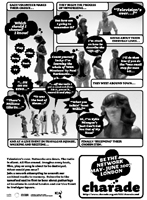
Distributed Performance & Live Event
Charade :: May-June 2007 :: ICA & Trafalgar Square, London, UK :: Television's over. Networks are down. The radio is silent. All files erased. Imagine every book, film, play or song is about to be destroyed. What would you save? Join a network attempting to commit our archived media to memory. Subscribe to the newsfeed and be first to hear about gatherings at locations in central London and our Live Event in Trafalgar Square.
Referencing the final scene of Francois Truffaut's film Fahrenheit 451, Charade imagines a future where our most treasured items from the media are under threat of destruction. When forced to rely on our own memories and bodies for storage and retrieval, how would our relationship to these artifacts change? What new forms of ownership and distribution might emerge?
Volunteers attempt to memorize a chosen piece of music, film, tv programme, play or book; through a process of walking, memorizing, remembering and reciting, they each attempt to 'become' their favourite media asset; over a period of one month they meet at ad hoc gatherings at locations in central London; at a large-scale public event in Trafalgar Square all volunteers congregate to recite their chosen piece while wandering together, en masse – a re-creation of the final scenes of Truffaut's Fahrenheit 451.
Originally commissioned as part of the BBC & Arts Council England's Private View in 2006, Charade is a supported in London by the ICA.
Charade is a new work by Simon Pope and is produced in partnership with Capital Art Projects. [Related]
Posted by jo at 10:47 AM | Comments (0)
June 06, 2007
Brian Eno and the Long Now in Second Life

Advance word comes to 3pointD that the Long Now Foundation (which has to be one of the coolest organizations on the face of the planet) will bring Brian Eno’s art installation, 77 Million Paintings, to the virtual world of Second Life at the end of June, concurrent with the show’s real-world opening. The virtual show is being built out by a startup metaverse services firm known as blueair.tv. For those who don’t know it, the Long Now Foundation is developing the world’s slowest computer, which is meant to “do for thinking about time what the photographs of Earth from space have done for thinking about the environment.” As the site points out, “Such icons reframe the way people think.” The term “long now” was coined by Eno, who, for those who don’t know him, is one of the most influential contemporary musicians around, and also a Long Now board member. Eno has also been more closely involved with things metaversal of late, having hooked up with Will Wright some time back. (And if you don’t know who Will Wright is, you had really better start doing your homework.) No details yet of what the SL opening and build will feature, but if Eno is making an appearance it’s sure to be extra cool. [posted by Mark Wallace on 3pointD]
Posted by jo at 04:48 PM | Comments (0)
xxxxx workshop_15 Berlin: Electric Art Lab with Jeff Mann

Call for Participants
xxxxx workshop_15 Berlin: Electric Art Lab with Jeff Mann :: June 16, 2:00 pm :: Course fee: 15 euros :: RSVP at m[at]1010.co.uk :: xxxxx, pickledfeet, Linienstrasse 54, Berlin 10119 :: U2, Rosa-Luxemburg-Pl.; U8, Rosenthaler Pl. :: Telephone: 3050187482.
Our ancestors believed that ordinary objects could contain energies, spirits, intelligence, and the spark of life. Today, tens of billions of tiny electronic processors permeate our reality, embedded in phones, watches, appliances, toys, cars, factory equipment, and our entire technological infrastructure. In this lab / workshop, we'll look at the microcontroller - the basic element of this distributed network of intelligent objects. These "computers on a chip" are small, inexpensive, simple, and unlike their desktop/laptop cousins, are designed for interaction with the physical world. How can creative individuals use microcontrollers to produce evocative, compelling objects and experiences that go beyond typical mass-produced consumer products?
We'll look at examples and discuss how artists have incorporated embedded processors into sculpture, installation, and performance. We'll compare various microcontroller platforms and, using the open-source Arduino board, we'll experiment with building activated objects that include sensors, processing, and movement. We'll also look at using the microcontroller as a physical interface for audio / video environments like Pure Data, and for remote interaction over the Internet.
The workshop is designed for people of all levels of experience. No equipment is required, but it's recommended to bring as many of the following things as possible:
- Materials to modify, hack, and build objects with. Household items, battery-operated toys, plastic, wood, metal, anything you find interesting. Before the workshop, try to imagine two or three simple ideas you might try to make.
- Laptop with Arduino and Pd software installed.
- Toolbox with cutters, glue gun, screwdrivers, as well as soldering irons, multimeter, etc.
- Microcontrollers - a limited number of Arduino boards will be shared between the participants. You can also purchase your own before the workshop for 27 euros in Berlin at: http://www.segor.de/
- Sensors and Actuators - pushbuttons, photocells, rangefinders, accelerometers; DC, R/C servo, and stepper motors.
- Electronics parts and supplies - a selection of wire, connectors, resistors, capacitors, transistors, chips, and so on.
More details about tools and materials can be found at: http://jeffmann.com/resources.html
About the instructor: Jeff Mann creates electric art with computers, electronics, kinetics, and telecommunications media. His work explores the nature of technological life and its cultural representation; it draws out tensions between notions of utopian industrialism, personal theatre, and the evocative enigma of electronic equipment.
Background: A weekly series of constructivist workshops emphasising making and connection within the field of the existent. Workshops led by field-expert practitioners extend over realms of code and embedded code, environmental code, noise, transmission and reception, and electromysticism. Workshops solely utilise free software and GNU toolbase.
Practitioners include Julian Oliver (http://selectparks.net/), Derek Holzer (http://soundtransit.nl), Jeff Mann (http://jeffmann.com), Martin Howse (http://1010.co.uk), Fredrik Olofsson (http://www.fredrikolofsson.com/), superfactory (http://superfactory.biz).
Further planned workshops will cover PD connectivity and hardware, ATmega8 microcontrollers, free software documentation, VLF reception, radio antenna design, FPGA design...
http://1010.co.uk/xxxxx_research_institute.html
http://1010.co.uk
Posted by jo at 04:17 PM | Comments (0)
De Pong Game
De Pong Game is a recycling of the famous game PONG [Atari 1975-1977]. This new version has been built with Flash [Action Script] by Arjan Westerdiep for Recyclism™ (Benjamin Gaulon).
This project is exploring the concept of Augmented Reality by using and interacting with urban architectures [buildings] as background for the game. Thus the game is projected on a building and the limits of that building are becoming the limits of the game area. The ball projected on the building bounces along the limits of the walls. The software is also using the windows as an obstacles for the game. So the ball is limited to frame of the building. As you touch the ball with the slider, its speed increases and because the ball bounces on all the obstacles of the architecture it becomes more and more difficult to play.
Posted by jo at 11:56 AM | Comments (0)
SELF 2.0 at vertexList
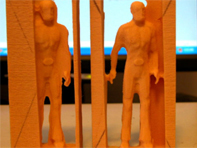
Emerging American Media Artists
VertexList space has the pleasure to present “SELF 2.0”, a group exhibition of emerging US based media artists. On display recent projects by Mike Beradino, Charles Beronio, Zachary Biberstine, Kara Hearn, Jia Lim and Laura Nova. Commenting on the contemporary strategies of electronically mediated self, SELF 2.0 introduces new and exciting voices of artists from across the country.
A reception will take place on Friday, June 15th 2007 from 7pm - 10pm. The exhibition will be on display until Saturday, July 08th, 2007. Live circuit music performance by Jamie Allen/Season of the Bit @ the opening reception. Curated by Marcin Ramocki and Sakurako Shimizu.
Mike Beradino: Mikey Newchurch - My works are physical recursions, between the digital and physical. These recursions are similar a feed back loop such as a microphone next to a speaker. The speaker output signal becomes the input of the microphone and so on and so on.
An object is created then digitized then produced then digitized then produced. Environments such as SecondLife are populated with objects from real life, but our real life objects probably originated in some digital environment. These two pieces are re-presentations of the hollow vessel of the digital avatar. Mikey Newchurch is re-presented from a CNC mill in a series; which is an attempt of giving some physicality to my virtual body. While Mica Sicling is produce in at life sized scale in paper. An indexical relationship of re-presentation of the avatar is created, the original data that is used to create the virtual is used to create the tangible. That is why I included the process of production.
Mike Beradino’s work addresses issues involving the appropriation of digital environments, antiquated technologies, and Internet based do-it-yourself communities. He is particularly interested in the dissemination of 3-dimensional digital environments such as the video games, within our culture. Mike showed his work at Alterspace (Chicago) and online (Aho Museum, Second Life). He is currently working on his MFA degree at Parsons.
Charles Beronio: Untitled (Pretty Vacant) - Vinyl banner with applied vinyl lettering and grommets, 4' x 15', 2006 :: Charles Beronio (b. New York City) lives and works in Oakland/San Francisco and Brooklyn. He completed his MFA in Sculpture at the California College of the Arts (2005), where he is currently developing his thesis on the aesthetics of supermarkets for his MA in Visual Criticism. As an artist and writer, his practice includes a diverse range of work steeped in romantic conceptualism and allegorical formalism. His work utilizes a diverse range of familiar and common materials found in the marketplace and constructed landscape to reveal submerged meanings and narratives– challenging the trajectories of ideology and commerce. He has shown at Galeria de la Raza, Intersection for the Arts, Southern Exposure, Triple Base, Queens Nails Annex, and the S.F. Art Commission in San Francisco, as well as Gallery Lui Velazquez (Tijuana, Mexico), High Energy Constructs (Los Angeles), and Pulliam Deffenbaugh Gallery (Portland). He was included in Consume/d: Creative Critical Acts from the Bay Area (2005) in Tbilisi, Republic of Georgia. In 2006 he curated Material World at the Alliance Francais San Francisco and staged the collaborative exhibition Blackout with artist Sasha Dela at Diverseworks, Houston. He will also be included in New American Talent 22 at Arthouse in Austin, Texas. He has published several design related articles in CMYK magazine (New York) and his forthcoming magazine/book project Dark Prospects will be published by Printed Matter Inc. later this year.
Zachary Biberstine: flag - This 2006 video performance begins with the unfurling of the American flag and ends with the gasping for breath. This attempted embodiment, although painful and enduring, was an effort to understand and progress. The performance attempts to not only share this experience, but also evoke the experiences of others; create a connection on a visual, audible, and memory level.
Currently working in personal, time based performance; the work of Zachary Biberstine takes many shapes. Interested in experience and embodiment, his recent work lives in and through performative acts, sometimes shown as artifacts or documentation. His work deals with ideas of experience, embodiment, displacement, expansion, and collapse.
Kara Hearn: Reincarnated scenes - These scenes are my effort to degrade and venerate the heroics of Hollywood movies. By utilizing the echniques of cinema in the simplest possible ways I hope to recreate narratives that are stripped of everything but the pathos inherent in the medium.
Kara Hearn is an interdisciplinary video artist. She works with the stuff of popular entertainment to map the complexities of various emotional states, such as fear, melancholy, courage, and obsession. She studies these conditions and builds intimate and absurd narratives to understand them by. Her work has shown at White Columns, Pacific Film Archive, New Langton Arts, the Walker Art Center, Dallas Video Festival, and the Festival Tous Courts International Festival of Cinema. She recently received an MFA in Art Practice at the University of California, Berkeley.
Jia Lim: Avatar Duet- Home Spring - 3 D animation, sound, single channel installation :: It all started with my curiosity about the human mind, conscious and unconscious. After reading Elegant Universe, my curiosities were somewhat solved. It was then that I realized that science and philosophy have the same value system as the artistic process, which is creation originates from the imagination or unconsciousness.
Jia Lim is a Korean – American new media artist involved in analysis of identity in pop-culture. Her work was exhibited in Gwang-ju Bienale, Gallery 24 (NYC) and Gallery Andante (Seoul). She holds and MFA in Electronic Arts from the University of Cincinnati and M.P.S in Interactive Telecommunication Program (NYU).
Laura Nova: First Love - I will provide the opportunity for participants to reconstruct memories of their “First Love” using a facial composite software. Images of reconstructed faces will become a part of the installation.
Laura Nova was born in 1973 and grew up in West Hartford, Connecticut. Lives and works on the Lower East Side, New York. Laura Nova is a visual artist working in video, sculpture and installation. Her work is rooted in social relationships and literalized emotions. Using the gallery and site-specific spaces, she creates installations using a wide range of media to explore concepts of public and private behavior and the relationship between the human body and architecture. She received her B.F.A. and B.A. in art and history from Cornell University in 1996 and an M.F.A. from The School of the Art Institute of Chicago in 2001 as a Jacob Javits Fellow. She lived and worked in London as a Rotary International Scholar and completed Associate Research at Goldsmiths College in 2002. She has exhibited internationally, most recently at the Bronx Museum of the Arts in New York City and VTO Gallery in London. For the past year she participated in the Henry Street Settlement Artist in Residence Program. She has taught at City College, School of Visual Arts, Pratt Institute, The College of New Jersey and The School of the Art Institute of Chicago. /
Jamie Allen makes interactive art and sound makers with his head and hands. He thinks technology can allow us to circumvent and reinvent traditional, commercial and hierarchical relationships to art and performance. His work in design, music, performance and public art creates physical relationships between people and media. Jamie has teaching engagements in interactive art and robotics at the Pratt Institute and musical interface design at NYU's Interactive Telecommunications Department. Jamie's art and performance work is regularly exhibited in New York City and abroad.
Michael J. Horan is a musician and artist based in New York City.
VertexList gallery hours are Friday, Saturday, Sunday 2pm - 6 pm, or by appointment. We are located between Graham and Manhattan Avenues on Bayard St. For more info please visit our website www.vertexlist.net or call 646 258 3792.
Posted by jo at 10:50 AM | Comments (0)
Blogged
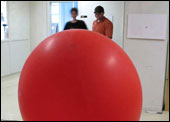
the bubble inflated by blog traffic
Is 'blog' the new 'bubble', ready to blow out? According to the metaphor used in Blogged, an interactive installation by Bill Shackelford the answer is: yes. This piece of 'web 2.0 art' consists of red balloon (a bit less than 2 meters large) blown up using traffic generated by linking blogs during a specific day. Like in a flash mob, Shackelford uses the efficiency of communicating information on the net, exploiting online communities to spread the word and so determining the event success.
The installation was opened on Thursday May 31, 2007, live from the Ohio State University Art and Technology show 'Digescape'. During this 24 hours event Shackelford submitted his link for consideration to a number of blogs, hoping that they would have blogged it including a link back to the Blogged home page. Each visit logged in a MYSQL database, counted one second of compressor-generated air inflation into the balloon. Visitors joined and monitored the balloon status through a live video feed. Schakelford explains that he's concerned to understand the way things actually are, to determine what is valid and important: "The questions that I find most interesting deal with our place in the natural world and how it has changed over time with technology, invention and human ingenuity". 'Blogged' shows clearly how quickly artwork spread from blog to blog and, simultaneously, how fast the artwork is forgotten the day after. It's instantaneous joy what the ranking causes. And however blog is where the debate on net art goes on." - Valentina Culatti, Neural.
Posted by jo at 10:39 AM | Comments (0)
June 05, 2007
FLOSS+Art - Call for Papers

FLOSS+Art :: Call for Papers :: Deadline: September 15th 2007 - people.makeart is a new project by GOTO10. It is a repository of articles and lecture materials focused on the relationship between FLOSS (Free / Libre / Open Source Software) and digital arts, as well as a database of free digital art projects. The selected papers will be published on the people.makeart website and will be printed in the FLOSS+Art book, scheduled for spring 2008, using OpenMute's POD publishing service.
GOTO10 is now accepting new, old and recycled papers on the following issues: - opening digital art's practice, code and culture - FLOSS communities VS. art collectives - digital art licensing, copying and distributing, using open content models - role of the artist in FLOSS development - influence of FLOSS on digital art practices - free software to produce art and the art of producing free software - economy of an open digital artwork - FLOSS as an embedded political message in digital art - paradox and limitations of open licenses for digital art - FLOSS as a way to quote and embed other artworks in a new one - digital artist as a FLOSS developer/user and vice-versa - definitions and manifestos for a free software art - branching and forking of an open digital artwork - opening digital art to ensure future maintainance and porting.
Submission Procedures:
- Submit your final paper to pmafloss-at-goto10-dot-org
no later than September 15th, 2007. Include the text "FLOSS+Art"
followed by your paper's title in your e-mail subject line.
- Submit as many papers as you want, one mail submission for each.
- Accepted formats : plaintext, LaTeX, OpenDocument
No other file format will be accepted.
- The paper must be attached to the mail, do not send us links
- The submitted paper must be written in English
- Paper must be 1500 words minimum
More information: http://people.makeart.goto10.org/
The FLOSS+Art POD publishing is a collaboration between GOTO10 and the Digital Research Unit of the University of Huddersfield, with commissions and contributions from various organisations and institutions.
Posted by jo at 05:03 PM | Comments (0)
Passage Oublié
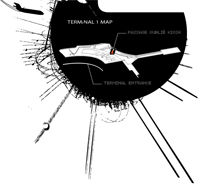
Let's Talk About Rendition Flights
Passage Oublié is an interactive artwork allowing the public to send messages to a touchscreen kiosk located in Toronto Pearson's International Airport. Messages received are animated along flight trajectories on a map featuring airports involved in rendition flights. Passage Oublié invites citizens of the world in transit at Pearson's International Airport to send messages (sms and web) relating to these questions: Are rendition flights an acceptable means of dealing with new terrorism threats? How does their use affect a country’s credibility as a defender of liberty? Does the end justify the means when it comes to pre-emptive war on terror? Are we compromising on the liberal democracies’ cherished principal of innocent-until-proven-guilty?
How to send a message: 416 300-7669 (sms starting July 1st; the airport wireless hotspots provide free access to this URL). All messages will be curated by the artists: Maroussia Lévesque, Jason Lewis, Yannick Assogba and Raed Mousa at Obx laboratory for Experimental Media.
With the support of Year 01, Concordia University, Hexagram.
Posted by jo at 03:56 PM | Comments (0)
Ars Virtua's Second Artist in Residence
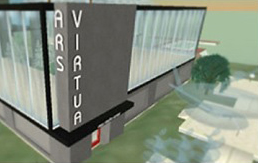
Alana Perlin
Ars Virtua is pleased to announce the appointment of our second artist in residence (AVAIR). Alana Perlin has been selected to work on a project tentatively called Interactive Interiors. Over the coming weeks we will have a reception to welcome Alana and introduce her to the AV community.
AVAIR is an extended performance that examines what it is to be a resident in a place that has no location. The residency is 11 weeks long and will culminate in an exhibit in this new medium. Brad Kligerman's residency is documented here.
“AVAIR” is a 2006-07 commission of New Radio and Performing Arts, Inc., (aka Ether-Ore) for its Turbulence web site. It was made possible with funding from the Jerome Foundation.
Posted by jo at 01:42 PM | Comments (0)
Inter-Arts: Grants: Second Life Artist Residency

Call for Applications
The Australia Council for the Arts is offering up to $20,000 for a collaborative artist residency in the virtual world of Second Life. Application closing date July 27, 2007. The aim of the residency is to offer Australian artists and writers the opportunity to creatively and critically explore new interactive, virtual platforms.
The residency allows for a collaborative team of up to three people (including a writer, musician/sound artist and digital visual media practitioner) to develop inter-disciplinary artwork in Second Life. Applications will only be accepted from teams who fulfil all the residency requirements, including having the necessary artform experience. Artists or writers who have professional experience in more than one of the required artform areas can include this as part of their submission.
Program purpose: The Second Life artist residency is an initiative of the Literature Board, Music Board and Inter-Arts Office of the Australia Council. The residency is ‘in-world’ and requires artists and writers to explore the possibilities of inter-disciplinary literary, music/sound art and digital visual media practices. The successful team will develop new artistic in-world practices and comment on the social and cultural layers that have evolved in Second Life.
Key requirements of the project are a clear strategy for harnessing both in-world and ‘real life’ audiences and developing public exhibition opportunities for the artwork in Australia.
The main objectives of the program are to:
Provide opportunities for artists and writers to develop art that challenges and explores the aesthetic, social, political and cultural realities of Second Life
Encourage collaborations between artists and writers working across literature, music/sound art and digital visual media to develop high quality, experimental arts practices in Second Life. More info here >>
Posted by jo at 10:11 AM | Comments (0)
June 04, 2007
MIXED REALITIES
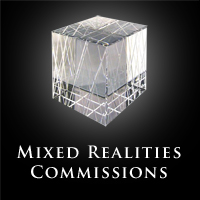
Turbulence Awards Five Commissions
Turbulence Commissions: Mixed Realities :: Venues: Ars Virtua (Second Life); Huret & Spector Gallery (Emerson College, Boston); and Turbulence.org :: With funds from the Andy Warhol Foundation for the Visual Arts.
New Radio and Performing Arts, Inc. is pleased to announce the winners of "Mixed Realities," an international juried competition and exhibition. The five commissioned works ($5,000 each) will be exhibited simultaneously at Ars Virtua (Second Life), Huret & Spector Gallery (Boston), and Turbulence.org in spring 2008. They are:
IMAGING KALININGRAD: THE SEVEN BRIDGES OF KOENIGSBERG by John (Craig) Freeman; REMOTELY COUPLED DEVICES (WORKING TITLE) by Usman Haque, Georg Tremmel and Neill Zero; NO MATTER by Scott Kildall and Victoria Scott; THE VITRUVIAN WORLD by Michael Takeo Magruder, Drew Baker and David Steele; and CATERWAUL by Pierre Proske, with technical assistance from Artem Baguinski and Brigit Lichtenegger.
KALININGRAD AND THE SEVEN BRIDGES OF KOENIGSBERG by John (Craig) Freeman is an extension of Freeman’s "Imaging Place" project; a place-based, immersive, virtual reality project that takes the form of a user navigated, interactive computer program combining panoramic photography, digital video, and three-dimensional technologies to investigate and document situations where the forces of globalization are impacting the lives of individuals in local communities. The famous Swiss mathematician Leonard Euler invented Topology--the key to understanding how networks are formed--in the city of Konigsberg, now Kaliningrad, in 1735. When Euler visited the city, there were seven bridges connecting the city's center to the banks of the Pregel River. A favorite pastime for visitors was to try to solve the puzzle of whether or not a person could walk throughout the city and cross each of the bridges exactly once. Freeman will retrace the imaginary steps of Leonard Euler across these seven bridges. Users will be able to navigate the virtual space as the story of the seven bridges unfolds, as well as the story of how globalization is impacting this remote Russian city. Full proposal.
REMOTELY COUPLED DEVICES by Usman Haque, Georg Tremmel and Neill Zero: This proposal takes as its starting point that the distinction between 'virtual' and 'real' is as quaint as the nineteenth century distinction between 'mind' and 'body'. As such, the spaces of Ars Virtua and Huret & Spector Gallery will be treated equivalently. A device will be constructed for each space which--via the EnvironmentXML framework--will enable people around the world to build remote devices and environments that respond in real time to the local environmental conditions of the two galleries. A Java applet and historical data repository, residing on the Turbulence.org server, will enable the tracking of real time and historical sensory data from the two locations as well as the connections that people make over time. Full proposal.
NO MATTER by Scott Kildall and Victoria Scott: No Matter is an interactive installation that translates the psychology of the Second Life virtual economy into physical space. Virtual economies--where artificial currencies are exchanged in online worlds for dematerialized goods and services--are presently impacting the ‘real’ economy. The leakage of one to another appears on eBay, on the SL Exchange and through virtual land brokers. This mixed economic model overturns established relationships between labor and production. As specialty items can be obtained at a fraction of their real world cost, our perception of the value of objects becomes further obscured. No Matter reflects this conflation of imaginary and real economics by: (1) commissioning the creation of imaginary objects in Second Life; (2) inviting viewers to re-construct these immaterial 3D objects in physical space; (3) paying them Second Life wages; and (4) reselling the replicas on eBay. Full proposal.
THE VITRUVIAN WORLD by Michael Takeo Magruder, Drew Baker and David Steele: In the 1st century BC, Roman writer, architect and engineer Vitruvius authored specific building formulae based on the guiding principles of strength, utility and beauty. For him, architecture is intrinsically linked to nature and is an imitation of cosmic order. The most well-known interpretation of this postulate is the Vitruvian Man by Leonardo da Vinci in which the human form is depicted in unity with the square and circle--representing material and spiritual existence respectively. Given that this tripart union of human body, material form and spiritual essence maintains relevance within the current climate of distributed presence, mixed realities and internet culture, The Vitruvian World will embody the principles of Vitruvius within a contemporary context. Full proposal.
CATERWAUL by Pierre Proske, with technical assistance from Artem Baguinski and Brigit Lichtenegger: When someone screams in real life, do they hear us in virtual reality? Do they want to? The proliferation of networked online worlds has provided a small quota of the human race the option to seek refuge in utopian, less troubled imaginary lands. Rolling synthetic green pastures offer us respite from a planet undergoing exploitation and climate change. For those of us too firmly rooted in this material world to join them, how shall we communicate with them? In what way shall we lament their departure? The essence of Caterwaul is a large, monolithic, dark wall that is represented both in the real and virtual worlds. It is a one-way portal to the virtual world through which people can whisper their thoughts, scream their frustrations and convey regret without the privilege of reply. It is a wailing wall through which to mourn the loss of our humanity to the virtual network. Full proposal.
The competition was juried by Yasmine Abbas, Founder, Neo-Nomad; Michael Frumin, Technical Director Emeritus, Eyebeam; James Morgan, Director, Ars Virtua; Trebor Scholz, Founder, Institute for Distributed Creativity; and Helen Thorington, Co-Director, Turbulence.
Posted by jo at 06:50 PM | Comments (0)
LABworkshops: Modding, Reversing and Intervening in Today’s Gaming Worlds
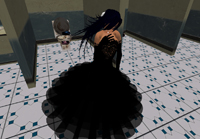
CALL FOR PARTICIPATION
LABworkshops: Modding, Reversing and Intervening in Today’s Gaming Worlds - July 2 – 27, 2007 :: In July LABoral Centre for Art and Creative Industries is organising four workshops exploring the intersections between videogames, art and reality today. A different side of videogames will be revealed by creators who can uncover their codes, subvert the standards imposed by the industry and can even address social and political issues through them. Game hardware and software will be used for performances, activism and critique and participants will have the opportunity to familiarise themselves with the language of videogames and create new meanings and results.
MODDING: An intense workshop tackling the basic notions about modding and editing of Quake III Arena levels with the aid of open source code elements. In order to create fully redistributable games, participants will learn to generate interactive 3D contents for Quake III and to engineer new game features in the game engine’s source code.
Workshop led by: JULIAN OLIVER (NZ) is an artist, educator and media theorist specialising in the development of free software. In 1998 he set up Select Parks, an artistic game development collective.
Dates: 02. – 07. 07.2007
Hours: 10 am – 2 pm & 4 – 7 pm
15 participants, age +18, selected by CV and motivation letter in English
Registration fee: 100 €
Registration: www.laboralcentrodearte.org
Deadline: 15.06.2007
Working language: English
Prior experience in programming and 3D modelling will be valued
BORDERGAMES: The Fiambrera Obrera team will work with digital cameras and image editing, teaching basic levels of 3D modelling as well as some “tricks” and activities related with their software: narrative design and characters, modelling and remodelling of scripts and characters. Participants will be involved in field work in the area of Gijon.
Workshop led by: LA FIAMBRERA OBRERA (ES) is an open group that works in areas charged with a high degree of political and social conflict. Their methods are primarily direct action and intervention.
Dates: 09. – 13.07.2007
Workshop limited to members of Asociación Mar de Niebla
Hours: 12 am – 2 pm & 4 – 8 pm
Working language: Spanish
ENTERING THE TERRITORIES OF SECOND LIFE: Second Life (SL) is an online virtual world currently inhabited by over six million “residents”. This workshop explores SL as a platform for art expression, activism and critique. It will be led by a machinima professional, two media artists and a programmer who work on SL on a practical and theoretical level using it as an ideal platform to share ideas and to perform. Participants will learn through collaborative work how to make machinimas, how to write basic scripts and how to use SL as a platform for social action and artistic expression.
Workshop led by: RICARD GRAS (ESP) is an artist, producer and director of machinima Europe Board. He explores new creative uses for technologies and relationships between art and the media. In 2003, he founded LA-INTERACTIvA, one of the companies that are officially in charge of the development of SL; KRISTIAN LUKIC (SERBIA) is a writer, artist and a cultural and game researcher. He is a program manager in New Media Center – kuda.org and the founder of Eastwood – Real Time Strategy Group and also of Napon - Institute for flexible culture and technologies; ILIAS MARMARAS (GR) is a new media artist and a leading member of the international group Personal Cinema. He has been working in gaming environments and game art since 1999; and YANNIS SCOULIDAS (GR) is a technical director, administrator and programmer of Personal Cinema and specialist in software and hardware.
Dates: 17. – 21.07.2007
Hours: 10 am – 2 pm & 4 – 8 pm
15 participants, age +18, selected by CV and motivation letter in English
Registration fee: 100 €
Registration: www.laboralcentrodearte.org
Deadline: 03.07.2007
Working language: English
Experience in on-line game environments and especially familiarisation with SL will be valued
CHIPTUNES – 8BIt MUSIC: 8bit sound and music is a distinctive feature of early videogames, and has become a seminal contemporary music style utilized by artists and DJs in engaging live audiovisual performances and remixes. This workshop will bring together creators from US and Spain who will work with young people to create music using Gameboys. The workshop will close with an evening of Chiptunes performances with sounds by the artists, the workshop participants and visuals by media artists Entter.
Workshop led by: HAEYOUNG KIM (BUBBLYFISH) (KO) is a sound artist and composer who explores the textures of sounds and their cultural representation. Her work has been presented in art venues, clubs and new media festivals around the world; CHRIS BURKE (GLOMAG) (USA) has been making 8bit music since 2001. He has performed in many countries and his music has played in films, on television and on the Internet. The machinima series “This Spartan Life”, features his music as well as other 8bit artists and is featured in Gameworld; RABATO(ESP) composes music with the famous software Littlesounddj created by Johan Kotlinski for a Nintendo Gameboy consoles. He is the co-founder of microBCN and has participated in festivals and concerts in various cities; YES, ROBOT (ESP) mix Gameboy sounds with other instruments like synthesizes, samples and toys modified by themselves. They are founding members of the 8bit collective microBCN; and ENTTER(ESP) is formed by Raúl Berrueco and Raquel Meyers. Entter was formed to create a collective space for the expression of the common restlessness felt by many creative people in the interactive media art field. Their fields of research include AVperformance, installations, non-linear narrative, videogames, interfaces, experimental music, VJing and net.art.
Dates: 26. – 27.07.2007
Hours: 11 am – 2 pm & 4 – 7 pm
15 participants, age +18, selected by CVand motivation letter
Registration fee: 50 €
Registration: www.laboralcentrodearte.org
Deadline: 16.07.2007
Working language: English and Spanish
Prior basic programming experience and music ability will be valued
Concept and Coordination of workshops:
Daphne Dragona, independent new media arts curator, Athens
Carl Goodman, Deputy Director and Director of Digital Media, Museum of the Moving Image, New York
Activities will take place at the labs and workshops of the LABoral Centre for Art and Creative Industries.
LABoral Centre for Art and Creative Industries is a space for artistic exchange. It is set up with the purpose of establishing an effective alliance between art, design, culture, industry and economic progress and the goal of becoming a space for interaction and dialogue between art, new technologies and industrial creation. It throws a special spotlight in production, creation and research into art concepts still being defined.
LABoral Centre for Art and Creative Industries
Director: Rosina Gómez-Baeza
Universidad Laboral s/n, 33394 Gijón, Asturias – Spain
T. +34 985 185 577 F. +34 985 337 355
labworkshops[at]laboralcentrodearte.org
www.laboralcentrodearte.org
Posted by jo at 05:31 PM | Comments (0)
network by mark dixon
http://www.markdixon.me.uk/network.htm
Posted by jo at 01:17 PM | Comments (0)
SIGGRAPH Unraveled 2007

Call for Proposals
As this year's fashion event, SIGGRAPH will present a living exhibition of fashion, an event combining the fun and glamour of a runway show with the personal engagement of interactive installations. We are looking for fashion design which pushes the boundaries of technology -- computational & conceptual couture & wearables, fashion with a social agenda concerning technology (although may not have embedded technology), and fashion produced using algorithmic fabrication or innovative manufacturing techniques. Because of the exhibition format, it will also be possible to show architectural textile installations, we are also open to submissions in this category.
Like last year, the event will be combined with the chapters party (3000+ tech savvy people in the audience). Here's how it will work: early on in the party, we will announce and present the designers as they enter with models wearing their garments, kind of an informal runway entrance to let the audience know what work is present.
The designer / models pairs will then join the party and interact with attendees, showing and discussing their works, possibly even letting the the attendees try the works on, or if the pieces are too fragile, they can be placed on mannequins; the format and degree of interactivity will be up to the designers. We hope that this format will allow attendees a better way to experience the pieces up close, giving them a chance to understand their depth-- in concept, construction or technical means -- something that can be lost in a traditional runway setting. However, this presentation method still allows the pieces to be shown in action and 'embodied' with live models.
As part of the show, we will be producing a high quality printed catalog which will serve as program for the show and as take away documentation after the show (all designers will receive free copies). The event will also feature professional photography and videography (available for use royalty free after the show) and professional models.
Submitted works should be functional (not concept projects) and able to be withstand some level of demonstration by the time of the show. Designers (or a representative) are expected to appear in person to present their work.
Please submit:
Title of work
Names and email addresses of designers
Brief description (not to exceed one page, one paragraph is fine) Photos (if available, if not, a sketch), Video (if available) Method of Display preferred for party interaction (worn by model, worn by designer, static on mannequin, tried on by audience, etc, can be changed and negotiated closer to event)
Please email your submission as a single PDF (photos embedded) to: amanda[at]media.mit.edu (does not need to be ACM formatted). Video can be sent separately or it can be viewed by us on a website, send the URL
Submission Deadline: June 15, midnight PST: The submissions will be committee reviewed and you will receive a notification by July 1 (at the latest). You may also email with questions before the submission deadline.
SIGGRAPH 2007 will take place in San Diego, CA from August 5-9 2007 (Unraveled event will occur on either Aug 6 or 8, TBD). SIGGRAPH: the premiere international conference on computer graphics and interactive techniques Photos, runway video, project info and curatorial statement on last year's show, Unravel 2006, can be found at: http://www.siggraph.org/s2006/unravel.
Posted by jo at 01:10 PM | Comments (0)
The Vera List Center for Art and Politics
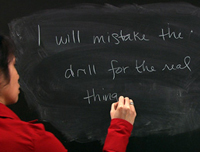
9 Scripts from a Nation at War + Martha Rosler
[Image: “9 Scripts from a Nation at War,” 2007, Video still] The Vera List Center for Art and Politics is pleased to mark a presence at Kassel, Germany, this summer with several works by Martha Rosler, member of the Vera List Center’s Advisory Committee and 9 Scripts from a Nation at War, 2007, a video project by the 2006/2007 Vera List Center Fellows: David Thorne, Katya Sander, Ashley Hunt, Sharon Hayes, Andrea Geyer :: All are to be presented in an international exhibition in the city of Kassel, held from June 16- September 23, 2007.
“9 Scripts” investigates the idea of the individual as defined by and through the expectations and exigencies of society and politics, specifically in the context of the American war in Iraq. Within continuously shifting perspectives, the work is essentially structured around a central question: How does war construct specific positions for individuals to fill, enact, speak from, or resist.
Martha Rosler’s works will include “Kassel Gardens (from the Perspective of a Mole)” (2007), as well as “The Bowery in two inadequate descriptive systems” (1975/76), “Hothouse (Harem)” (c. 1975), and “Flower Fields (Color Field Painting)” (1975). They will be displayed in various venues and parks in Kassel and present views of landscape and the natural world invested with history, beauty, metaphor, and subversion.
“9 Scripts from a Nation at War” was developed, in part, during a Vera List Center Fellowship at The New School, New York, with support from the American Art Foundation, the Danish Arts Foundation and the Swing Space Program of the Lower Manhattan Cultural Council.
The Vera List Center for Art and Politics at The New School advances the discourse on the role of the arts in society and their relationship to the socio-political climate in which they are created. It organizes public programs that respond to pressing social and political issues of our time as articulated by the academic community and visual and performing artists. The center complements the university’s educational mission and brings together scholars and students, the people of New York, and national and international audiences to explore new modes and possibilities for civic engagement.
The Vera List Center for Art and Politics
The New School
66 West 12th Street, room 903
New York, NY 10011
212.229.2436
kuonic[at]newschool.edu
Posted by jo at 01:03 PM | Comments (0)
ENDOSYMBIONT
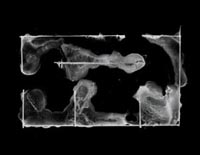
Gallery transformed by Trains/Commuters
ENDOSYMBIONT:: Curated by Dana Moser :: June 7 - July 15 :: Opening Reception: Thursday, June 7, 6-9 p.m. :: Gallery Hours: Wednesday, Thursday 6-9pm, Saturday, 2-5pm, or by appointment :: AXIOM Gallery.
Artists Jake Lee High, Jerel Dye, Sean O’Brien, and Fred Wolflink redefine the AXIOM gallery as an interactive monument. The gallery space is metaphorically transformed into a biological cell that feeds off the sounds and electromagnetic fields of passing MBTA trains. Viewers’ interactions with the interior and exterior of the gallery reshape conditions within the cell, while at the same time, drain the cell’s energy. Through the use of sensors and cameras, pedestrians, as both variable and viewer, affect the cell’s functions- including video, lighting, motors and other electronic instruments. Taking advantage of the unique location of the gallery, and through analysis of people’s daily commutes, the gallery space engages the public and enriches their transit routines.
AXIOM Gallery is located on the ground floor level of the Green Street Subway ("T") station on the Orange line, at the corner of Amory and Green Streets.
Posted by jo at 12:48 PM | Comments (0)
Gustavo Romano at Rostock
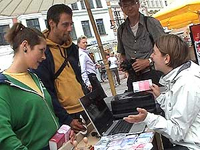
Time Notes: LOST TIME REFUND OFFICE
Participation of Gustavo Romano in ART GOES HEILIGENDAMM; Event in relation with the G8 meeting, curated by Adrienne Goehler :: Time Notes: LOST TIME REFUND OFFICE :: Action, video. :: May 23 - June 9, 2007, Rostock.
The office for the return of the lost time stands as a place for the reception and classification of the time transferred involuntarily, under pressure or for arbitrary reasons, (being employed at not wished job, serving in the army, waiting for the right man or woman, etc). In the mobile office a representative of Time Notes House has taken receipt of the description of how the deponent has lost his time and the officer has restored it with a time note of the corresponding value, the cause of the loss printed at the reverse. A copy has been stored in the Lost Time Data Base.
The action will be completed by June 2 during the great demonstration against the G8 meeting in Rostock with a release of 200 balloons. A bill with the description of the corresponding lost time will be tied to each balloon.
More information, video and images:
http://www.timenoteshouse.org
Time Notes project in the I Singapore Biennale:
http://www.findelmundo.com.ar/timenotes/
Gustavo Romano
www.gustavoromano.com.ar
www.findelmundo.com.ar
Posted by jo at 12:32 PM | Comments (0)
DearCinema Fest 2007
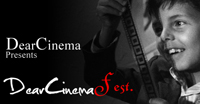
Call for Submissions
DearCinema, an online community of filmmakers and film-lovers is organizing an online film festival, the first DearCinema Fest 2007. Short films made on any format (including mobile phone cameras and web cams) may be submitted. The maximum duration of an entry should be not more than 30 minutes. An eminent jury will select the films for online and offline screening.
Submission closes on June 30th, 2007.
For further details visit: http://DearCinema.com
Posted by jo at 11:58 AM | Comments (0)
The Bush Soul + Emergence
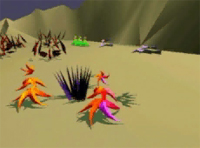
Embodying our Avatars
"We are told that in the not so distant future we will spend hours immersed in three dimensional virtual worlds. These worlds will include "avatars", virtual representations of ourselves in the form of computer generated characters. Our soul, our consciousness, will somehow be embodied in an avatar. The avatar becomes our other body, another container for our spirit.
What is the relationship one has with his or her avatar? Do we control it like a puppet, or is an avatar like a child, containing the spirit of its parents but with its own set of behaviors? What part of "us" is in our avatar? Is part of our soul in this computer generated character?
The psychologist C.A. Meier, equates the soul to our most intimate identity, our conscious ego (Meier 1986). When writing about the localization of consciousness Meier refers to the observations of Mary Kingsley, an ethnologist who lived with West African tribes in the 1890's.
Kingsley stated that the West Africans believe that a person has more than one soul and that there is a certain type of soul, called the "bush soul", that dwells within a wild animal of the bush. A person's bush soul lives inside an animal though that animal also has a life of its own (Kingsley 1899).
An avatar could serve as a place for the bush soul; following the guidance of the person attached to it, but "alive" with is own set of behaviors. I am leading a research project that is exploring the role of the avatar and other issues of aesthetics in cyberspace design. We are building a PC-based system, called "Emergence", that will support an active, responsive, networked, virtual world.
Environments and their inhabitants are rendered in real-time as three dimensional, texture-mapped polygons. The users (called "participants") are represented as avatar models. The virtual inhabitants' unique behavior emerge from a set of parameters. In the case of the avatar, its behavior is combined with input from the participant.
We are experimenting with forms of communication that rely on symbolic gestures, movements and behaviors. Our focus is on motion, the "life" of the environment, and the role of artificial life in the creation of an art form which includes the interactive experience.
Many cultures believe that everything has some form of a soul. We carry this idea into our virtual world where every object is instilled with some form of artificial life. Driven by its internal code or in response to its environment, an object may change its shape and color, make a sound or begin to move.
In our virtual world relationships can be formed between all elements. Movement and interaction enhance the emergence of a rich environment populated by engaging inhabitants. An intriguing place for a traveling bush soul." -- Rebecca Allen
Emergence is a PC-based software system, designed for the creation of interactive art. In this system, three dimensional, computer generated environments and autonomous, animated characters are displayed in real-time. People who enter this world are represented as "avatars".
Through a scripting language one can utilize techniques of Artificial Life to specify behaviors and relationships between characters and objects. This system allows for the creation of muliparticipant virtual worlds that are "alive", responsive and interactive. Complex social environments can evolve from the interaction of simple behaviors.
Additional animation and sounds such as voice, music or ambient effects can be attached to objects and characters in the environment. Activities and events emerge, including performances and non-linear stories and music, depending on the relationships and interactions between the avatar and the artificial life forms.
With this system, we are experimenting with forms of communication that rely on symbolic gestures, movements and behaviors. The focus is on the "life" of the virtual environment. Through the avatar a person enters a world that encourages exploration, participation and the development of relationships.
"Emergence" provides the opportunity to explore the role of artificial life and human presence in the creation of an art form which includes the interactive experience.
Posted by jo at 11:06 AM | Comments (0)
June 2007 on -empyre- soft-skinned space

Constructions of Identity: Performance Life
June 2007 on -empyre- soft-skinned space: "Constructions of identity: performance life" with Barbara Campbell (AU), Jill Magid (US) and Stacia Yeapanis (US). Please join our guests for a month's reflection and debate; subscribe here.
This month on -empyre- will concentrate on the construction of identity among artists who have explored notions of 'feminine' identity at one point or another - especially how it relates to space and landscape. The emphasis of the discussion will focus on the play between 'real' and 'virtual' space, as it is so much a part of the everyday and a powerful tool for artists to promote and create their works. The discussion will also focus on how curators have worked with artists with these concerns.
Barbara Campbell is a performance artist who has worked with the contextual properties of all kinds of sites since 1982. Back then, her sites were physical: galleries, museums, stairways, atriums, piers, to name some. At the moment her performance site is actually a website. "But I don't think this qualifies me as a new media artist. In fact I waited until the internet acquired the patina of age before I became really interested in it, because then it became possible to discern user patterns and the messages of the medium itself. Community, distribution, globalisation, interactivity, citizen-media, were some of those messages, and these are what I'm employing now." Barbara's current project is 1001 nights cast, in which she performs a short text-based work for 1001 consecutive nights. The performance is relayed as a live webcast to anyone, anywhere, who is logged on to http://1001.net.au.
Stacia Laura Yeapanis is an interdisciplinary artist living and working in Chicago, IL. She received her MFA from the Department of Fiber and Material Studies at The School of the Art Institute of Chicago in 2006. Her work can be seen in the Museum of Contemporary Photography's Midwest Photographers Collection and in the Rhizome Artbase. Stacia is an avid Buffy the Vampire Slayer fan and has two wonderful cats, Gertie and Gloria.
Everybody Hurts, a hybrid fansite/conceptual art piece exploring mediated emotion and the fansite as a performance of identity; My Life as a Sim, documentation of this ongoing project on my portfolio site; Commercial-Free: The Museum of TV on DVD, another hybrid fansite/conceptual art piece exploring fandom in relation to museum curation.
Jill Magid: "I seek intimate relationships with impersonal structures. The systems I choose to work with- such as police, secret services, CCTV, and forensic identification, function at a distance, with a wide-angle perspective, equalizing everyone and erasing the individual. I seek the potential softness and intimacy of their technologies, the fallacy of their omniscient point of view, the ways in which they hold memory (yet often cease to remember), their engrained position in society (the cause of their invisibility), their authority, their apparent intangibility and, with all of this, their potential reversibility."
Posted by jo at 08:28 AM | Comments (0)
Stefano Cagol

Public Art Intervention
Stefano Cagol: HEAD FLU :: Venice Tronchetto :: June 5 - July 5, 2007 :: White spheres rise in the sky of the water town - two, big, visible, but at the same time fluctuating, void, suspended. 'Head', and 'Flu', influenza, influence. Head flu, influence of the head seems to entreat a moment of meditation. On the other hand, the word 'Head' detects a balloon, an inflated balloon, an empty pumpkin, which shows the opposite of reasonableness. So the association appears critical, ironical.
As ideal points of suspension, they allow for an open interpretation of the observer, as much as a series of badges virally distributed. This is in fact the other typical tool of propaganda, also used in previous works by Cagol. The badges, with a black writing on a white background like the balloons, through a sequence of associations, show the influences that direct us at the moment: bomb flu, pussy flu, bird flu, art flu, mind flu, techno flu, media flu, beauty flu, ass flu, head flu...
Stefano Cagol's public art intervention Head Flu in Venice faces the concept of – physical and mental, positive and negative – influence on a society in which centers of gravity and orders of value are altered. He succeeds by evoking bubbles and power points through a word game that become all one with the use of modalities typical of propaganda.
This project is part of his recent in-depth research developed during last year with the Bird Flu / Vogelgrippe installation in Auguststrasse at the Berlin Biennale, and with the Power Station satellite intervention at the Singapore Biennale.
Stefano Cagol holds in 2007 a solo show at NADiff - New Art Diffusion, Tokyo, a solo public project at Beurs Schowburg, Brussels, and a solo show at Priska Juschka Fine Art, New York.
He realizes a project together with Stealth.ultd at Kunst Merano Arte for 'Fromandto', and is present at National Museum of Arts of Hanoi for 'Tendencies of contemporary research', at National Gallery of New Delhi for 'The edge of vision', and at New Chinatown Barbershop of Los Angeles for 'LA auction'.
Poletti Foundation is main sponsor of Cornice Art Fair Venice.
Location: The Tronchetto area is the gateway to Venice, accessible by boat or by car. There are also very frequent public transport services from all areas of Venice and from the mainland. A boat shuttle service runs continuously between Cornice Art Fair at Tronchetto and the Biennale.
Private reception (invitation only) June 8, 6.30 p.m., VIP Lounge of Cornice Art Fair Venice.
Info: Mob. +39.348.7081417; info[at]fondazionepoletti.com; http://www.fondazionepoletti.com
Posted by jo at 08:03 AM | Comments (0)
June 01, 2007
UAPD NYC Action: Sign Event
Urban Attractors Private Distractors (UAPD) is a collaborations between Angie Eng, Vietnamese artist, Rich Streitmatter-Tran and a collective of student interns in New York and Ho Chi Minh City. The two groups conduct actions in public centres highlighting private behavior in public space and the invisible boundaries/filters prompted by mobile technologies and urban invasions of one's public space. The next action is 06.09 @ 1pm: 'Street Eat'. All actions meet @ eyebeam.
Posted by jo at 06:15 PM | Comments (0)
UNIQLO MIXPLAY
Go here to mix your own dance and sound.
Posted by jo at 05:47 PM | Comments (0)
Anne Galloway
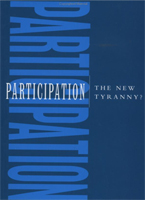
MediaShed +
A COUPLE OF PROJECTS MENTIONED IN ANNE'S POST: Participation: The New Tyranny?, edited by Bill Cooke and Uma Kothari, is about participatory development‘s potential for tyranny, showing how it can lead to the unjust and illegitimate exercise of power. It is the first book-length treatment to address the gulf between the almost universally fashionable rhetoric of participation, which promises empowerment and appropriate development on the one hand, and what actually happens when consultants and activists promote and practise participatory development, on the other.
The contributors, all social scientists and development specialists, come from various disciplines and a wide variety of hands on experience. Their aim is to provide a sharp contrast to the seductive claims of participation, and to warn its advocates of the pitfalls and limitations of participatory development. The book also challenges participatory practitioners and theorists to reassess their own role in promoting a set of practiCes which are at best naïve about questions of power, and at worst serve to systemically reinforce, rather than overthrow, existing inequalities.
For the recipients of participatory development this book provides critical insights into the history, the institutions, and the day to day activities through which participation is done to them. It provides them with a range of arguments which support the legitimate decision not to participate on others‘ terms, and also with grounds to oppose or negotiate the intervention of participatory development in their lives.
Some contributions in this book seek to learn the lessons of particular examples of failed participatory practiCe. Others present more conceptually oriented analyses, many of which go beyond those conventionally associated with development studies. Together they provide a more rigorous and provocative understanding of participatory development than has hitherto been available, which donors, academics and practitioners will find hard to ignore.
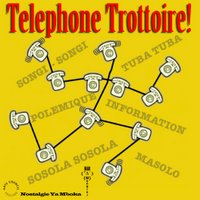
"The aim of the Telephone Trottoire project is to engage the London based Congolese community in issues that affect their day-to-day lives. 'Telephone Trottoire' is based on a new form of 'contagious' telephone application developed by Mongrel and named after the Congolese practice of 'pavement radio' or the passing around of news and gossip between individuals on street corners. In Central Africa people defy media censorship by sharing news and gossip using 'radio trottoire' or 'pavement radio'. Built in collaboration with the radio programmes 'Nostalgie Ya Mboka' and 'Londres Na Biso', 'Telephone Trottoire' encourages London's Congolese community to pass around news stories and discuss them using a unique system of sharing content over the phone. The project engages the Congolese community on their own terms by using systems that draw from their own culture, beliefs and folklore – some stories are intended to provoke, some to entertain and some to educate. All allow listeners to record their own comments and pass the call on to a friend or family member by entering their phone number. Some are true and some are false – after all isn’t this all about gossip – the 'Telephone Trottoire'?"
Posted by jo at 05:11 PM | Comments (0)
Alternate Reality Games or Fiction of the Future?

The Space between me and my Avatar
The virtual world of Second Life got a little bit stranger for me this week. I went over to see Destroy Television the other day at the gallery where she’s hanging out at the moment, and my avatar, Walker Spaight, ended up marrying her! (That’s Destroy’s rock at left.) Now, if you know me and you know my Second Life, this is slightly unusual, since for me there’s very little space between myself and my avatar(s) in the virtual world. I use Second Life as simply an extension of my first life; there’s nothing virtual about it. But here I was role-playing the lovestruck journalist to Destroy’s hard-to-get videographizing vixen. Walker even started a Tumblog about his romance. The formal ceremony was yesterday afternoon (Walker was all nerves — though he didn’t show it), and you can view images of the happy couple together on Destroy’s Flickr stream.
It struck me at some point that what I was doing — along with Annie Ok, who was driving Destroy at the time, and Jerry Paffendorf and Christian Westbrook, who conceived Destroy and brought her to life — was creating a little Alternative Virtual Reality Game, in a way. I don’t write a lot about alternate reality games (ARGs) — i.e., narratives that involve audience participation, which usually have some real-world component, and which often feature a prize or reward at the end — mostly because I don’t really roll with them as a genre.
Things like Perplex City and World Without Oil are very cool, to be sure, and I’ve been fascinated to see how this stuff is developing, but I’ve always found myself rubbed the wrong way by this “alternate reality” moniker. But it wasn’t until I started getting my alternate reality on, via Walker, that I realized why. What’s going on in all these cases looks to me less like “alternate reality” than it does like fiction, and fiction being formulated on the same level as broadcast media like television — i.e., it’s just the same kind of fiction that’s happening in a TV show like Law & Order, for instance, only with the audience involved in writing the story as it goes along. From some angles, it looks like there isn’t any such thing as an alternate reality game at all — there’s only the fiction / narrative / media of the future.
That’s increasingly what it looks like to me. I’m not sure why I get hung up on the semantics — maybe because labels confuse things as often as they clarify. But I increasingly see games and role-playing in virtual worlds as falling under the media rubric. They’re made-up stories that we experience for ourselves, and which we increasingly tell each other, which I think is the important part.
It’s interesting to me to stop and look at the world of games and role-playing in virtual worlds as something that’s often less personal than we think it is. Destroy Television helps illustrate this, since she’s such a good media machine: everything she does is pumped out to the Web and (at the moment) gets archived on Flickr, turning her life into a constant media stream, just as Justin Kan is doing with his life at Justin.tv.
We usually think of games and role-playing as more or less private pastimes: I may be creating my own story in GTA: San Andreas or EVE Online, but even in the massively multiplayer environment of EVE, my story is usually being shared with only a limited number of people. But with the advent of lifecasting — the kind of constant streaming being done by Destroy and Justin — the story I’m creating is available to many more people. To me, this pushes it away from being a personal experience I’m sharing with a few friends, and more toward a performance of the type we’d recognize as media in any other context. It’s still a bit of both, of course, but it’s interesting to see things shift.
Maybe Andy Warhol was wrong. Maybe in the future, we’ll all be famous all the time. [posted by Mark Wallace on 3pointD]
Posted by jo at 04:57 PM | Comments (0)
Upgrade! Berlin

Iliadahomero from Curitiba / Brazil
Upgrade! Berlin presents: Iliadahomero from Curitiba / Brazil :: Friday, June 8th 2007; 8 pm :: Studiobühne, Ritterstrasse 12-14, 10969 Berlin / Germany, U Prinzenstrasse.
Brazilian composer & director Octavio Camargo from Curitiba shows together with Claudete Pereira Jorge an interpretation of the first chant of the Iliade, the epos of Homer. The Iliade is known as the most ancient oeuvre of occidentail literature. The 50-minutes monologue reveals the impact of this text as the source code of European culture. The performance will be in Portuguese, but the underlying semiotics of this piece can be grasped beyond any language restraints. And that's exactly the intention of this play: Homer is used here as a media and a vehicle for interaction in different platforms of language, thus projecting different translations to different idioms.
"I see language as a code" says Octavio Camargo, "and with this dramatic piece, we want to share this code with our audience. I believe that the texts of Homer can provide a deep understanding of the modern human condition." Indeed, the Iliade is a veritable semiotic knot of the European culture and still, after 2500 years, provides a broad array of the most important archetypes and topoi of the occidental thinking.
Interpretation: Claudete Pereira Jorge | Director: Octavio Camargo | Translation: Odorico Mendes
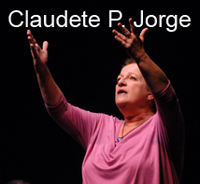
Claudete Pereira Jorge is a popular actress from Brazil, who has been working on many different theatre and film stages for more than 30 years now. Octavio Camargo is a composer and theatre director, and has been teaching Aesthetics and Harmony at the University of Arts in Parana (EMBAP), Brazil, since 1992.
Some Links to Octavios works:
http://organismo.art.br/blog/?p=2026
http://organismo.art.br/blog/?p=2015
http://www.errantbodies.org/camargo.html
http://errantbodies.blogspot.com/
Iliadahomero is currently guest at the Thessaloniki Biennial and will continue its travels throughout different European cities of the Upgrade! network http://theupgrade.net.
Posted by jo at 11:56 AM | Comments (0)
